Carl John Alfred Hammerberg. No. 5148. Trial Transcript. June 1921.
Images
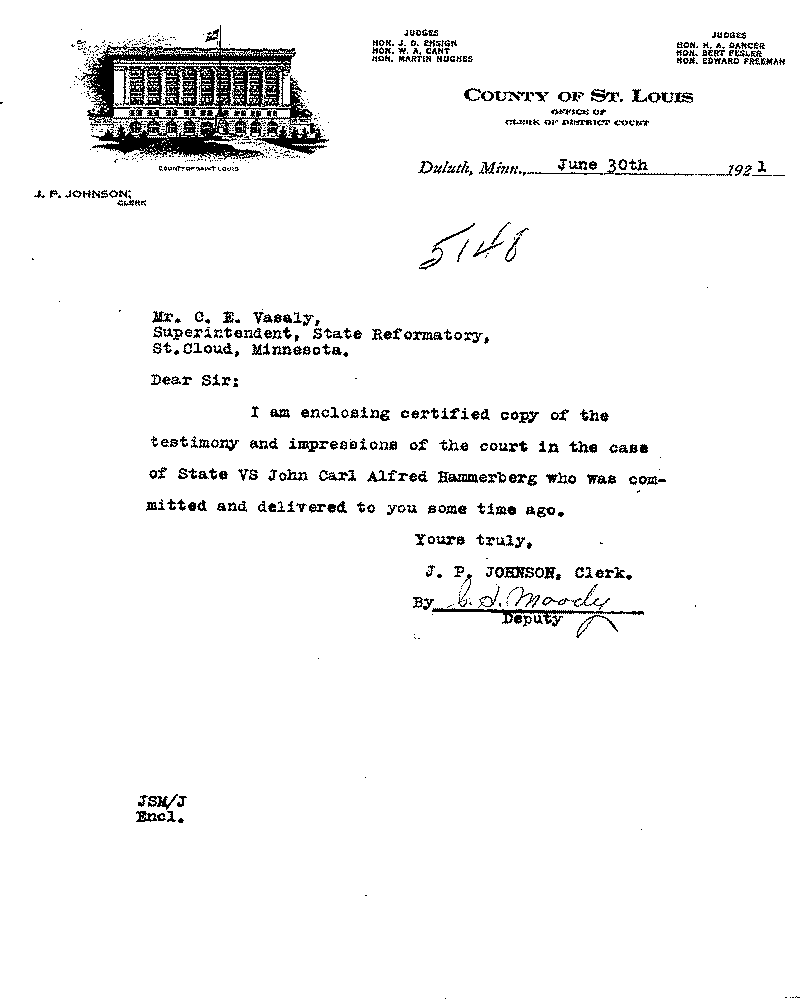
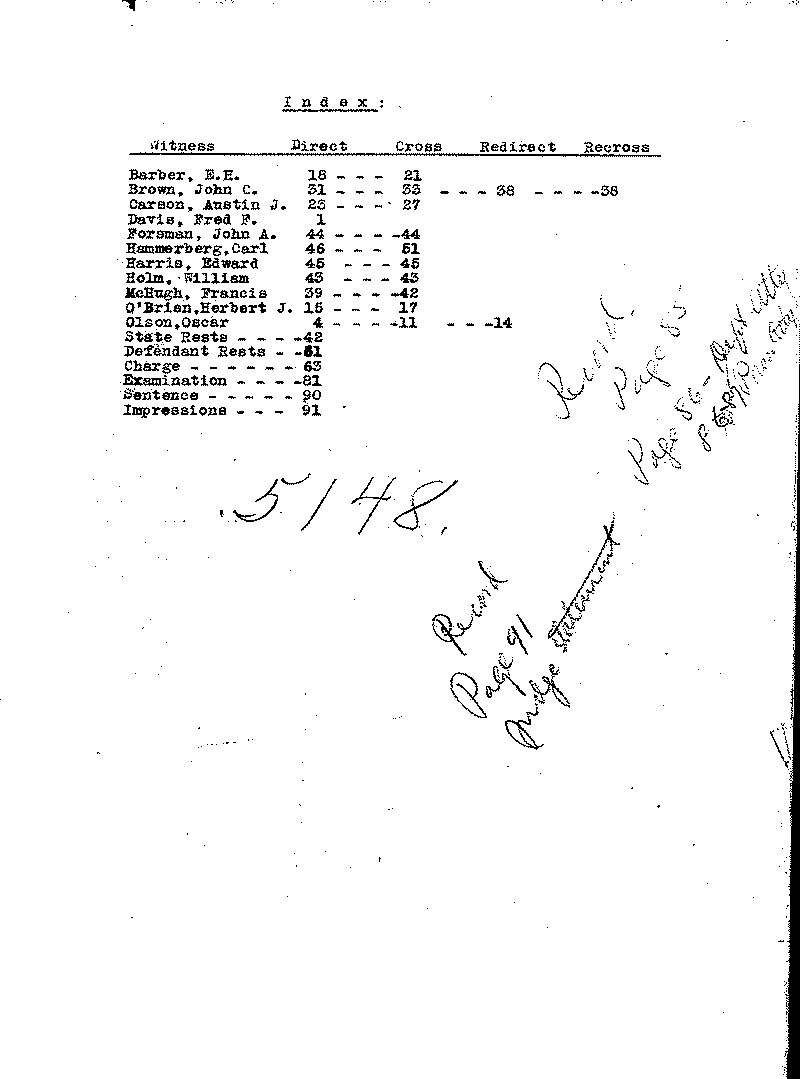
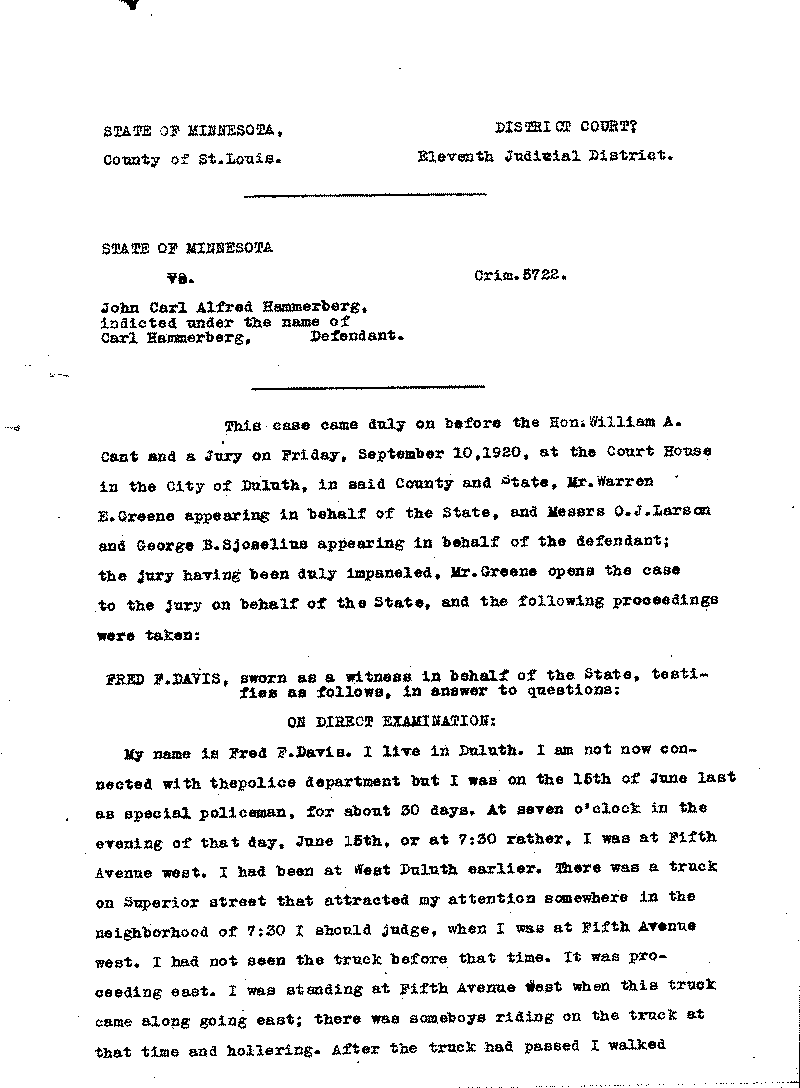
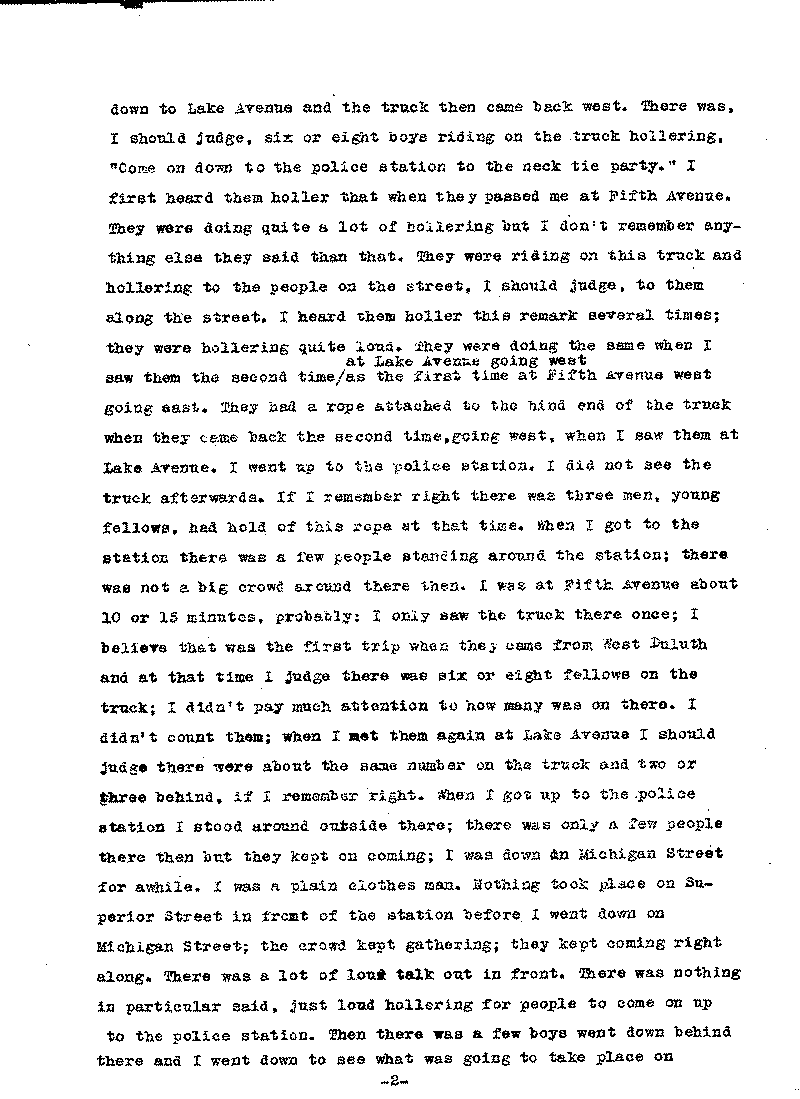
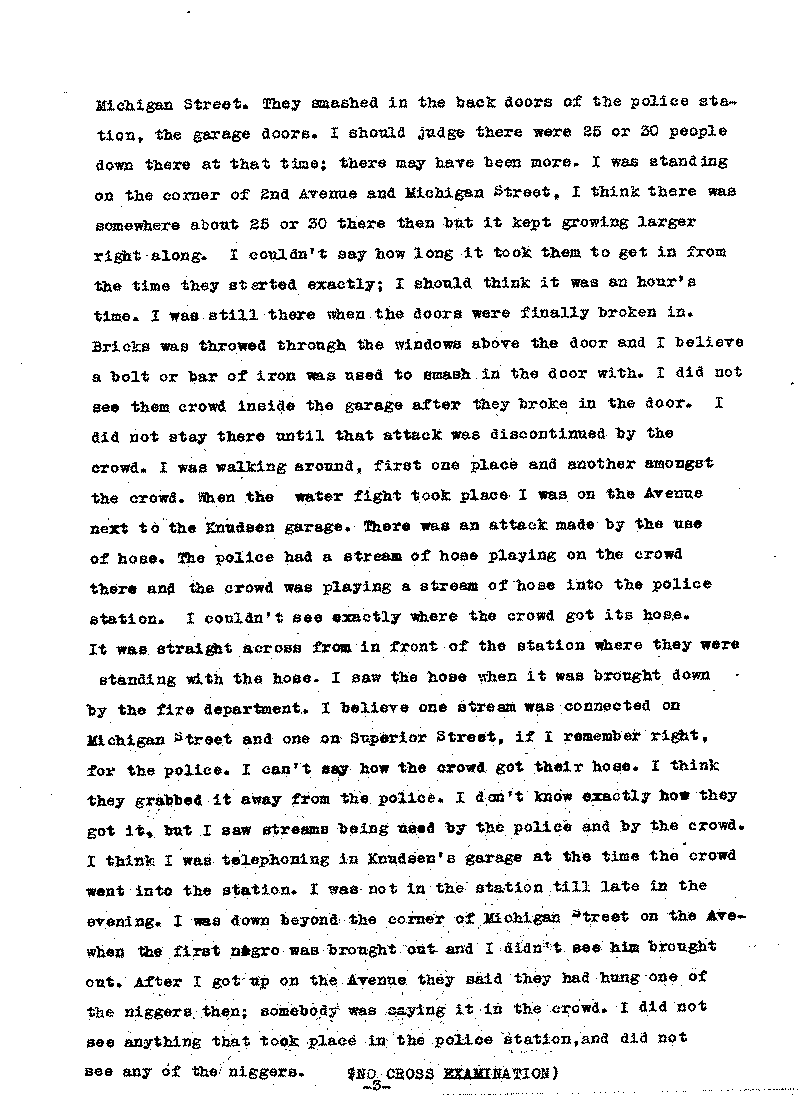
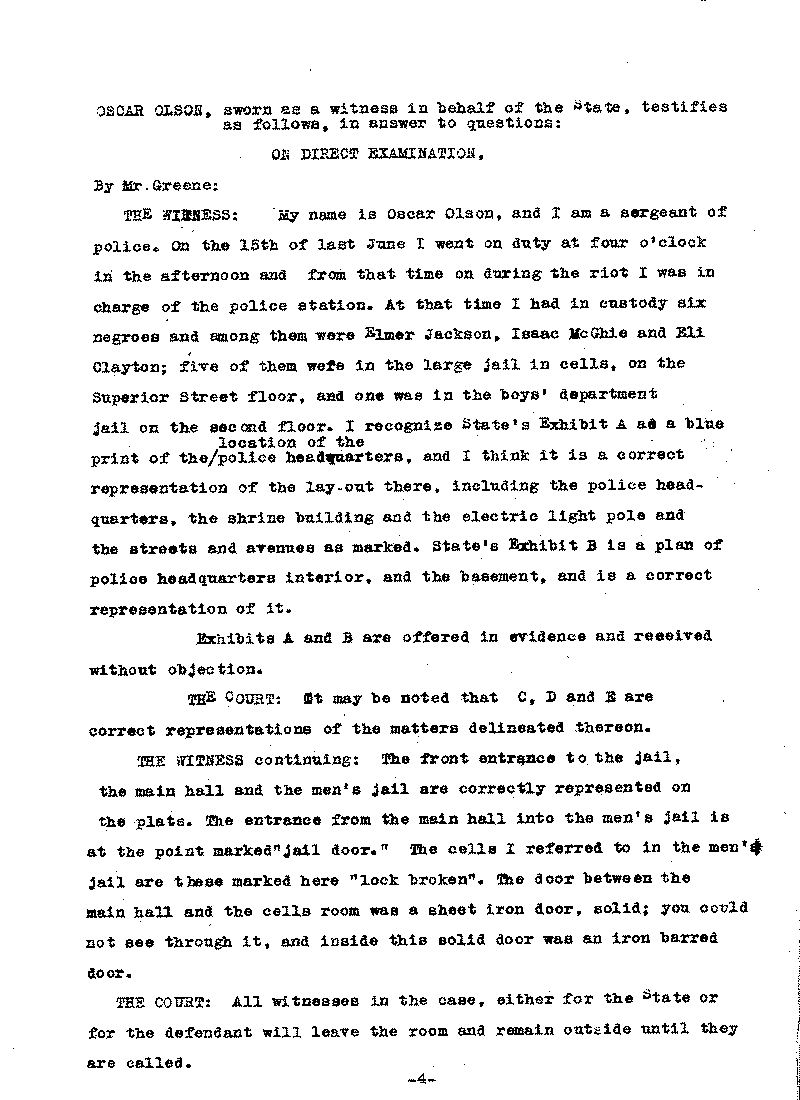
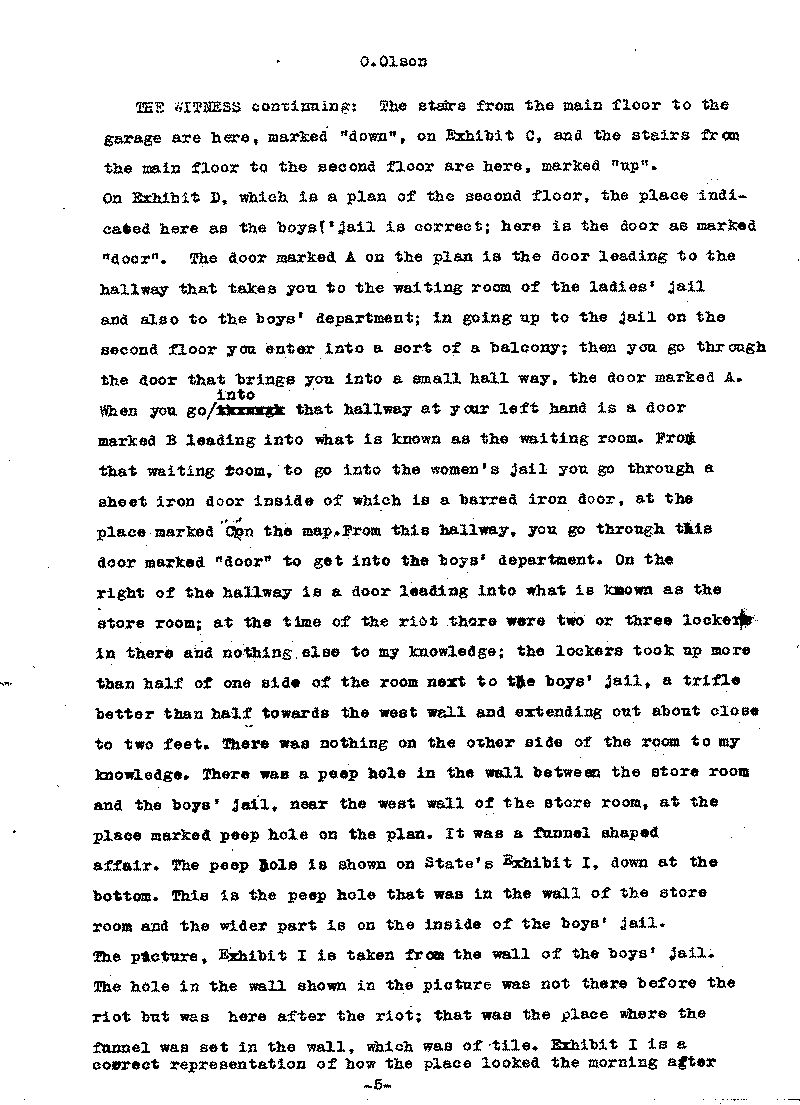
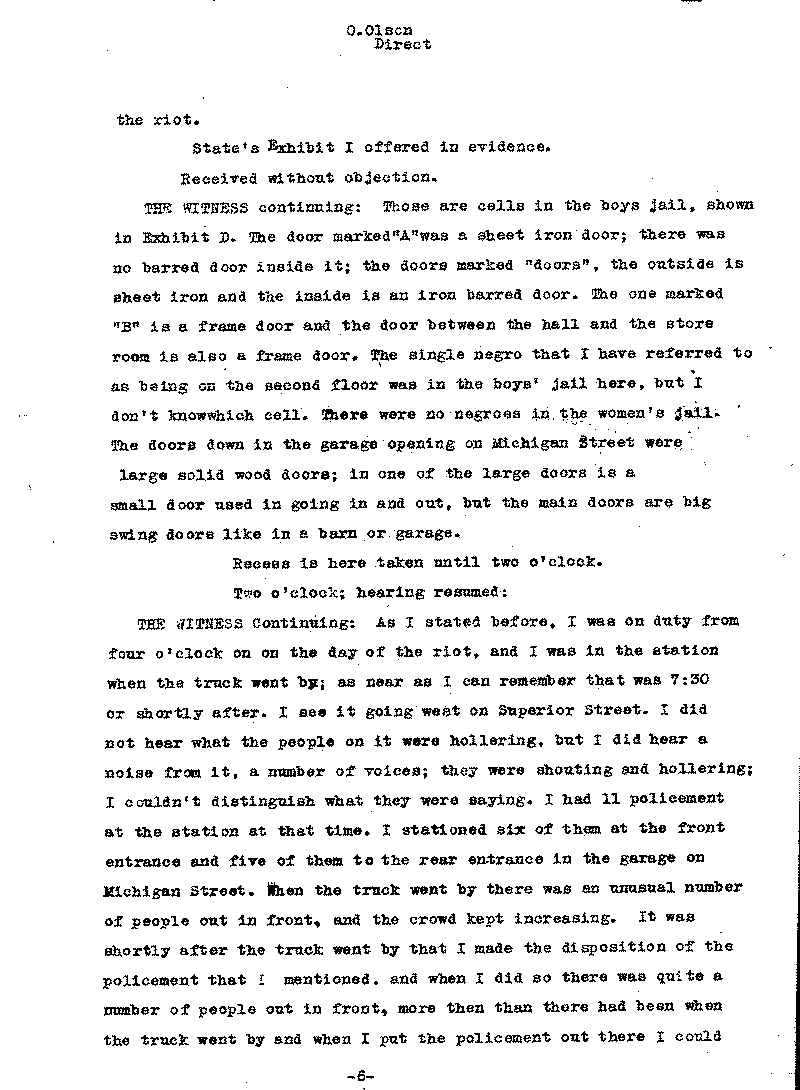
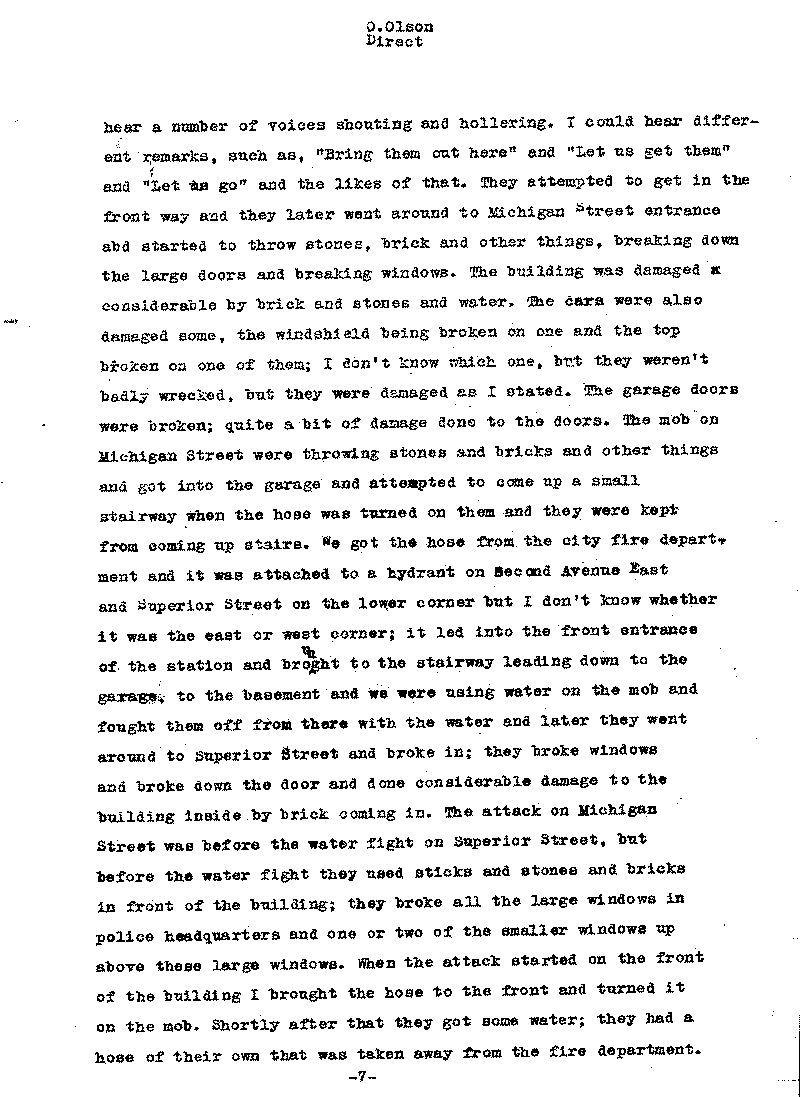
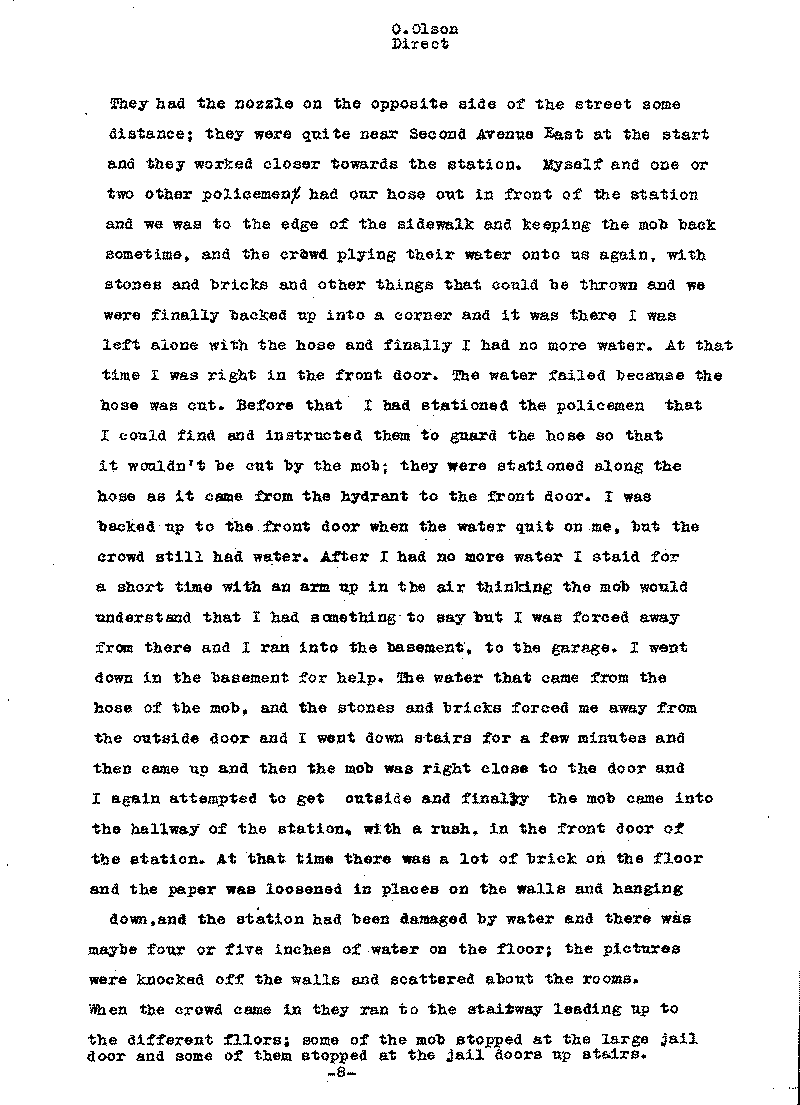
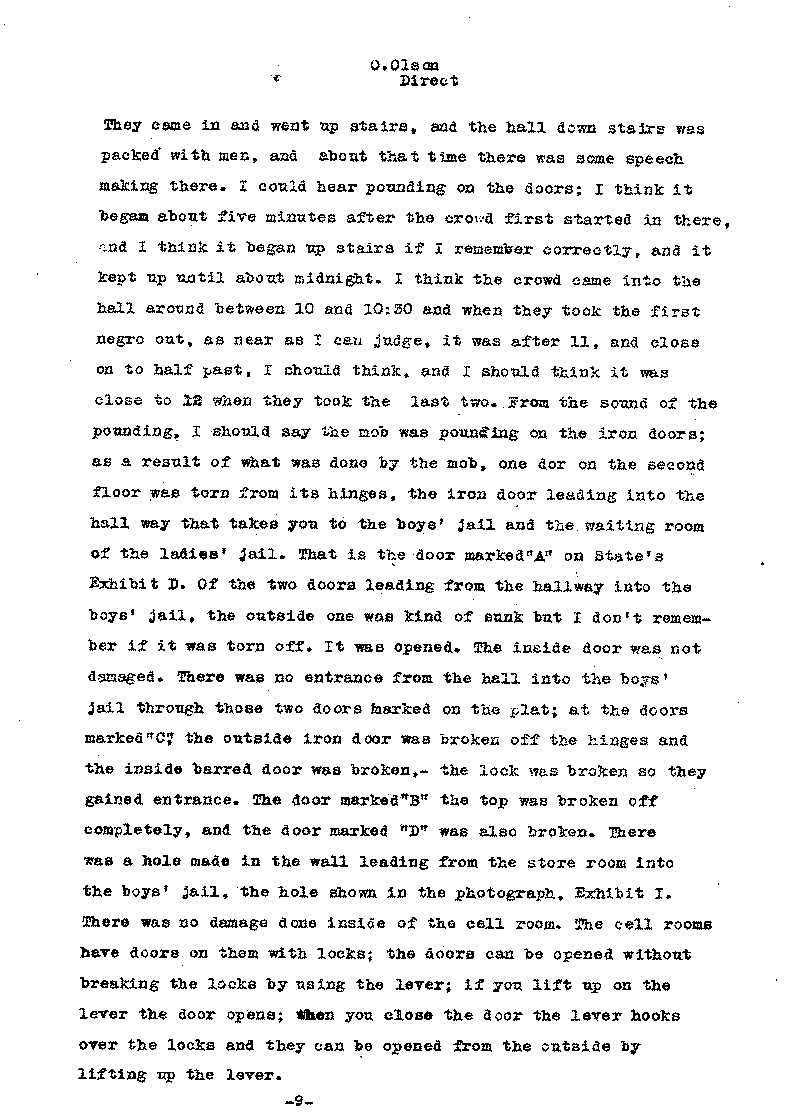
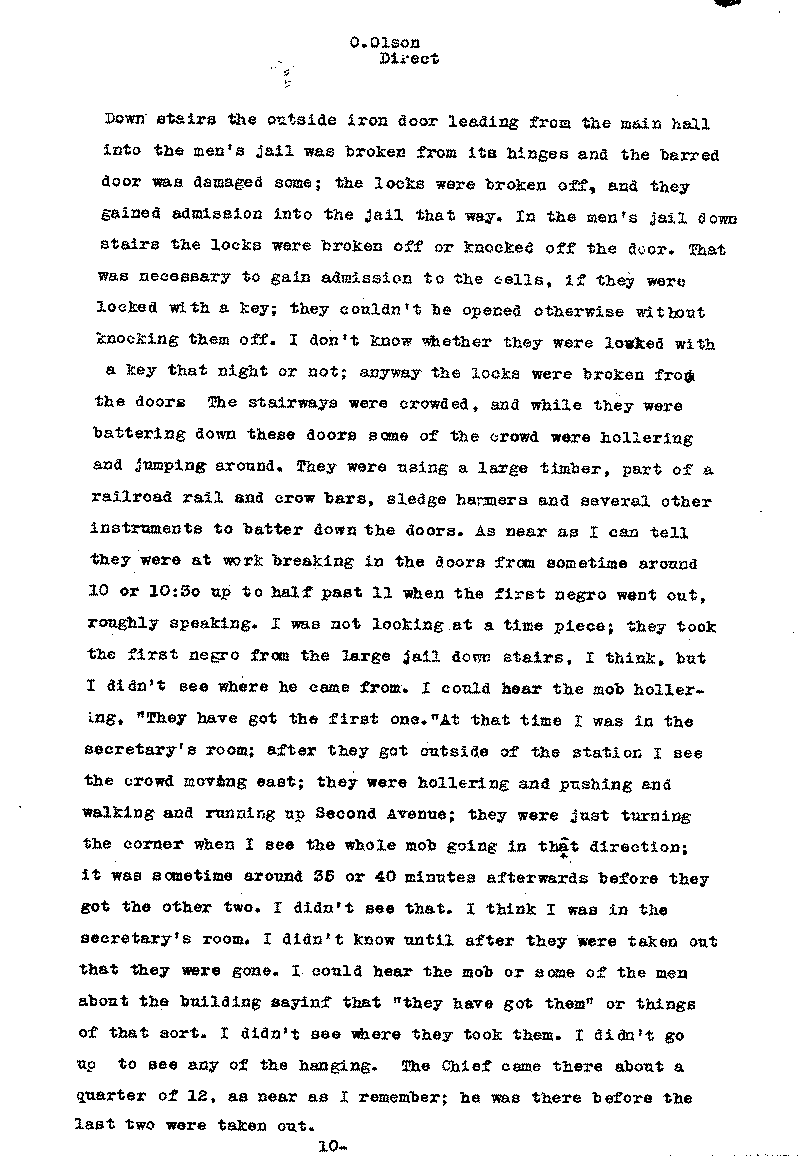
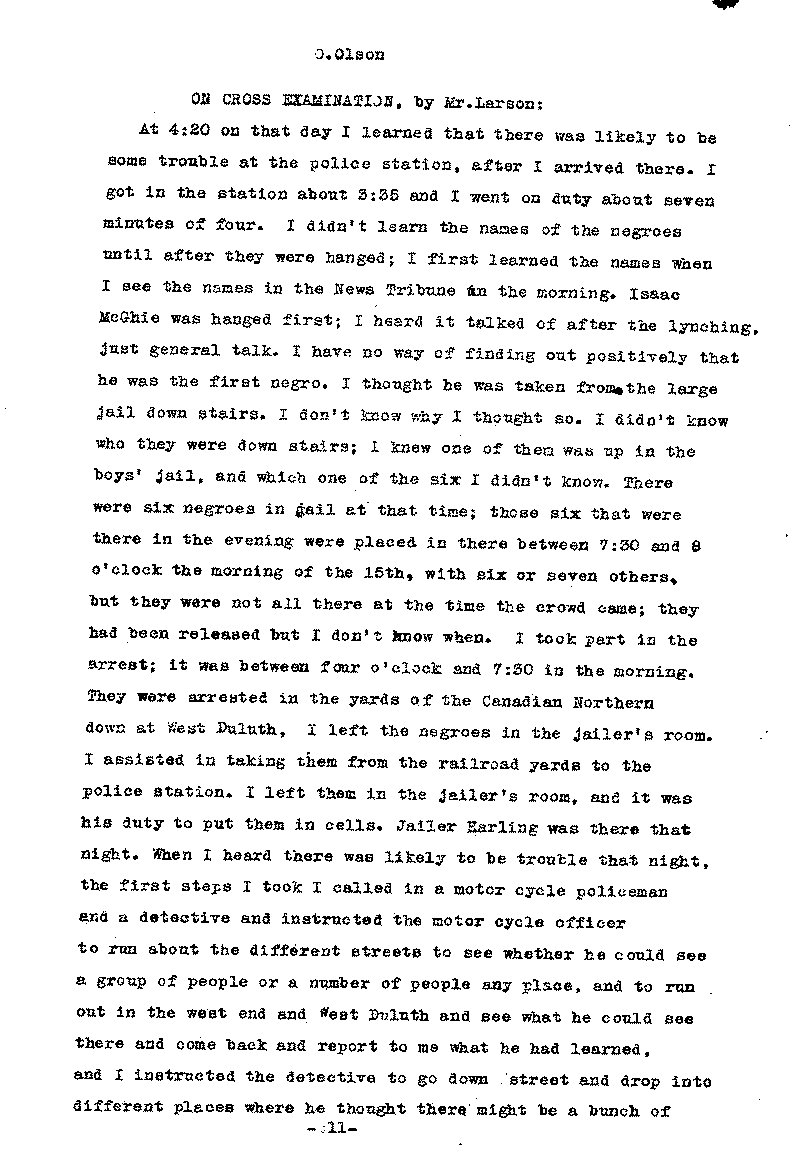
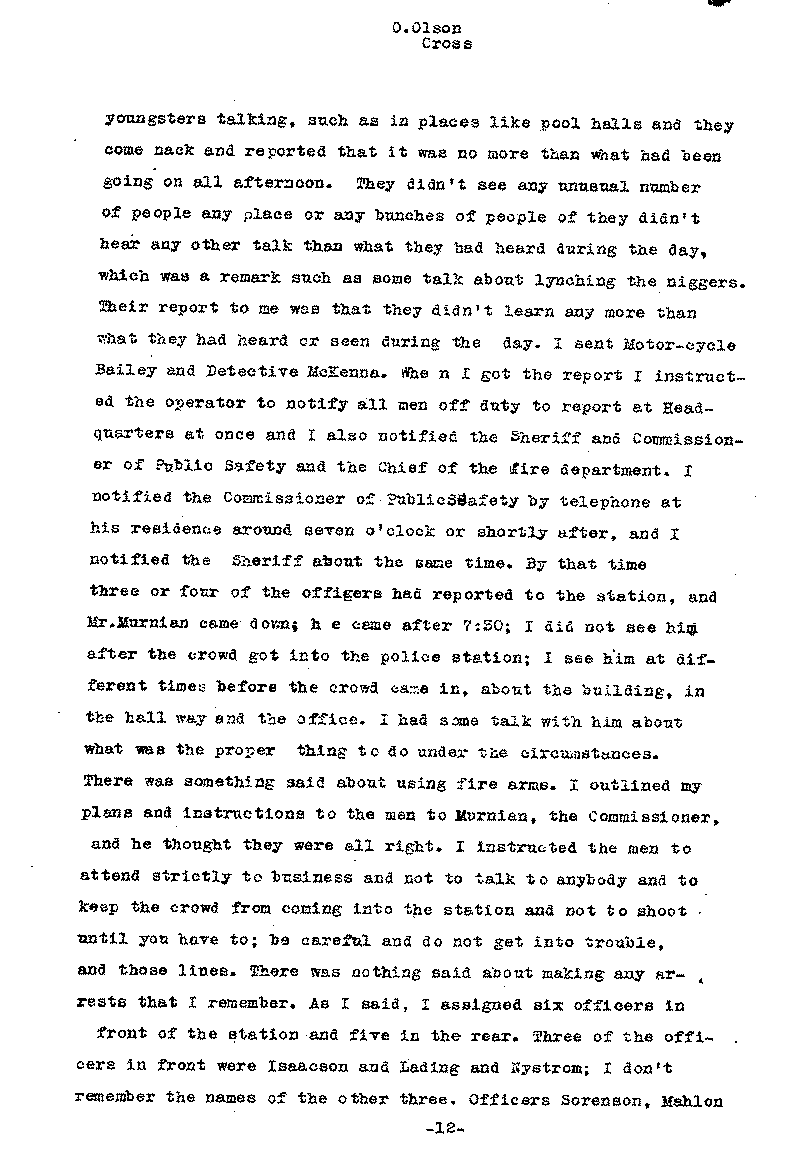
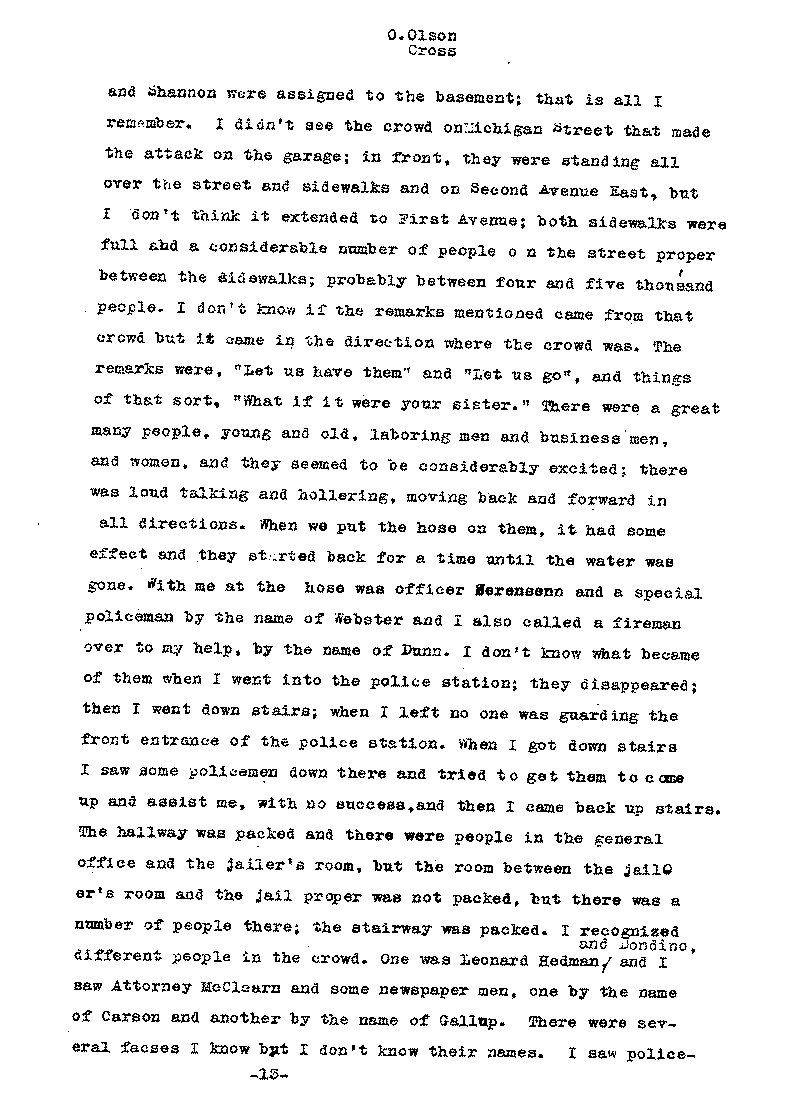
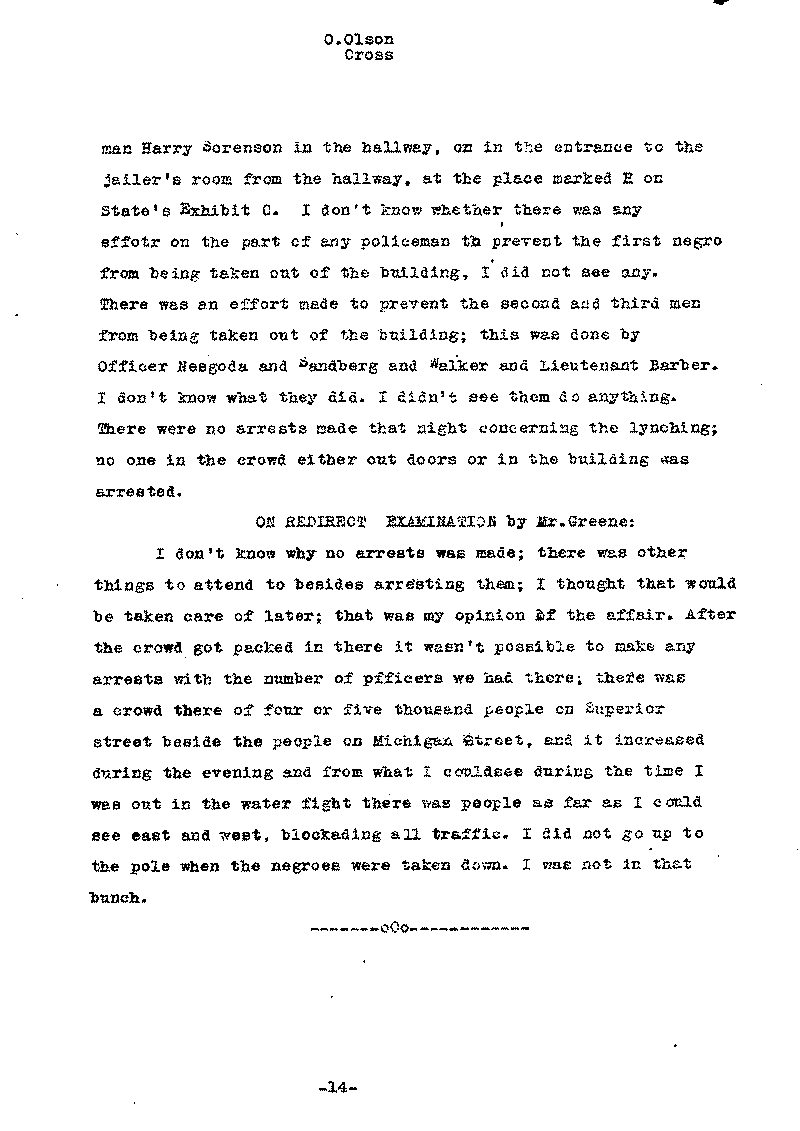
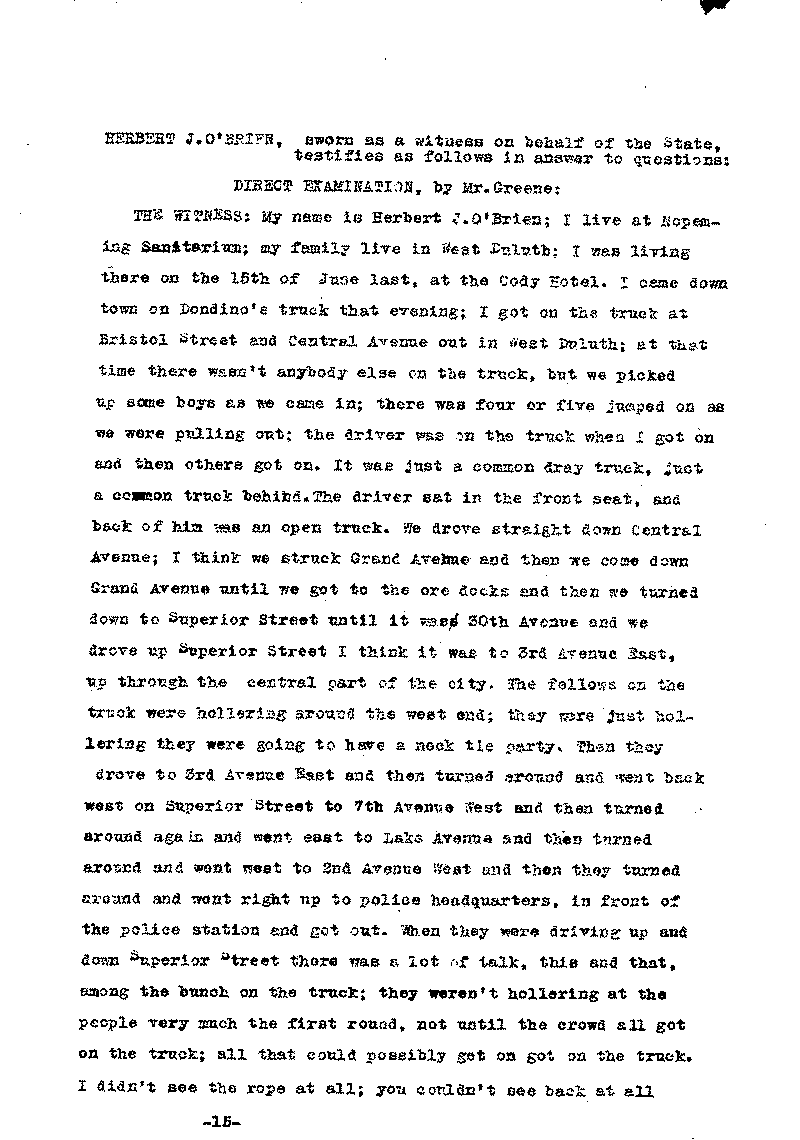
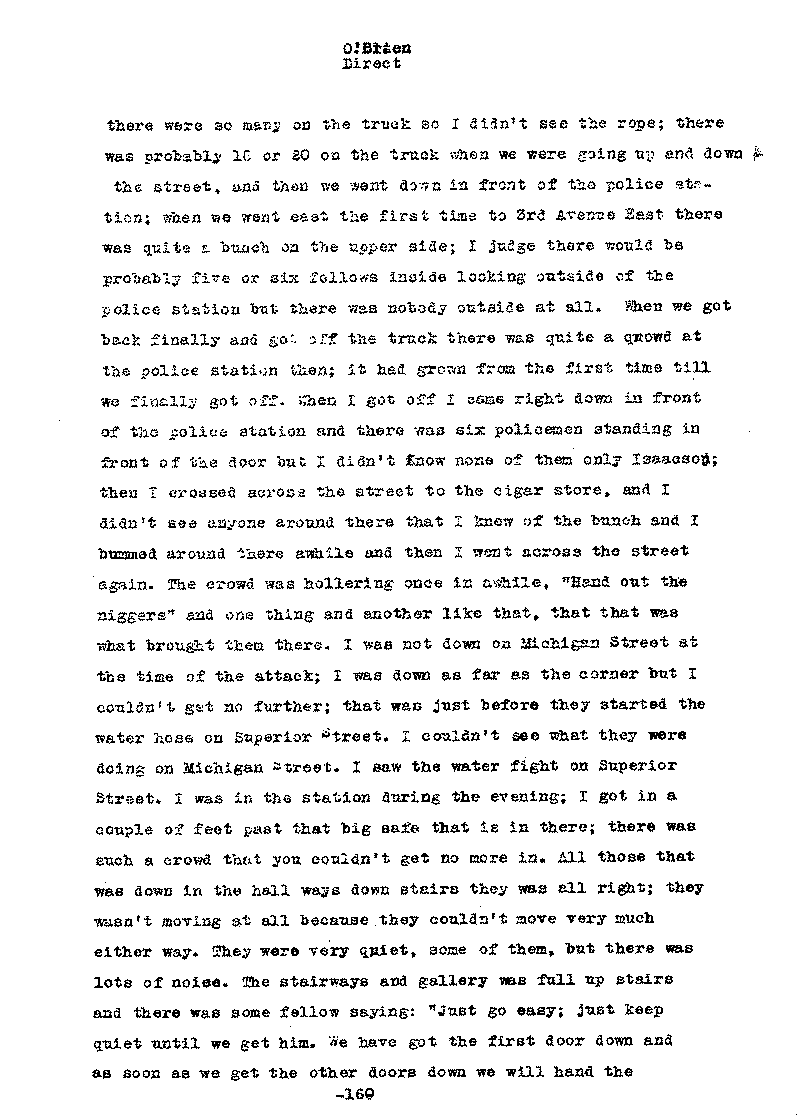
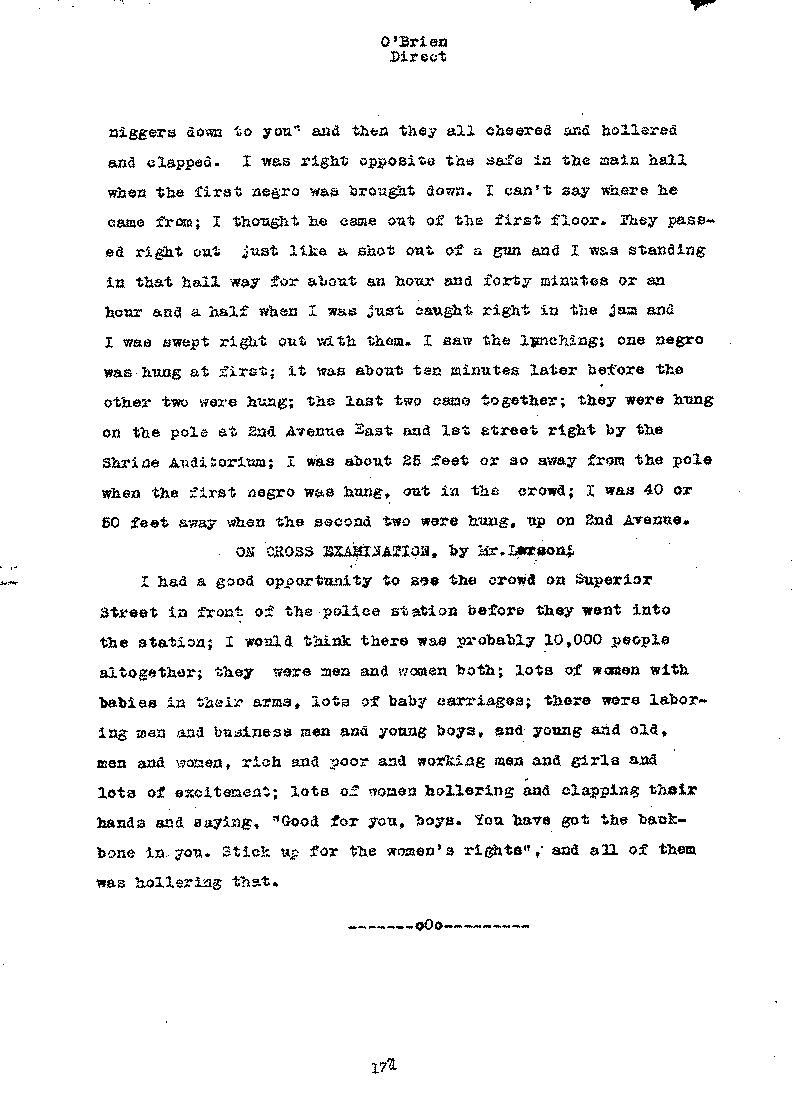
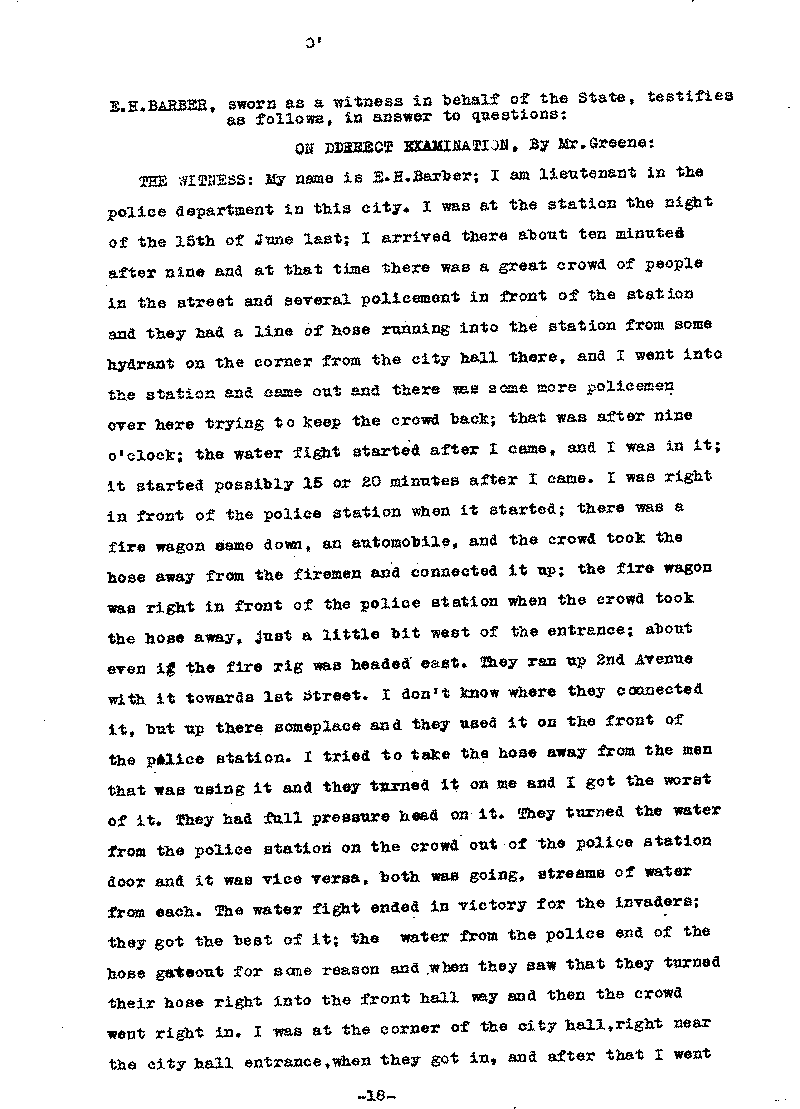
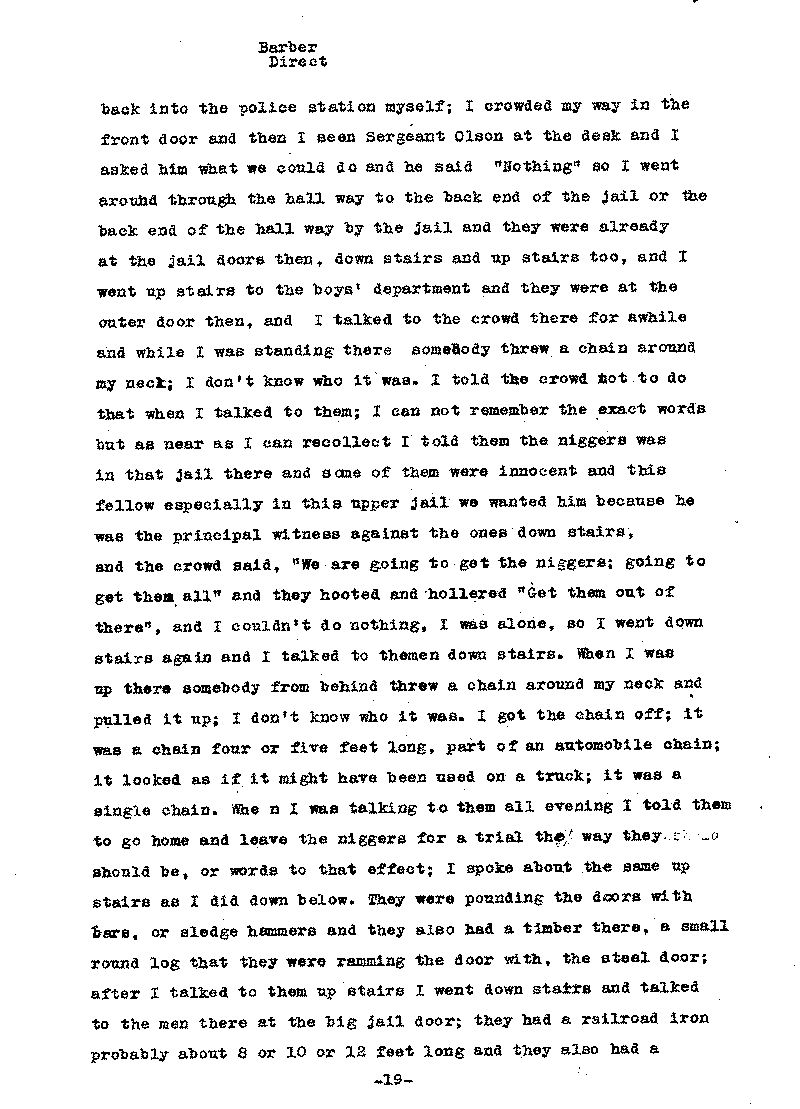
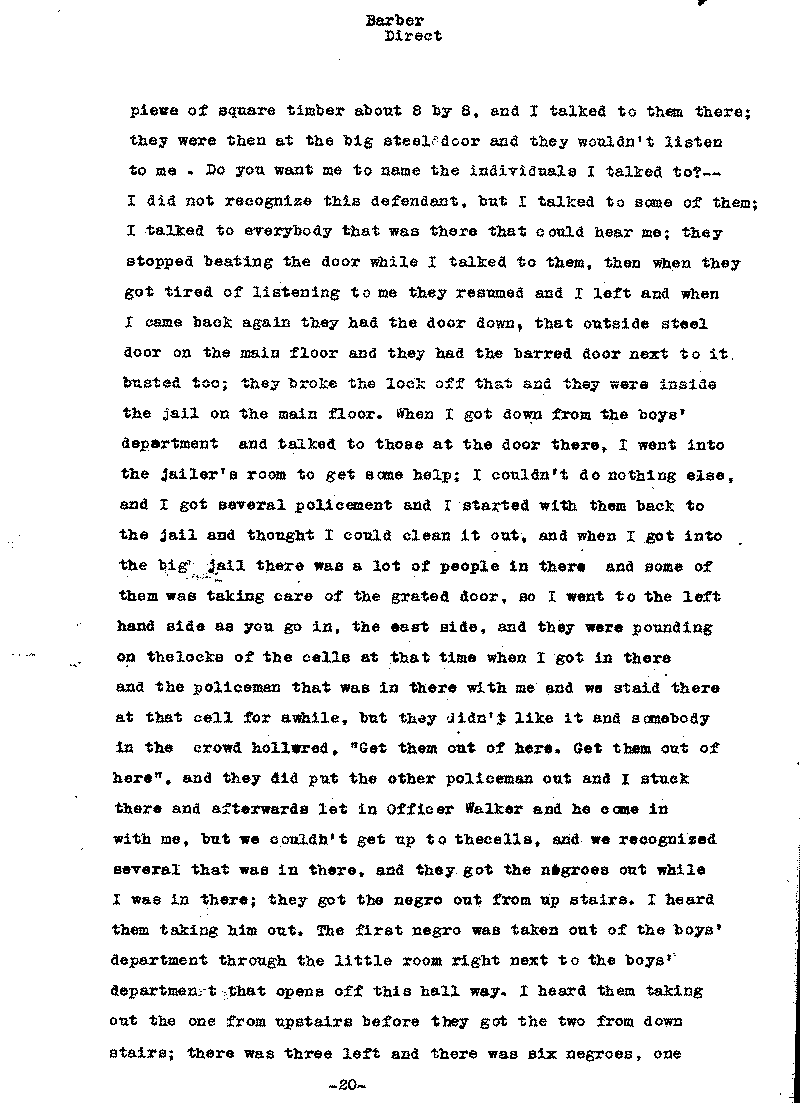
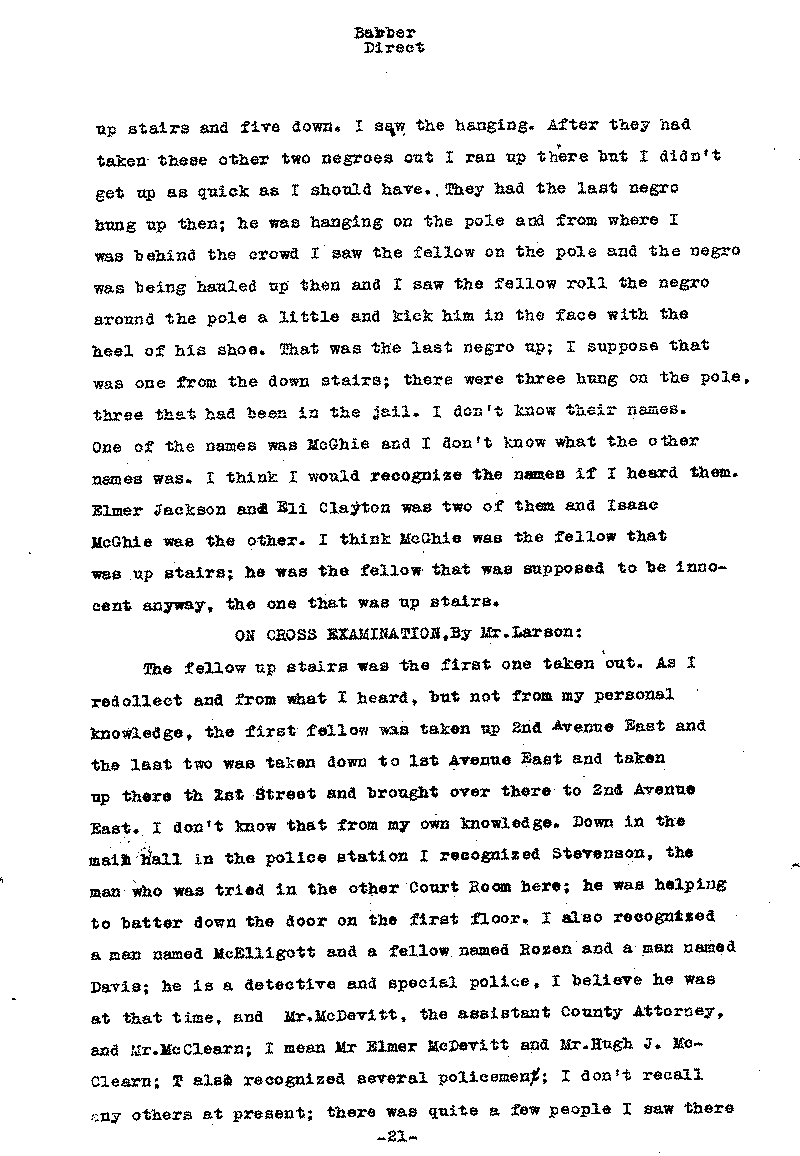
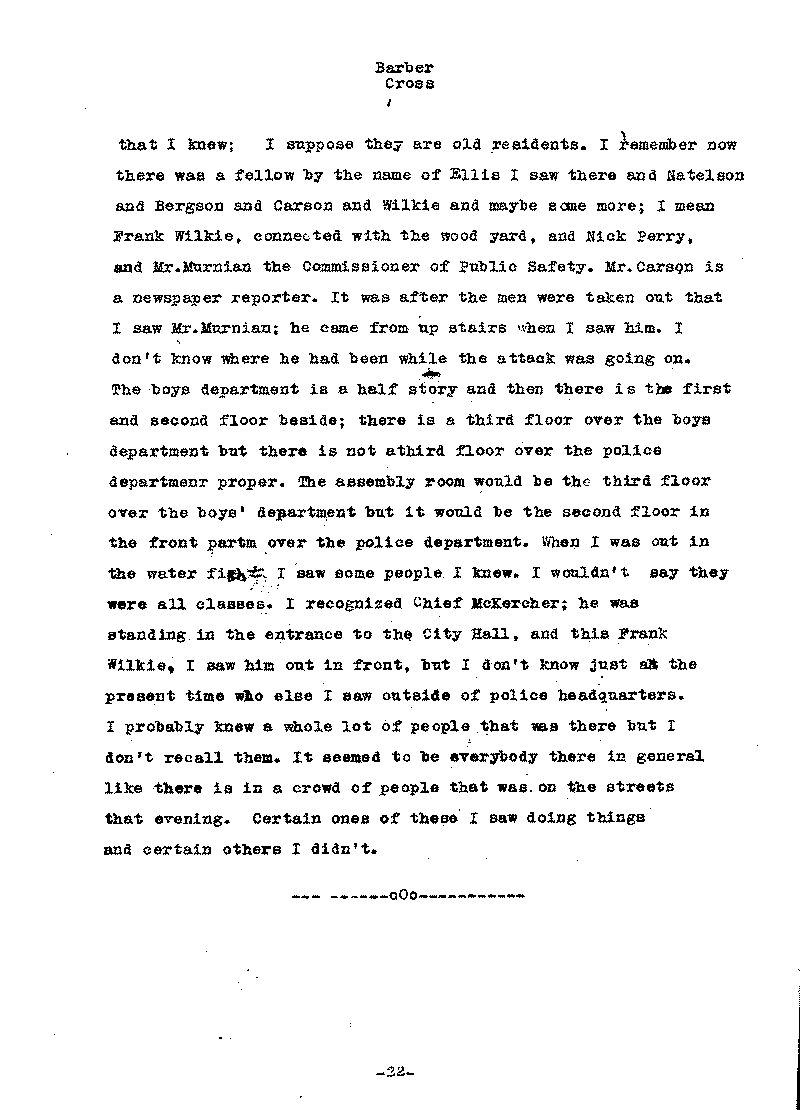
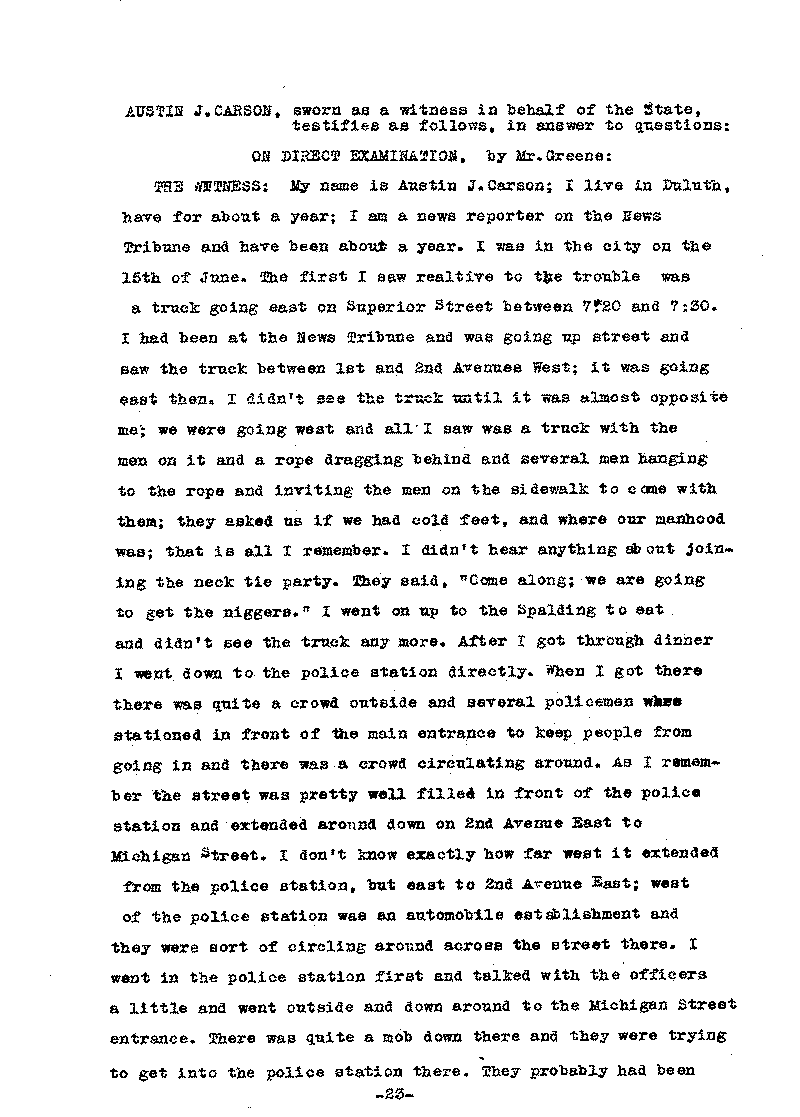
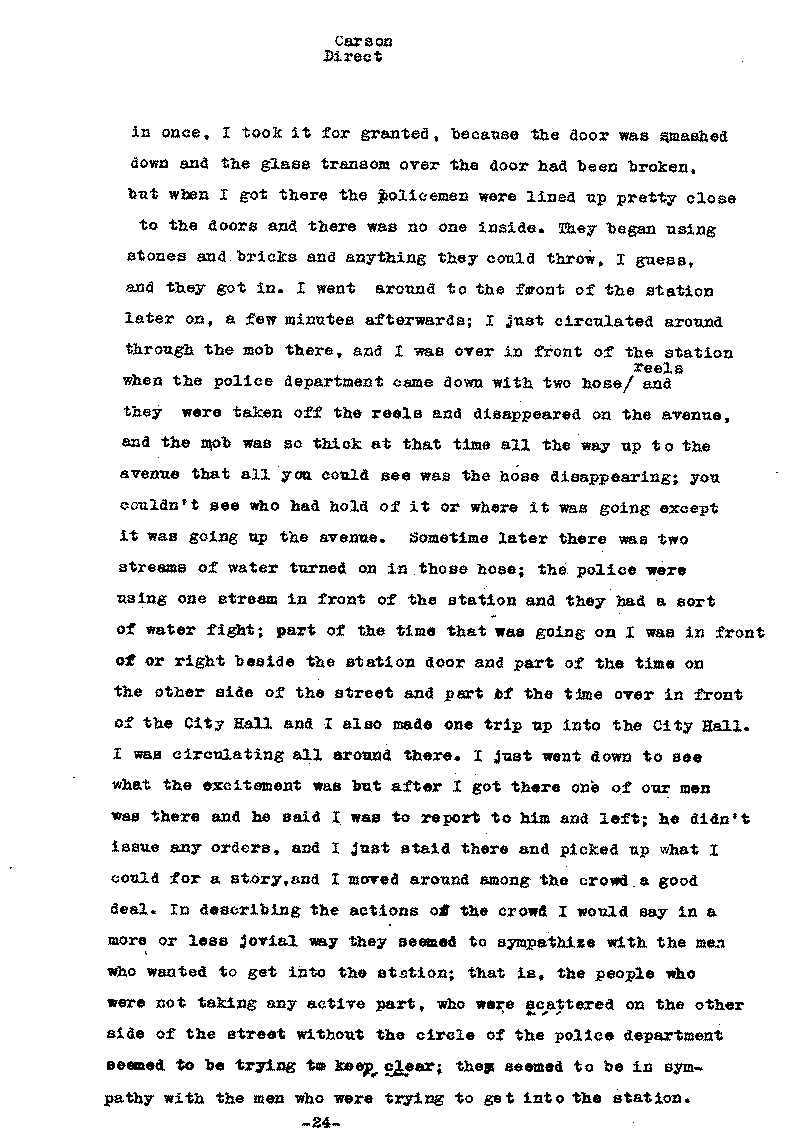
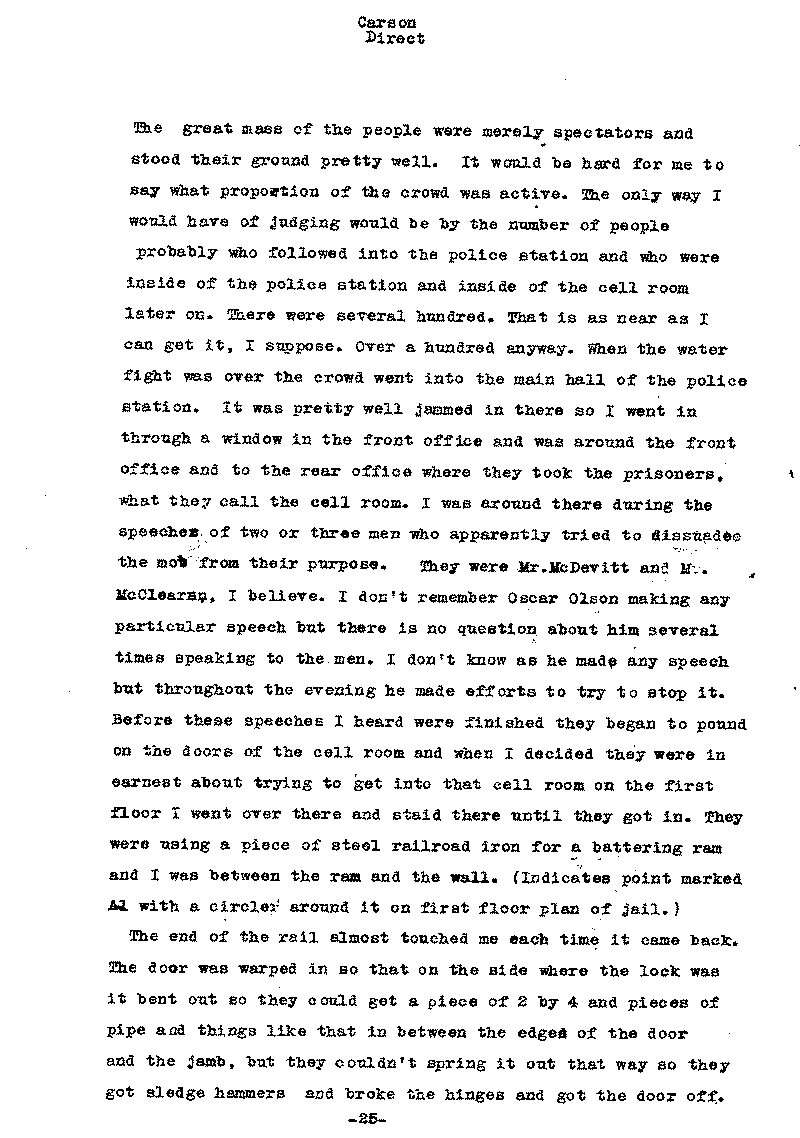
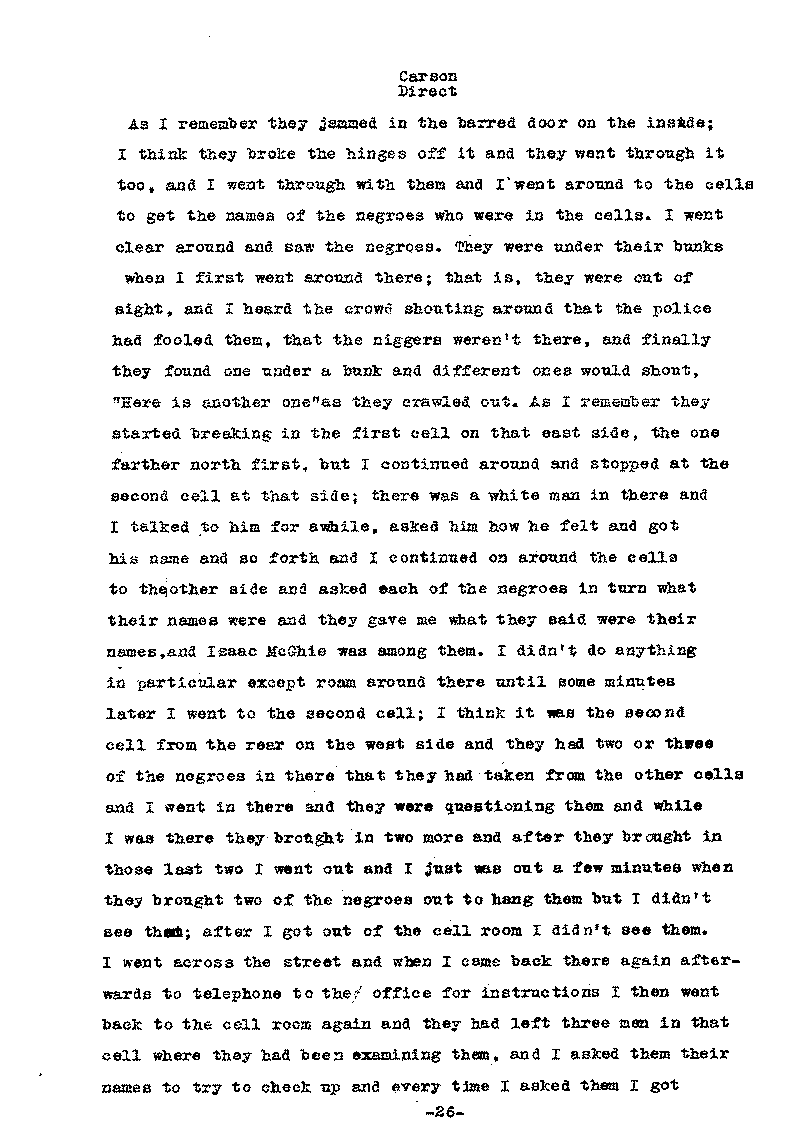
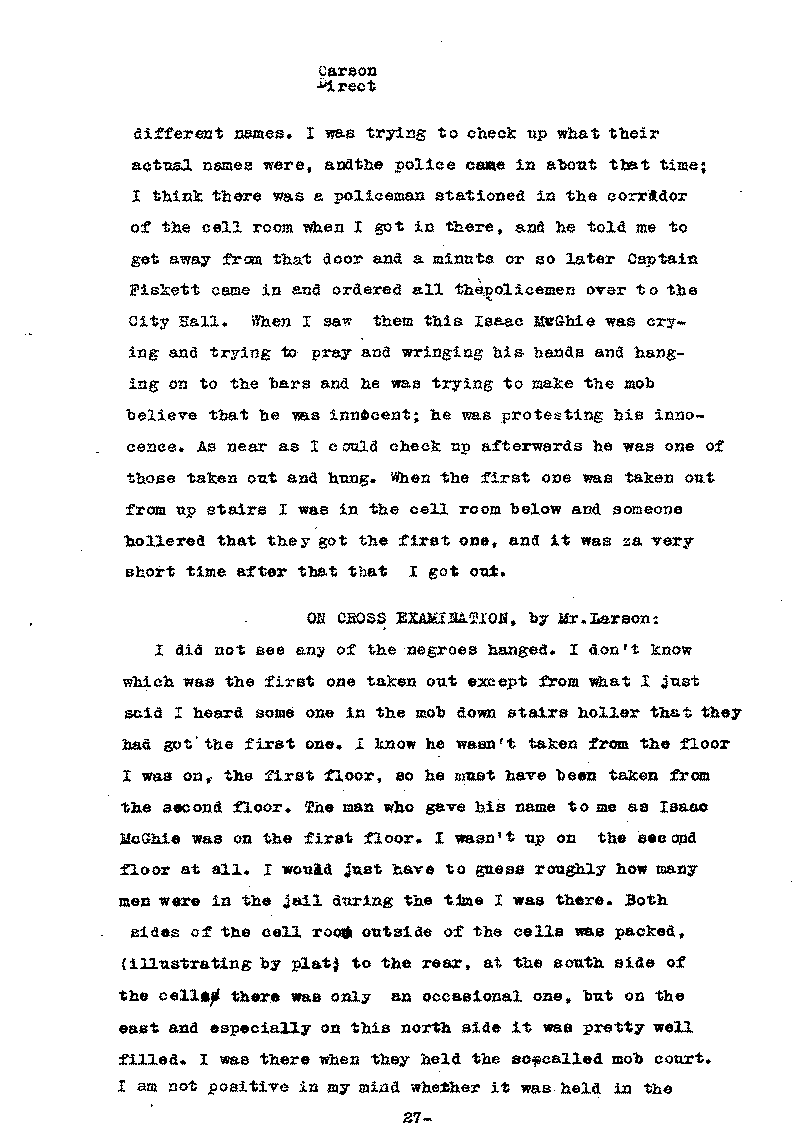
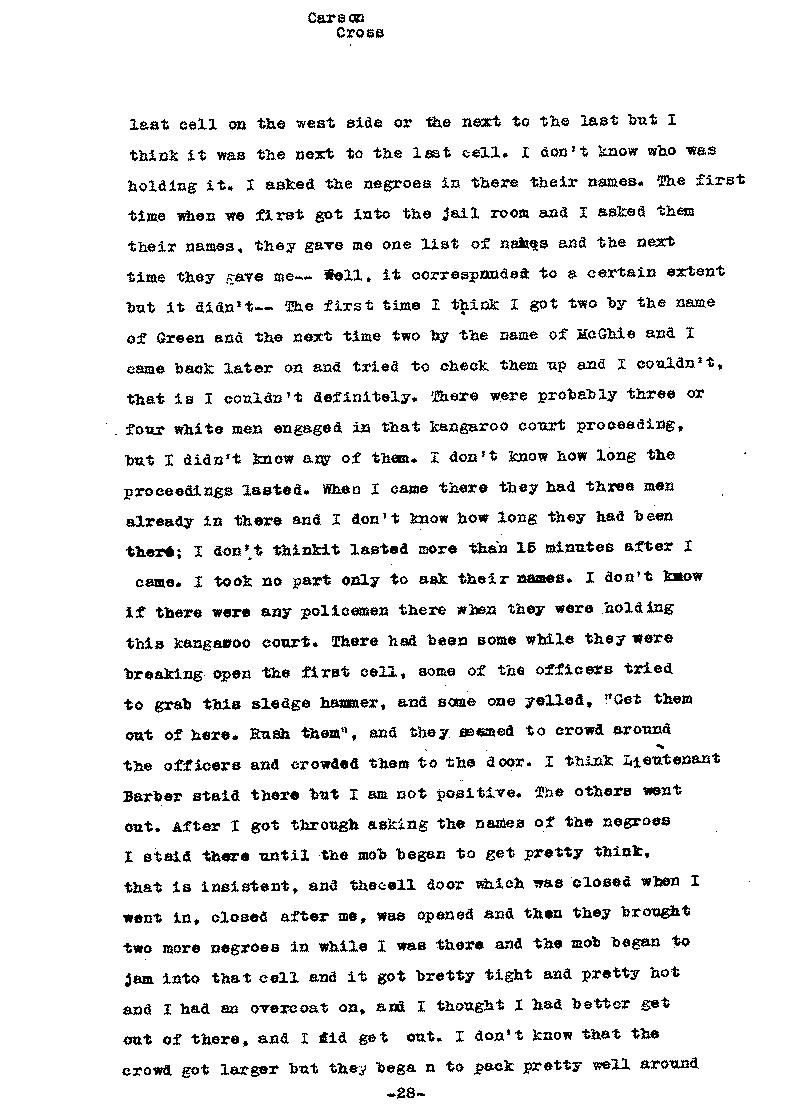
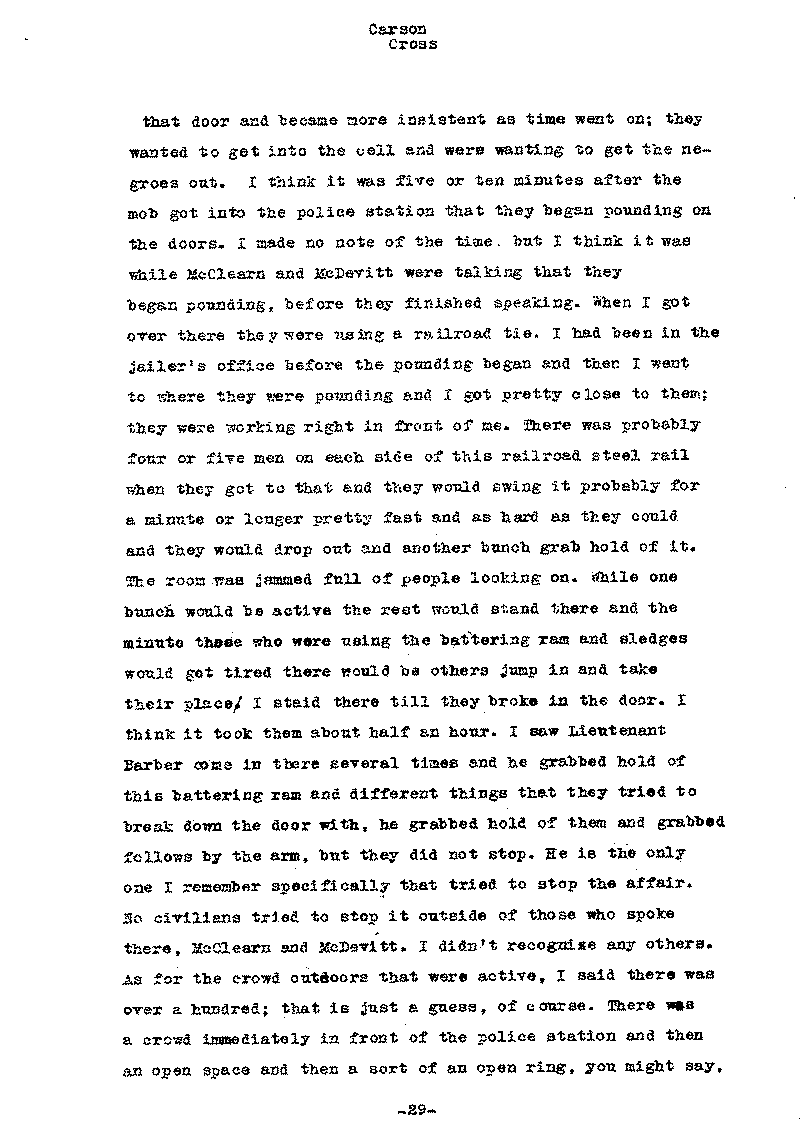
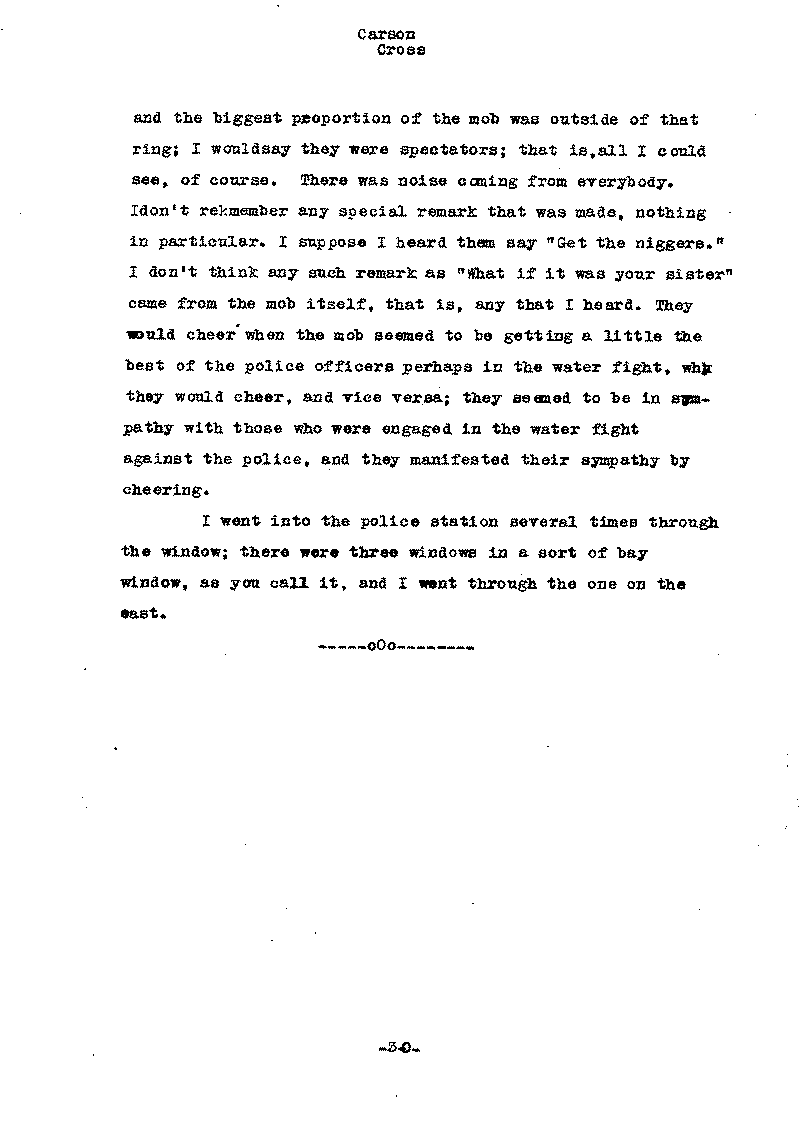
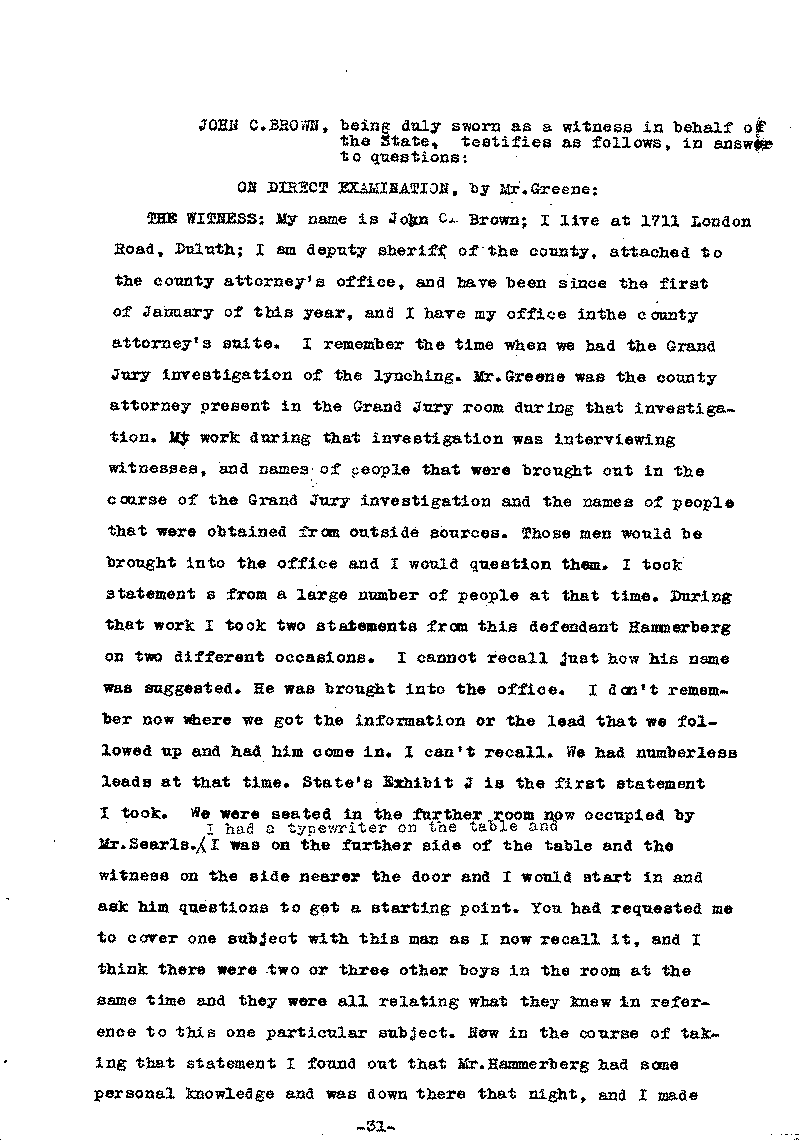
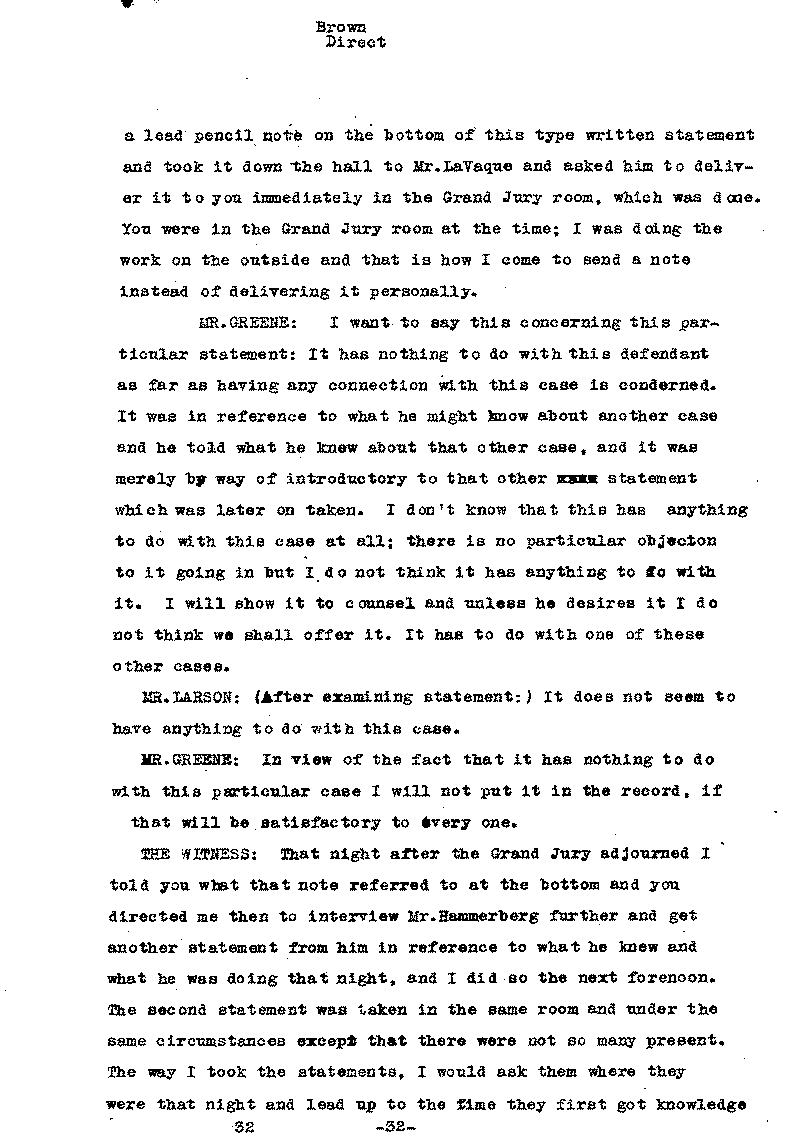

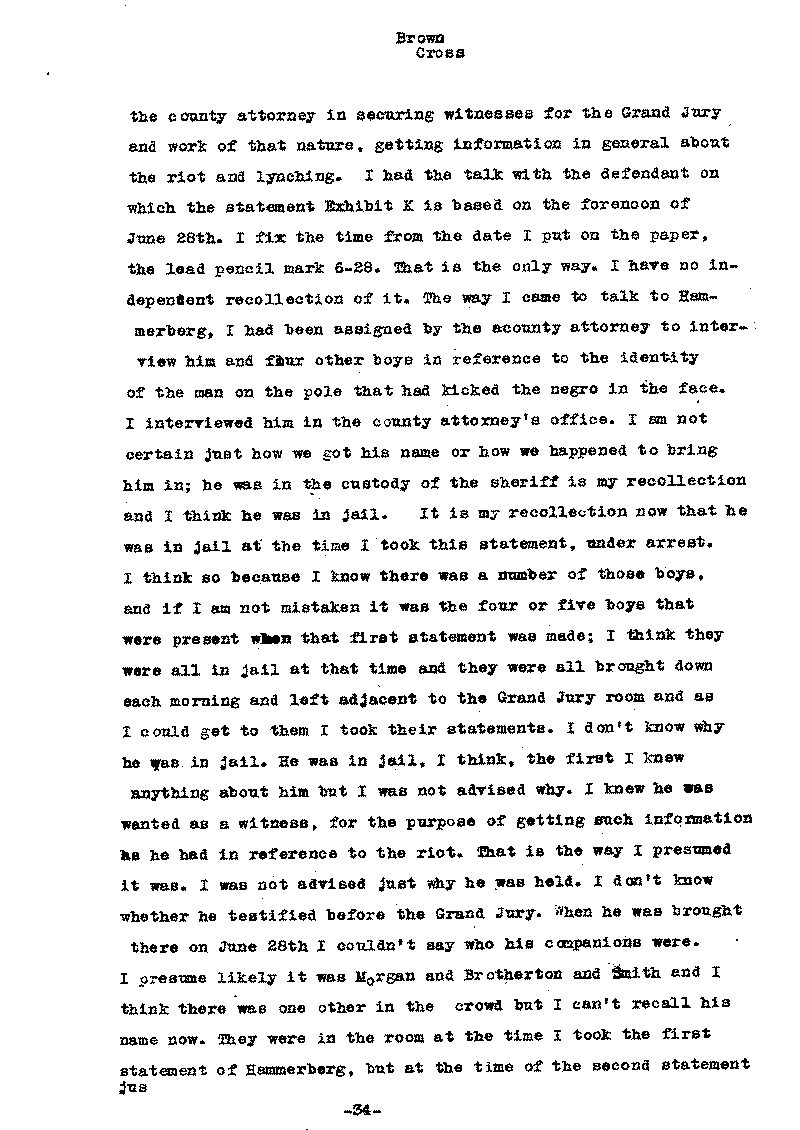
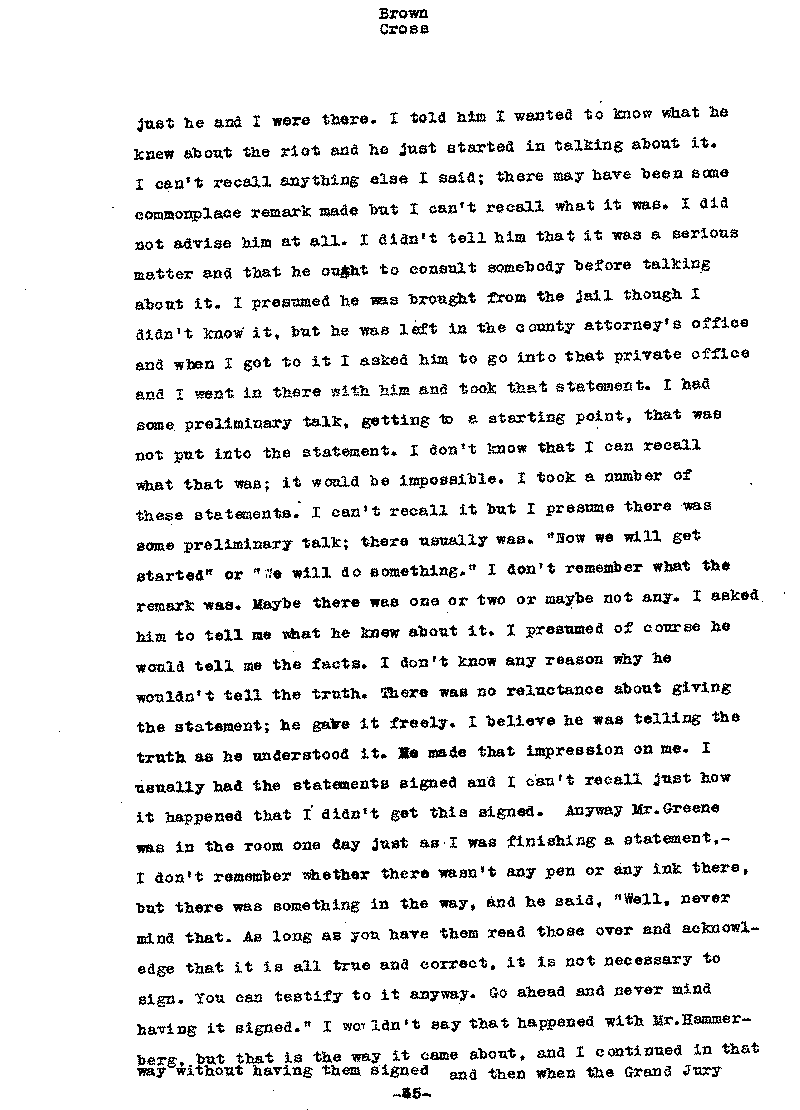
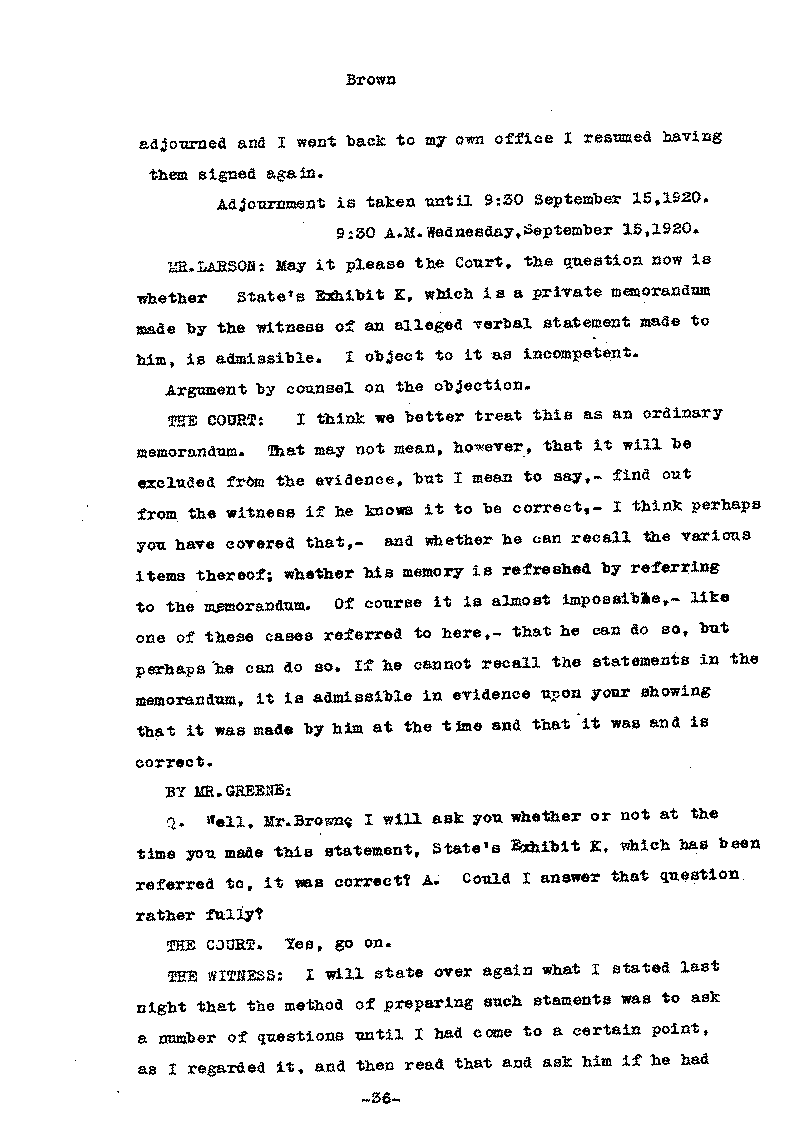
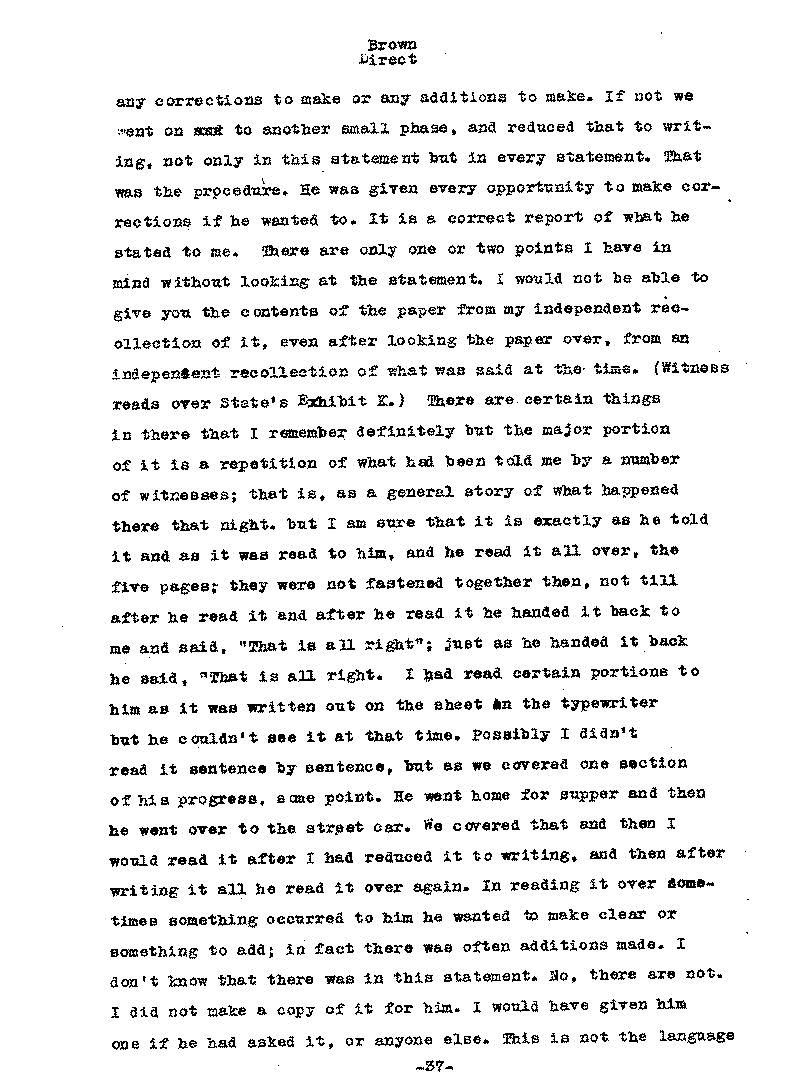
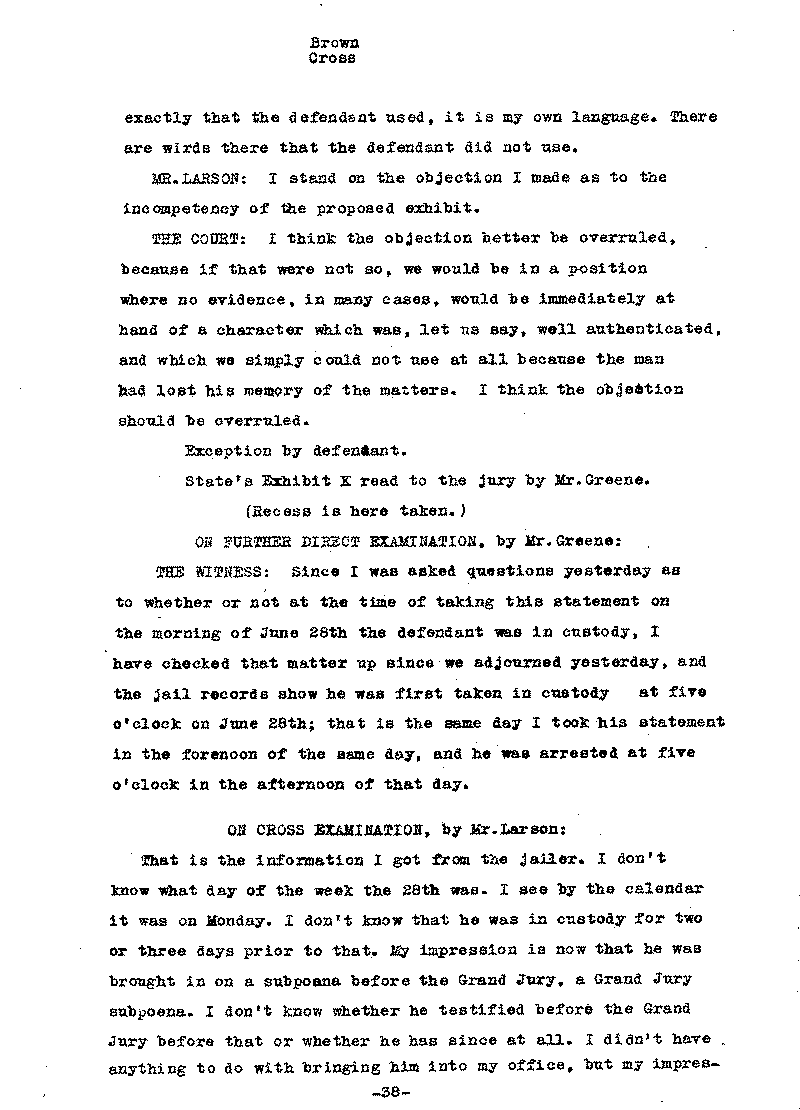
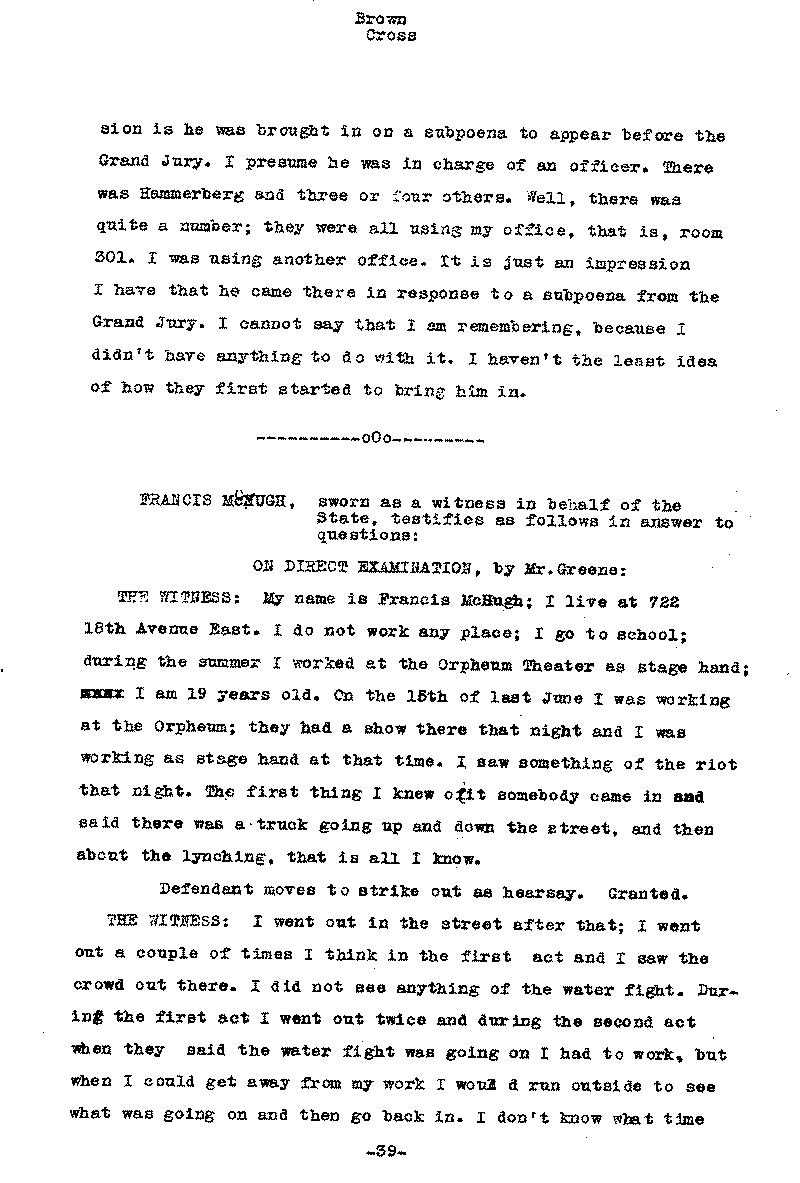
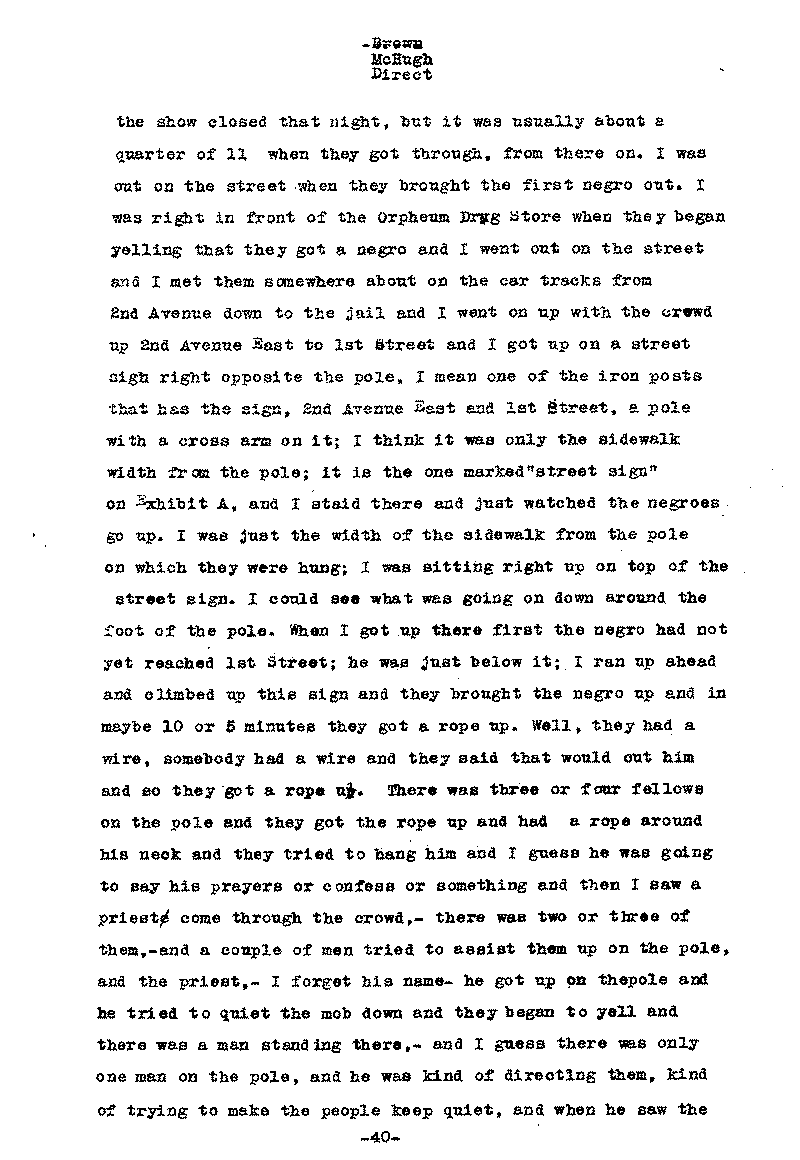
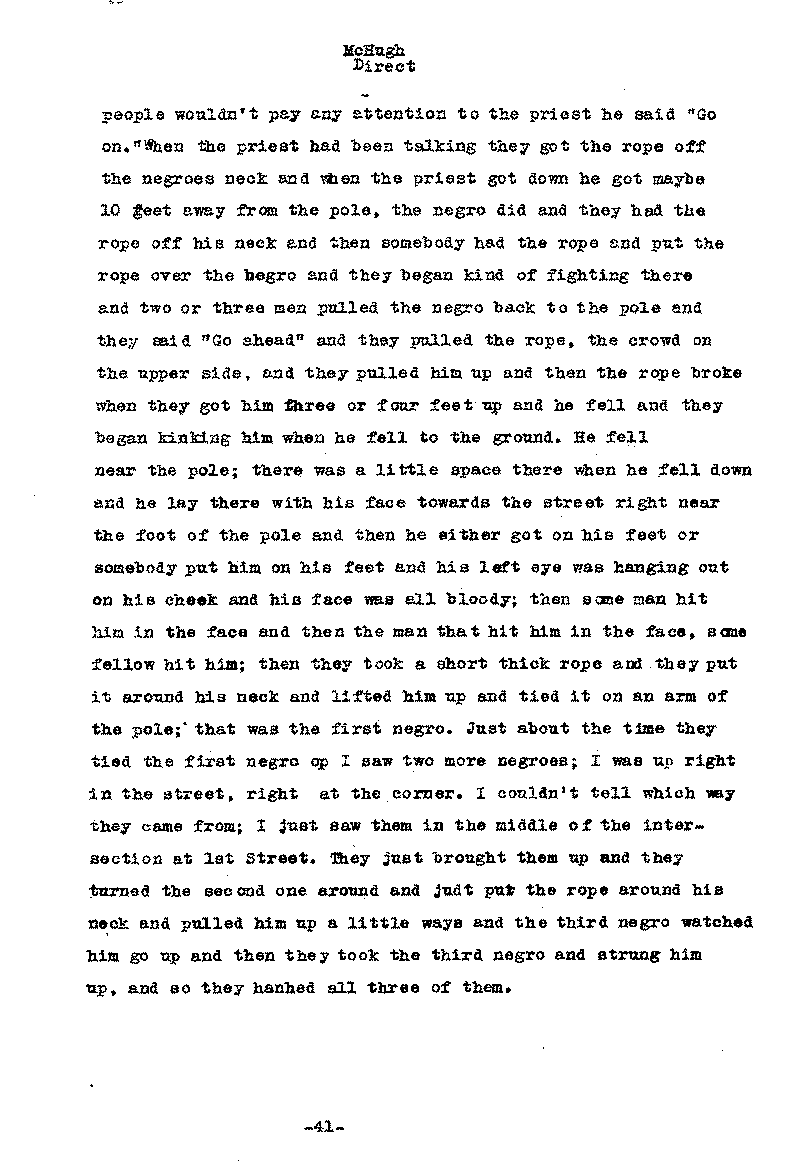
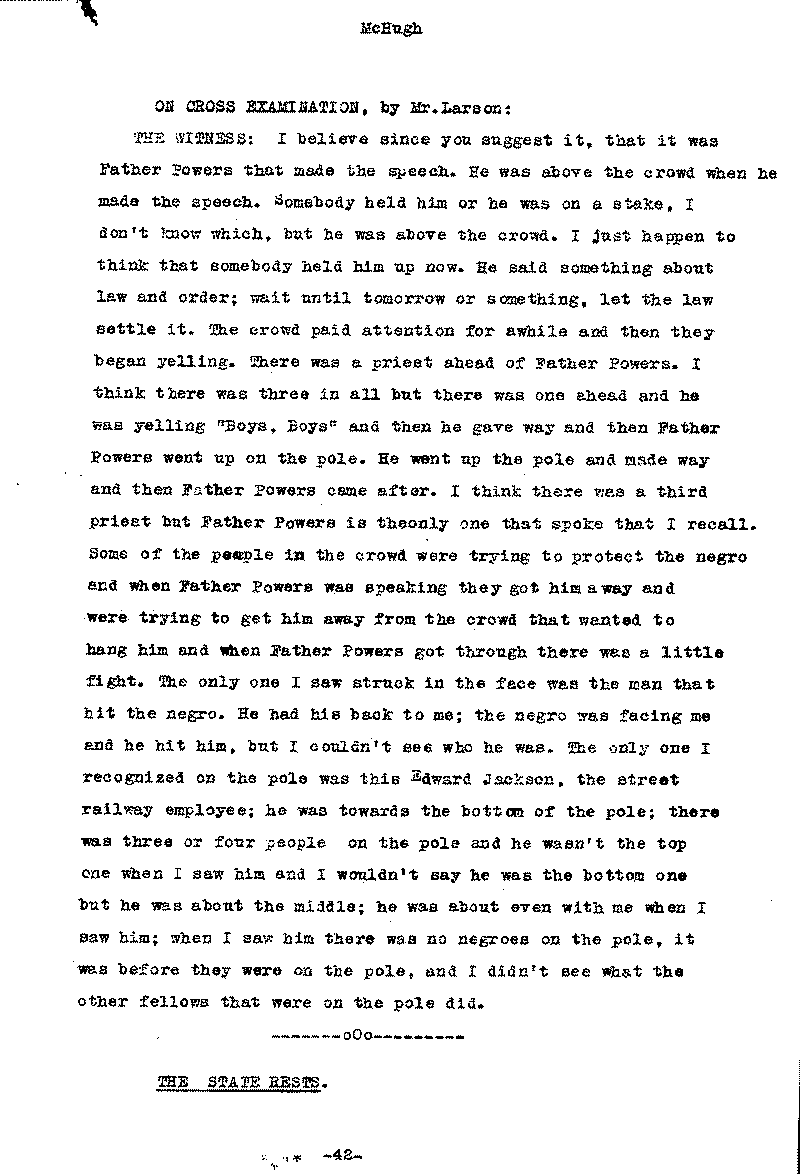
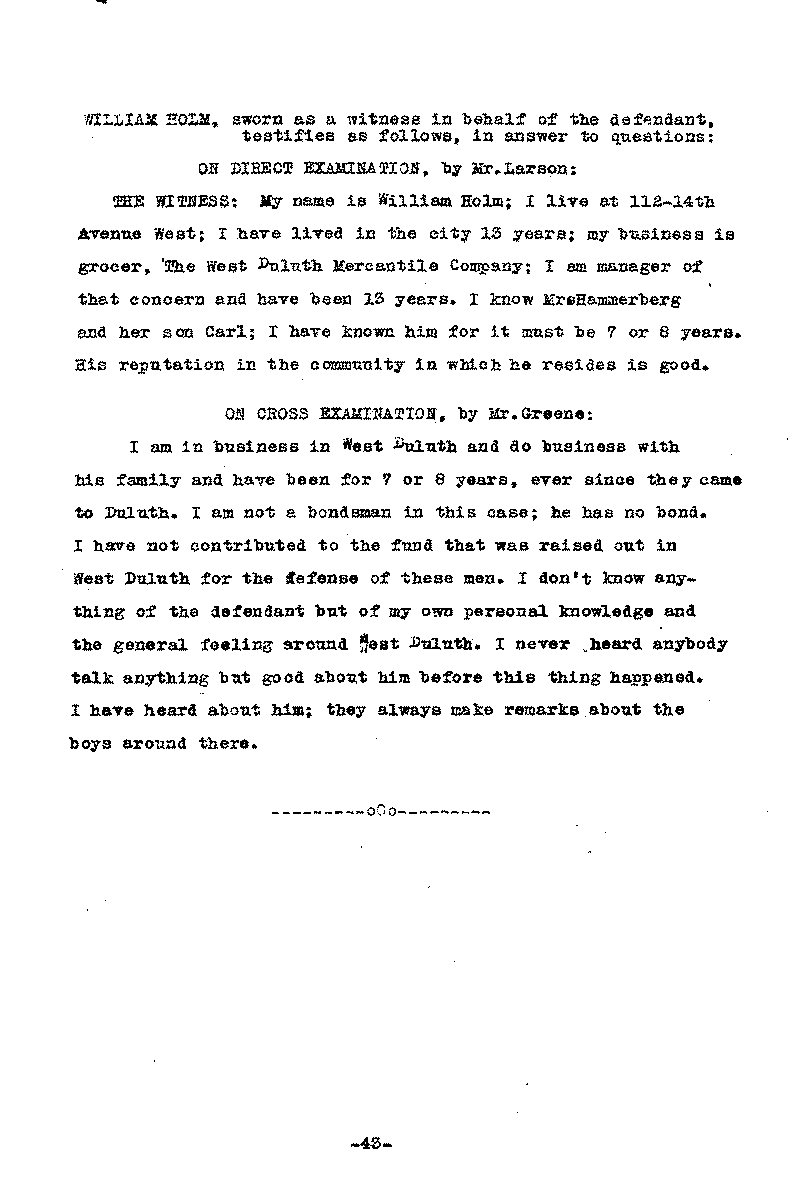
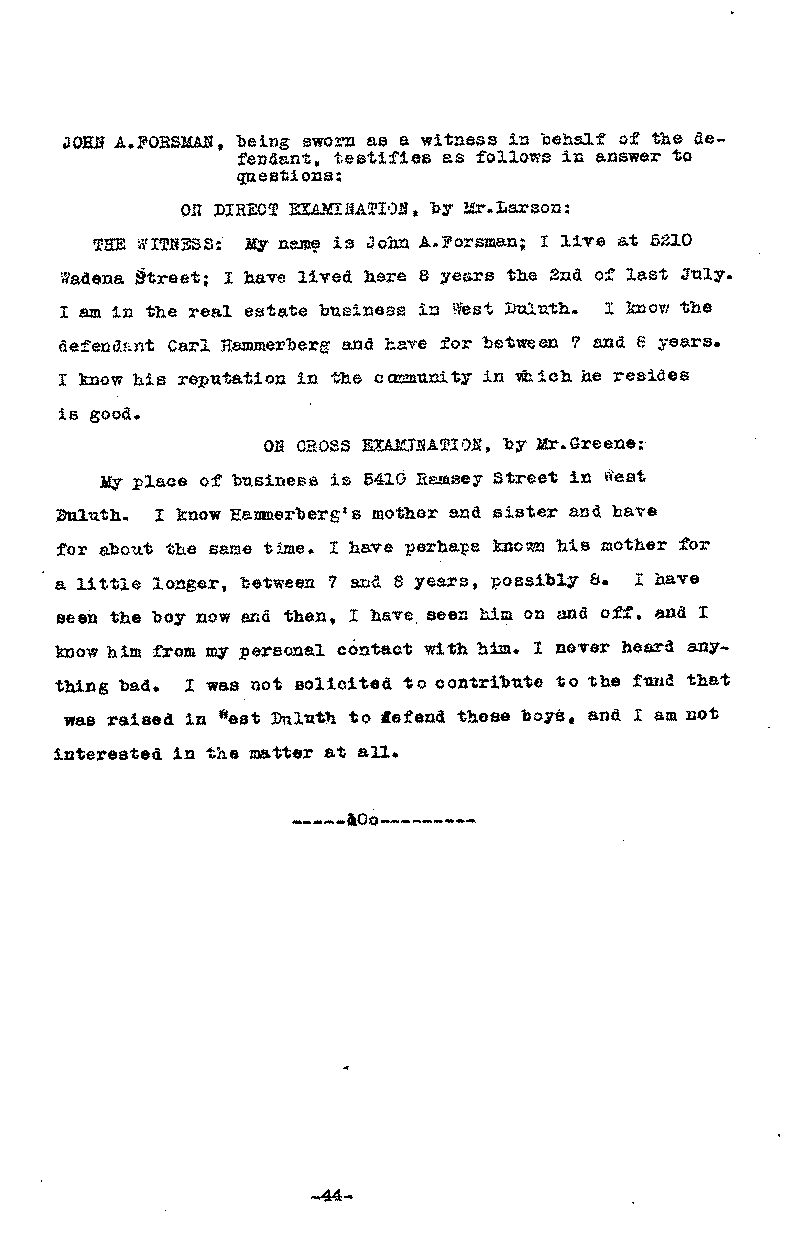
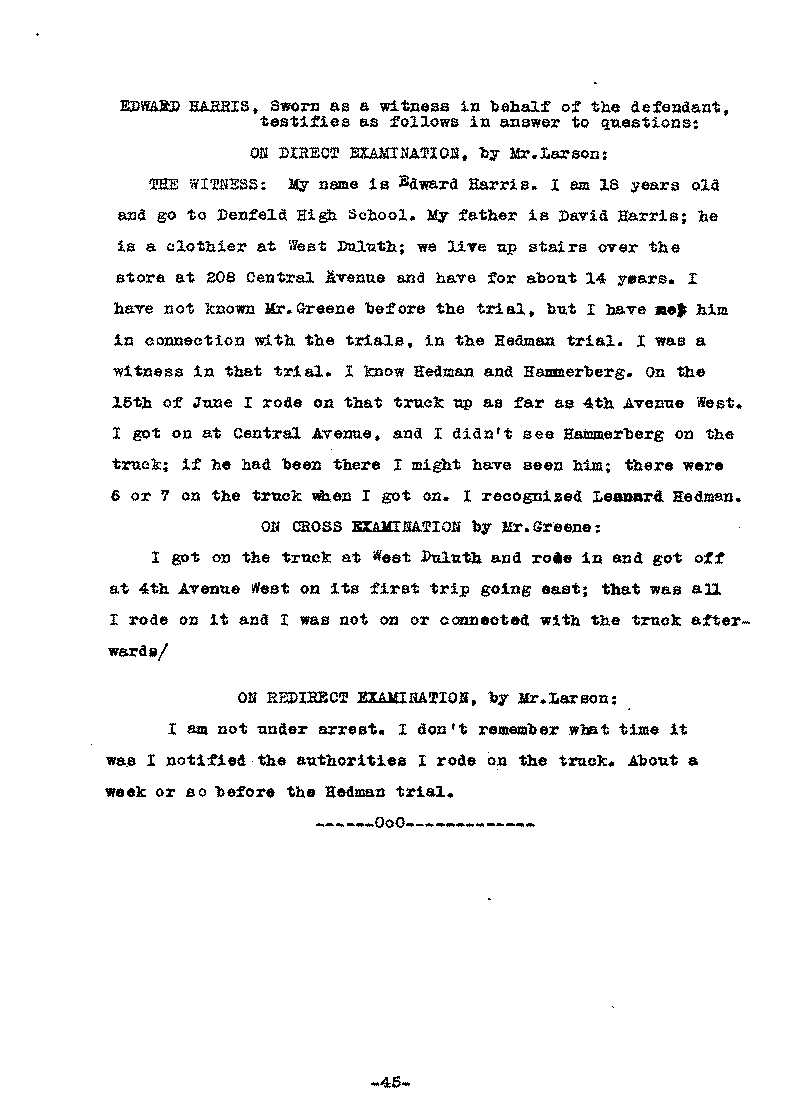
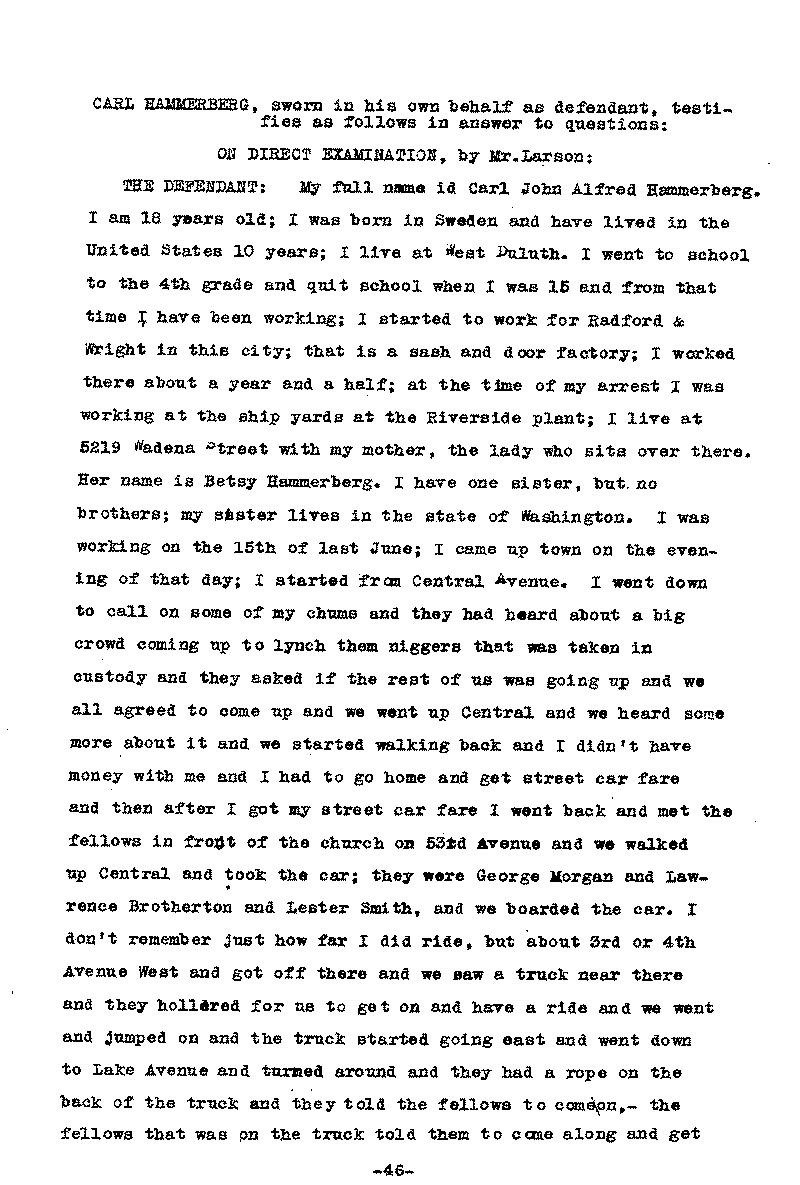
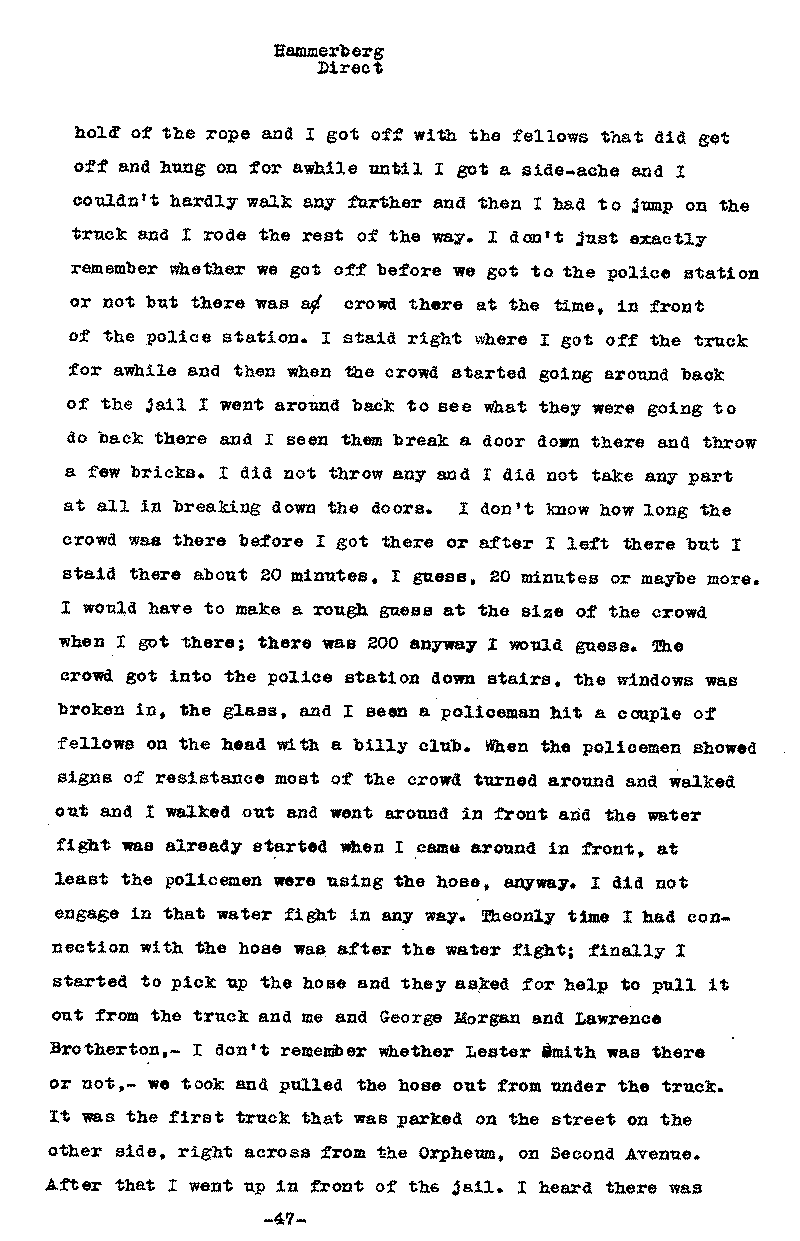
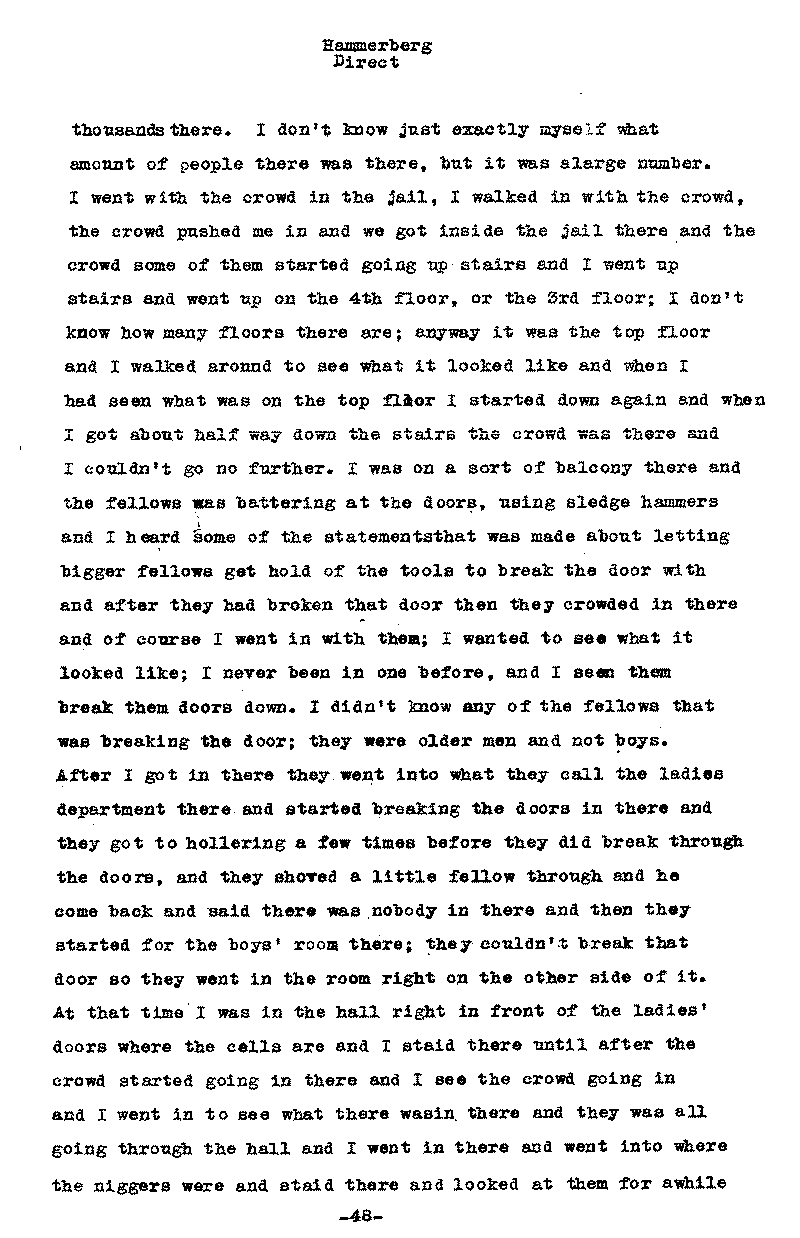
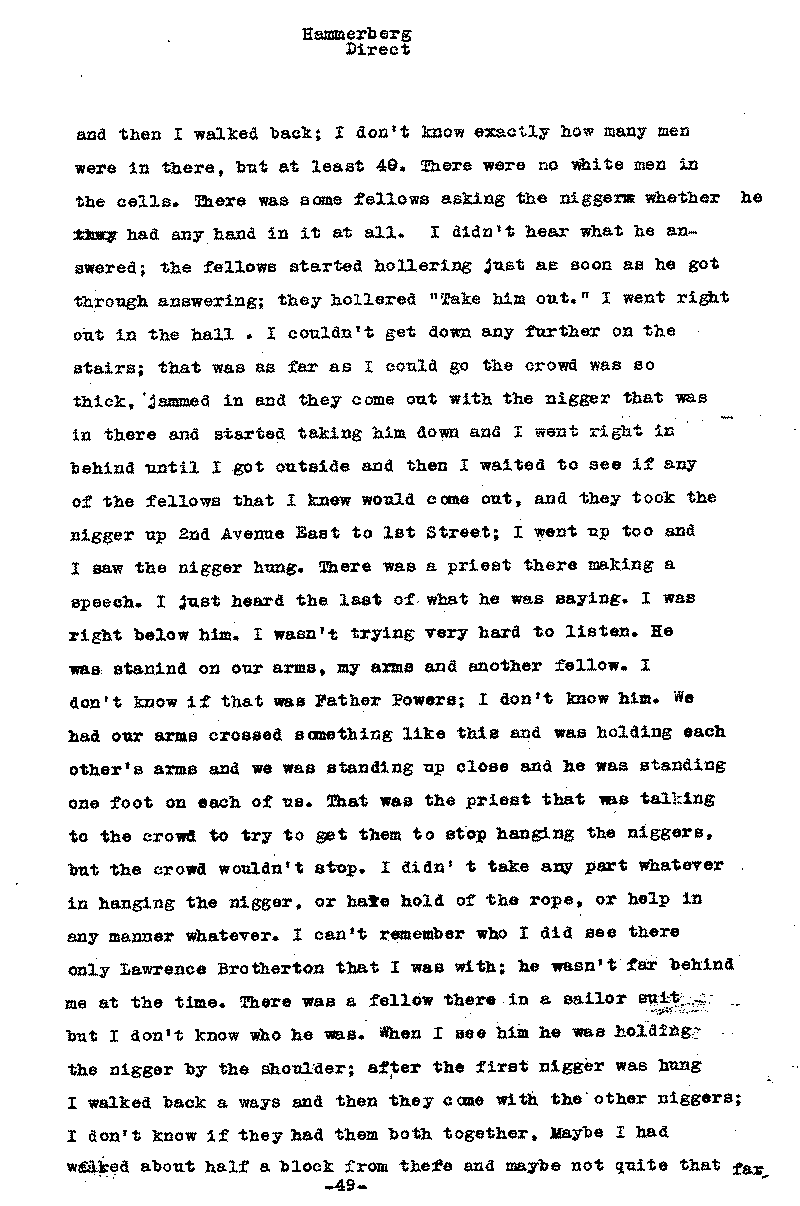
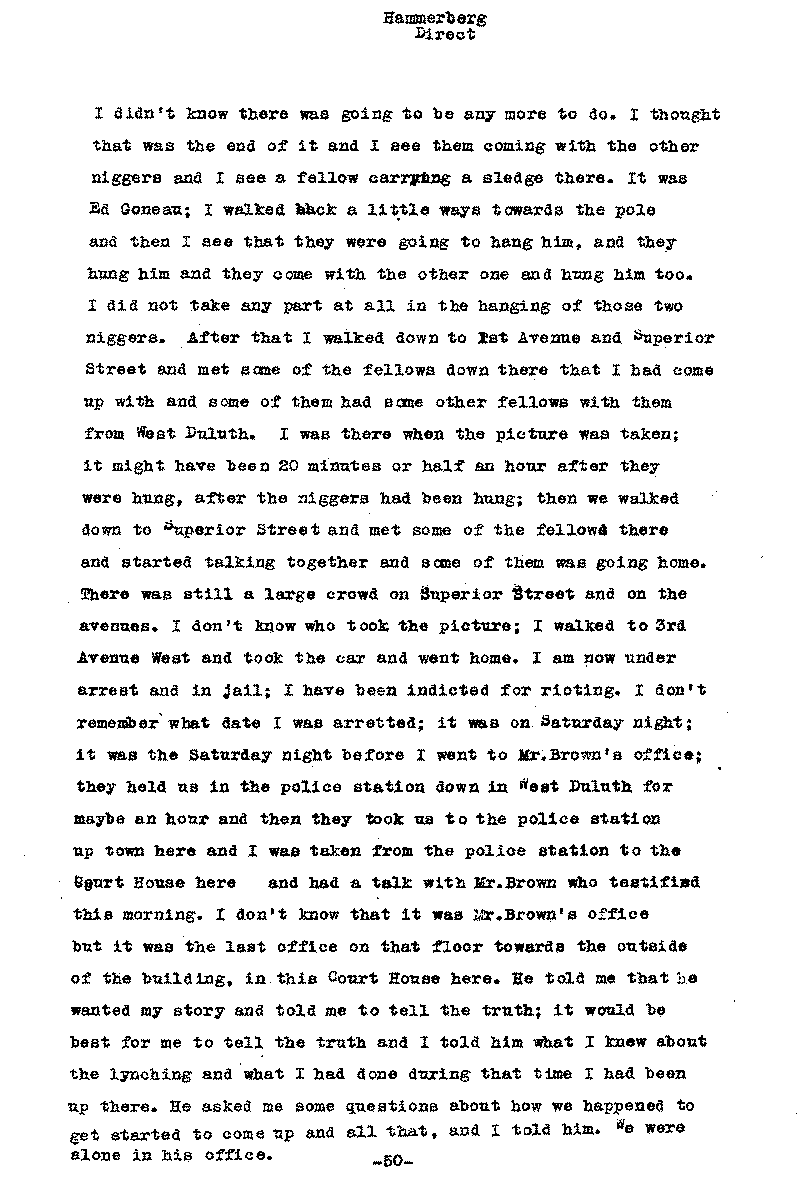
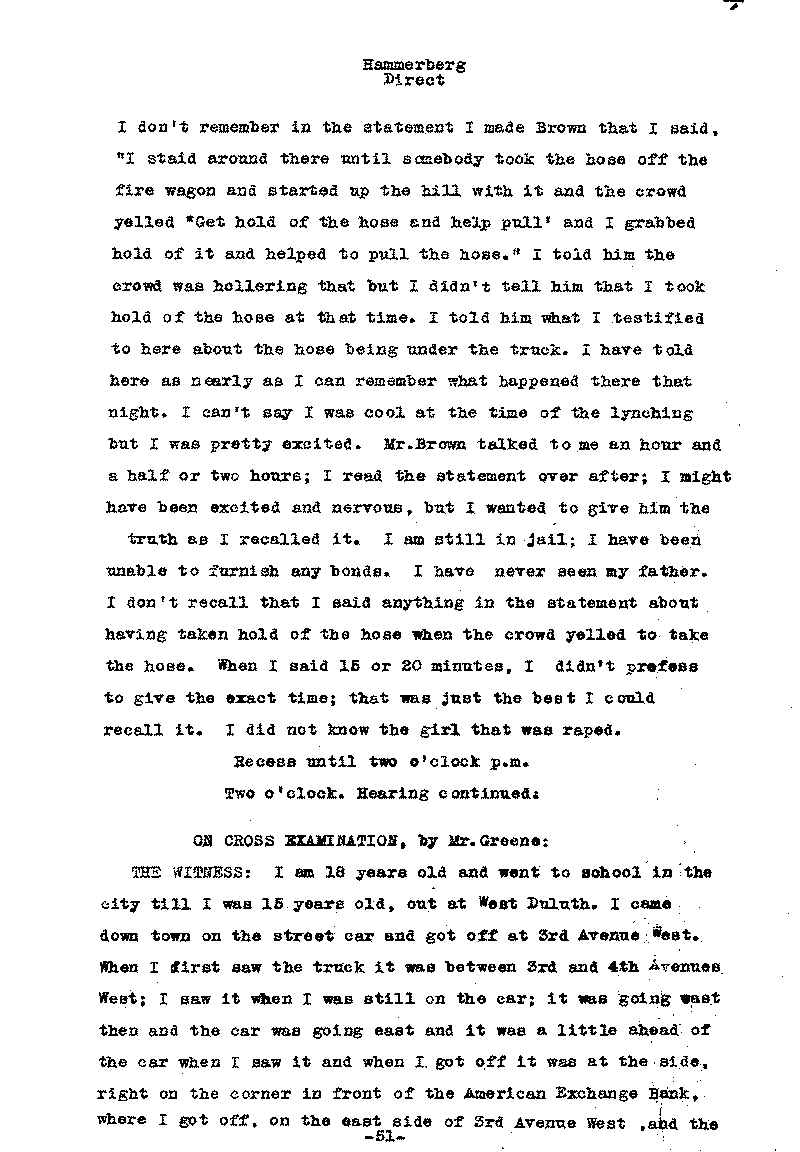
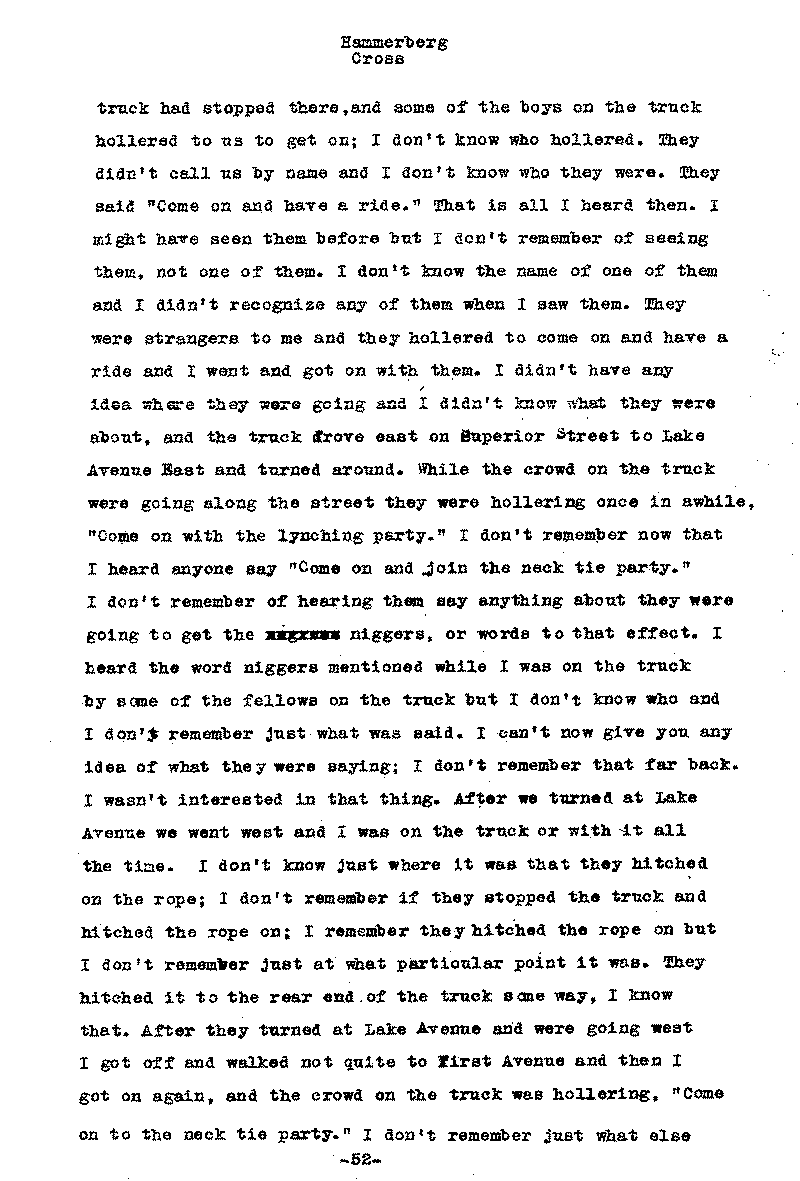
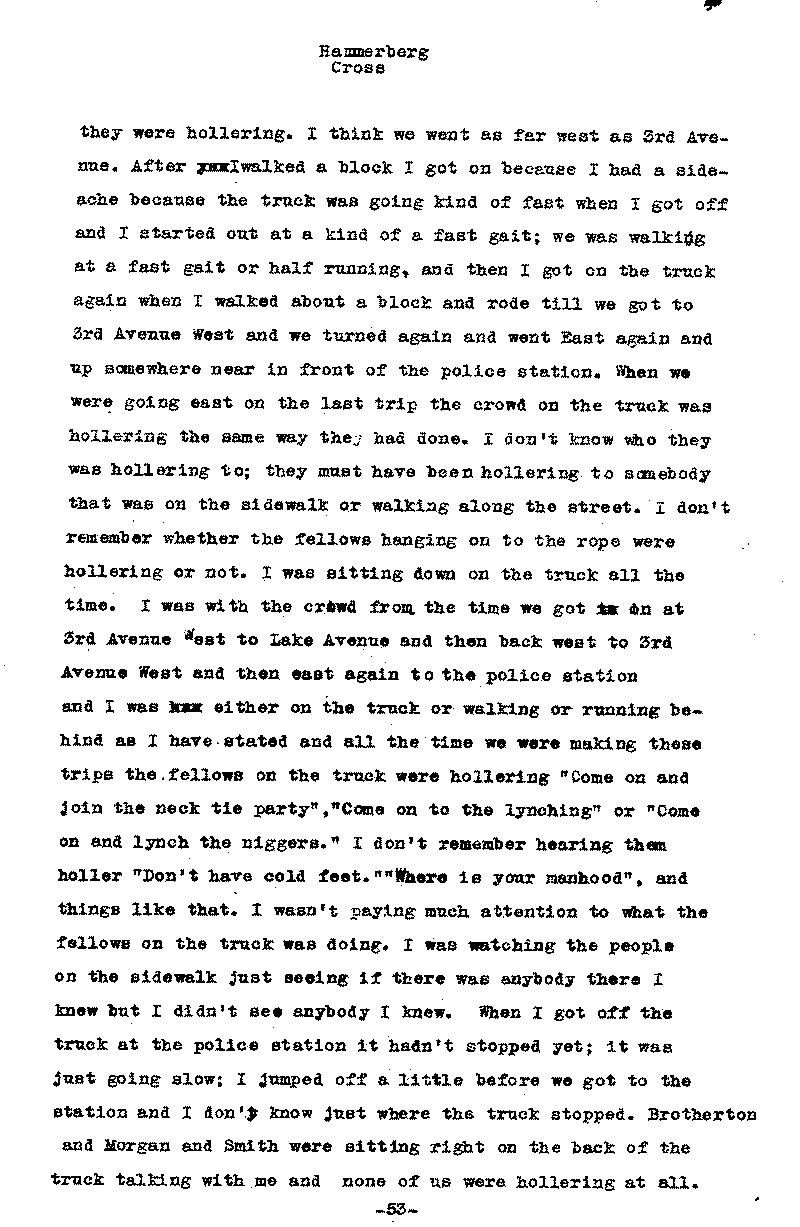
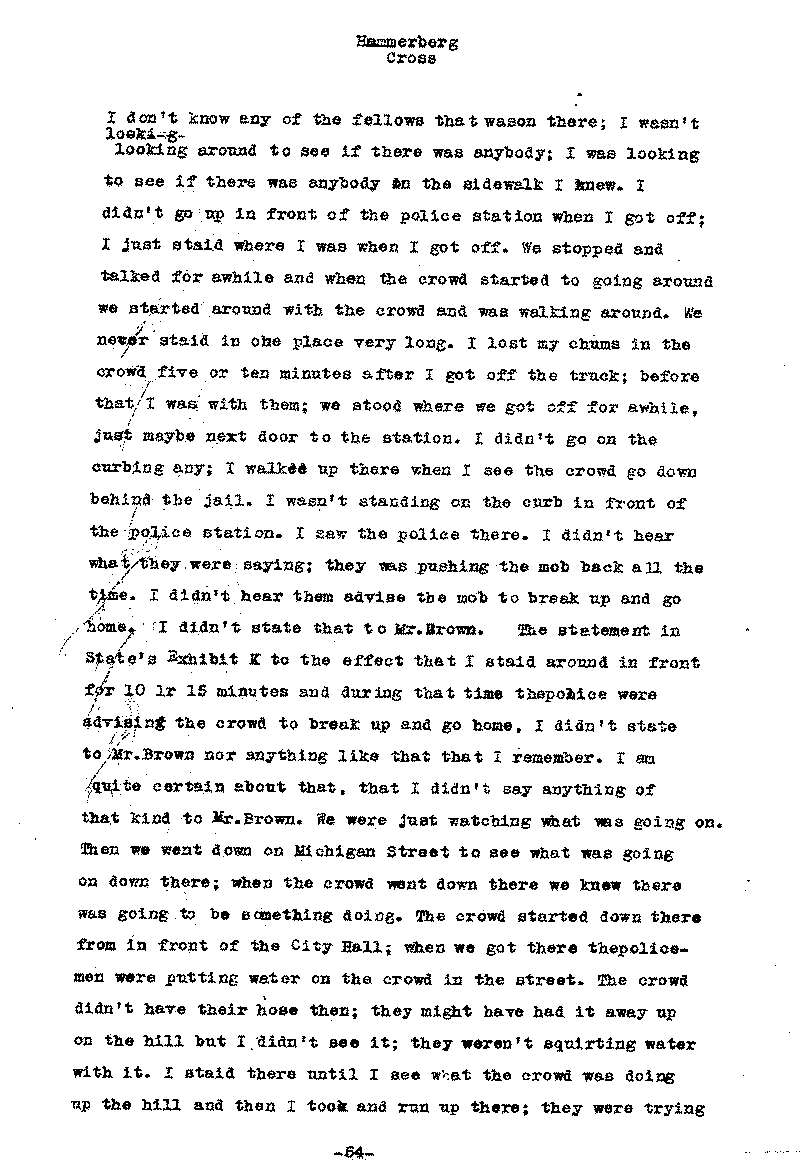
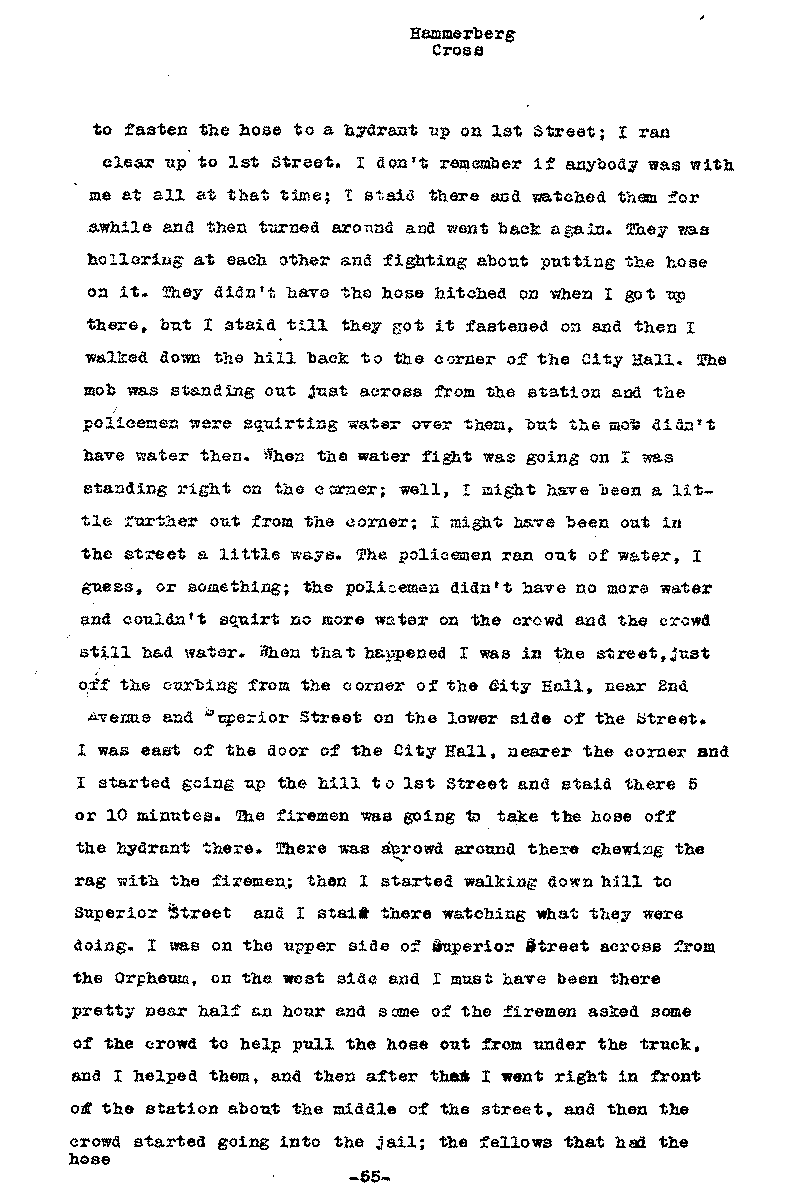
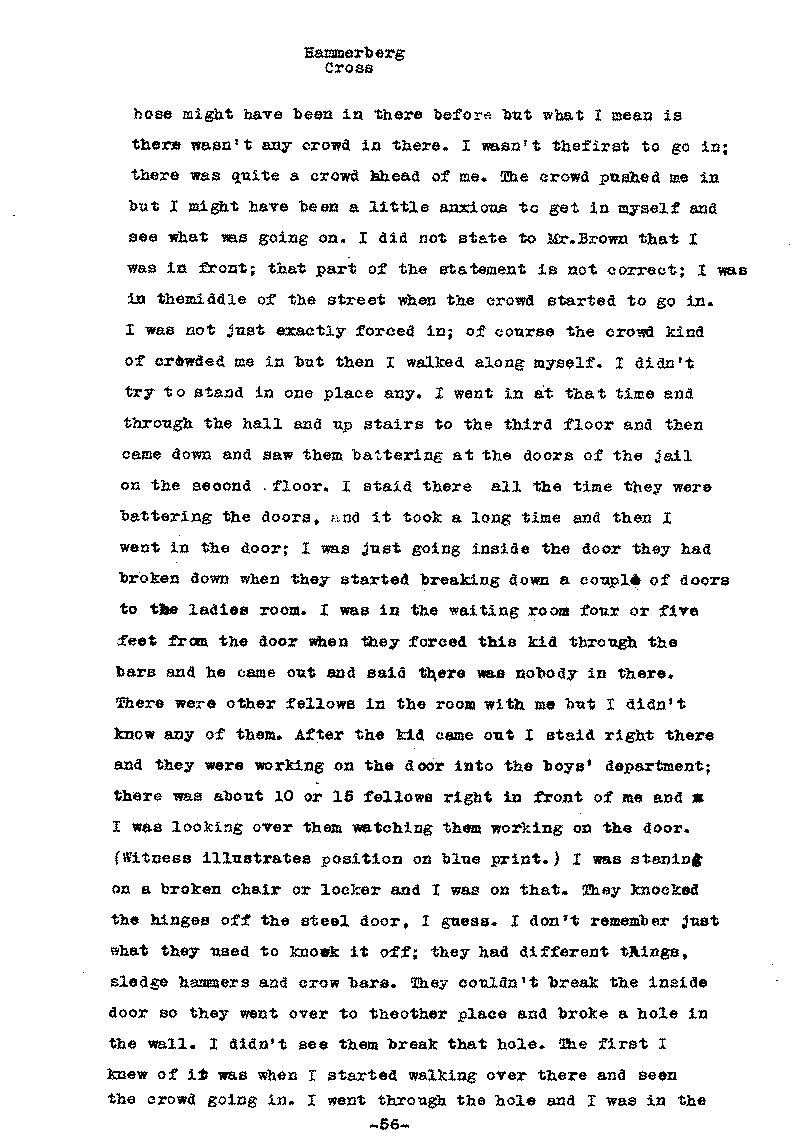
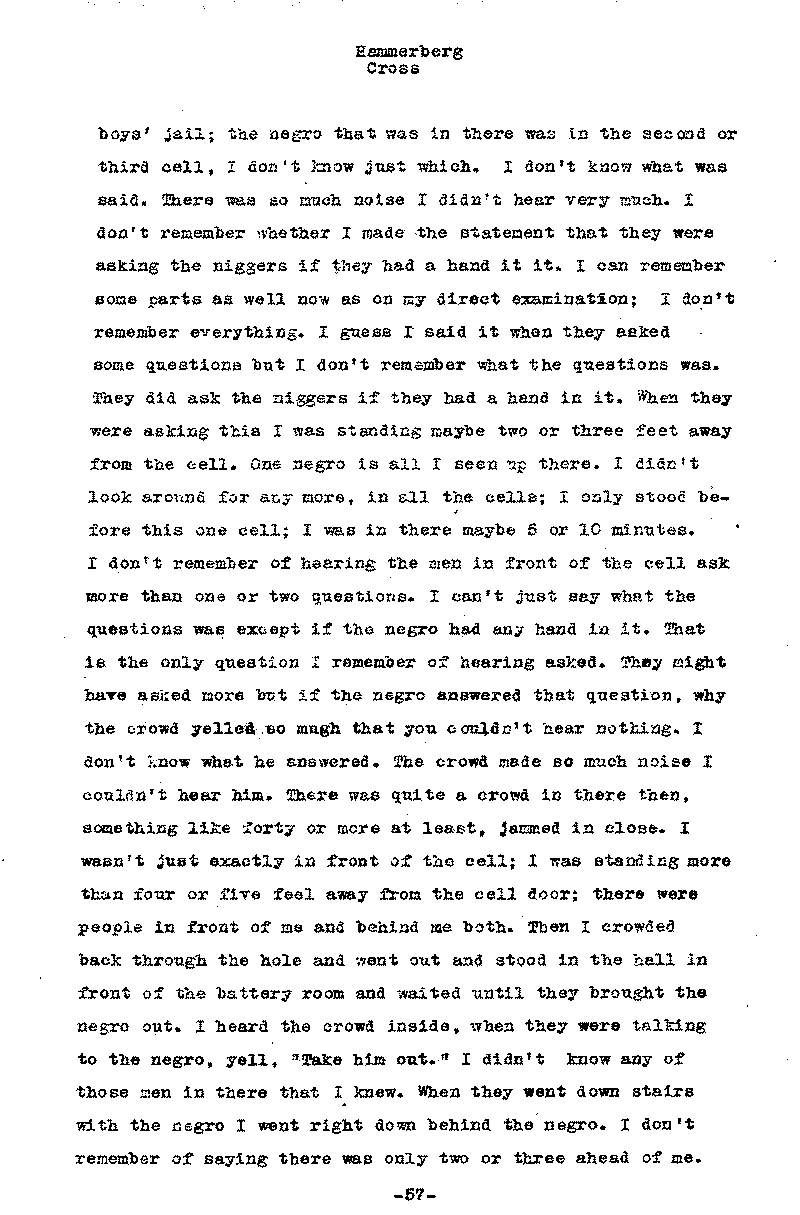
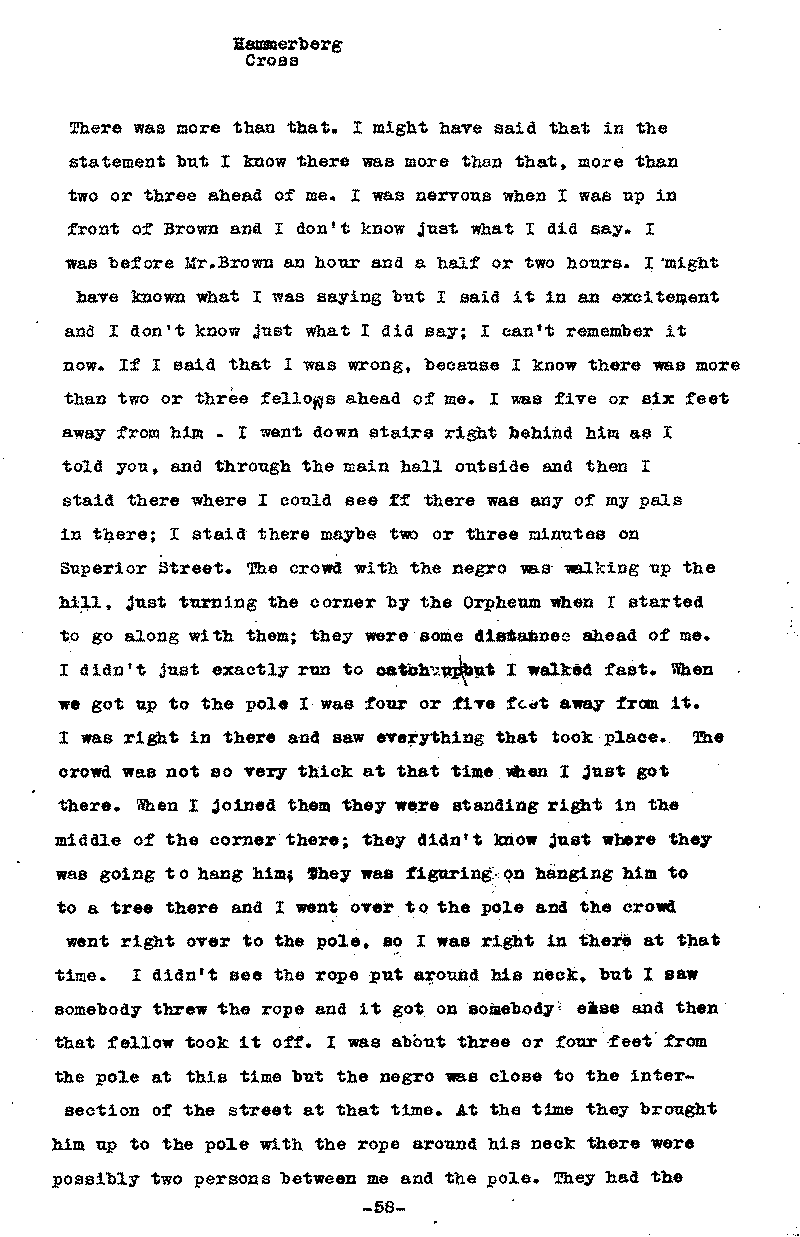
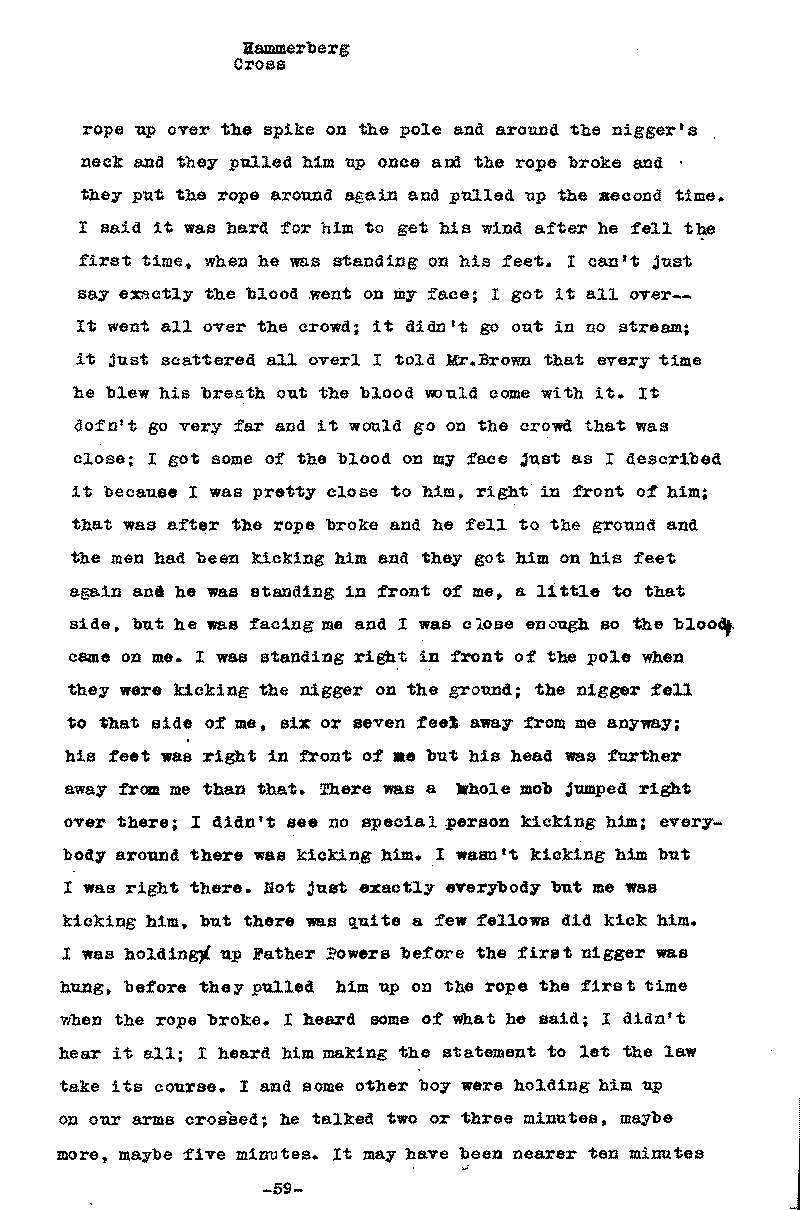
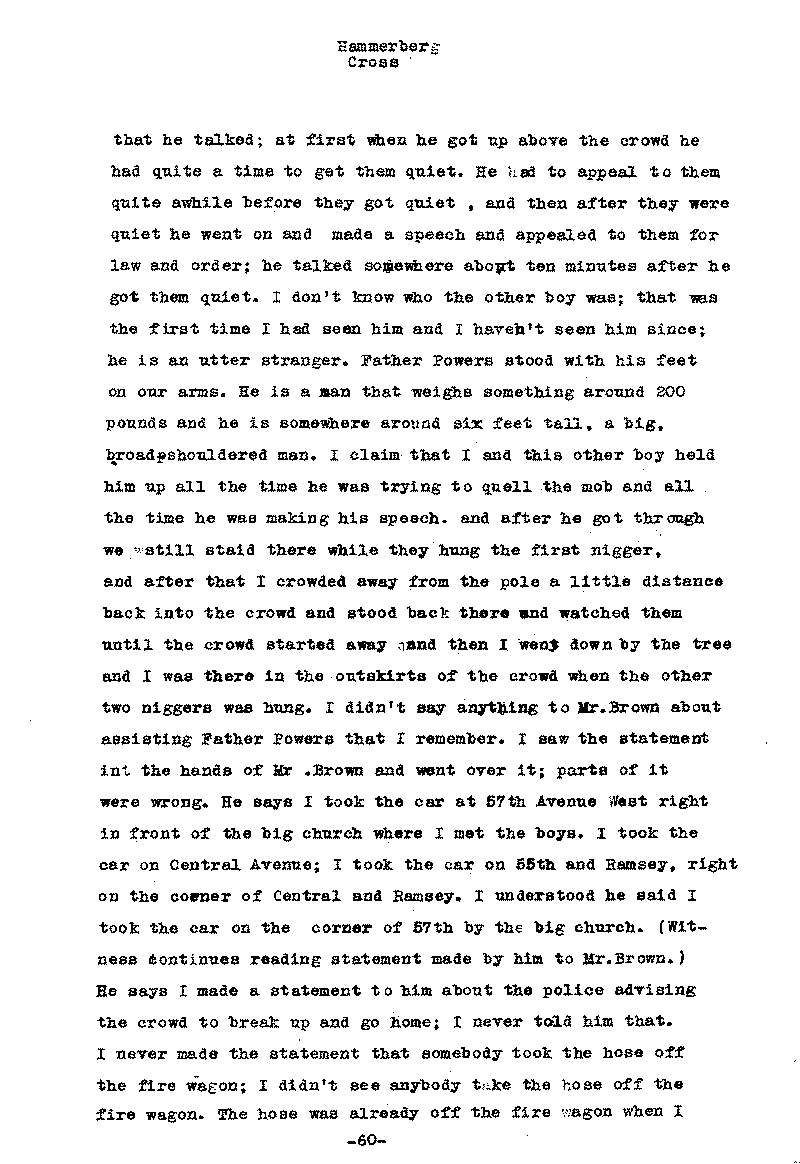
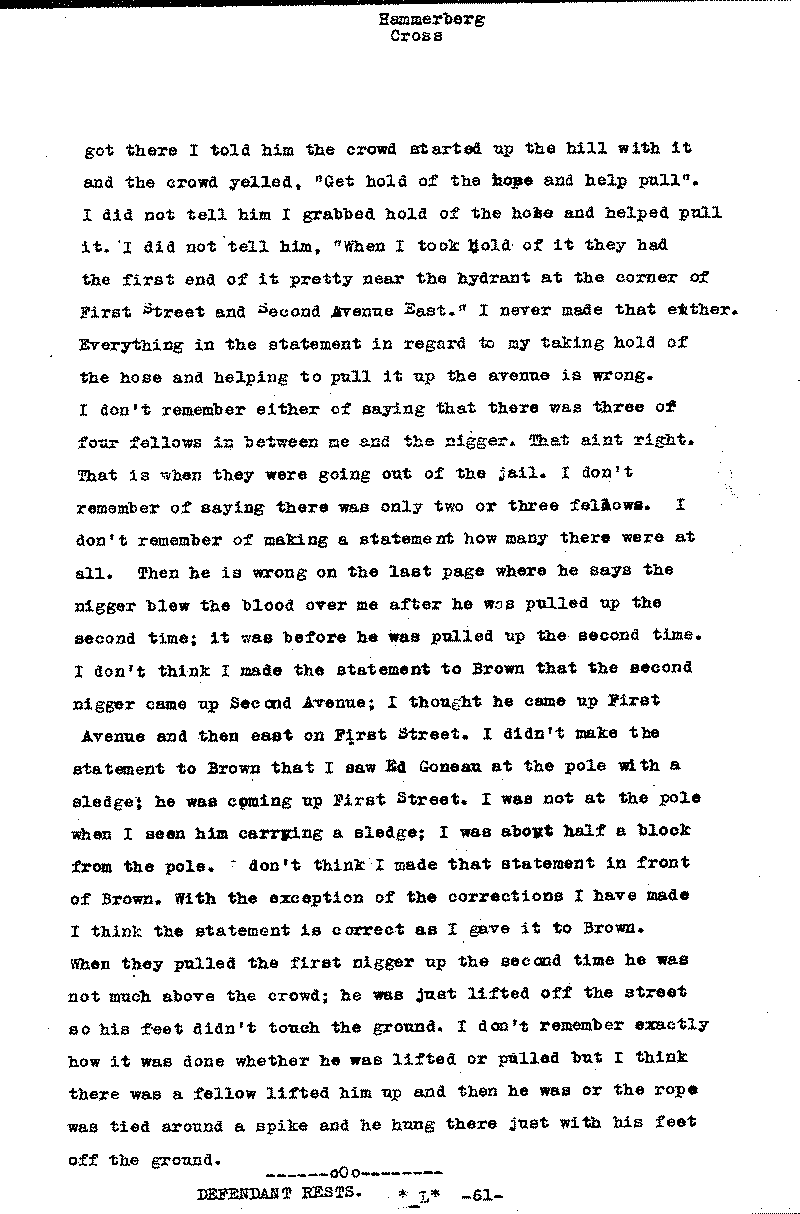
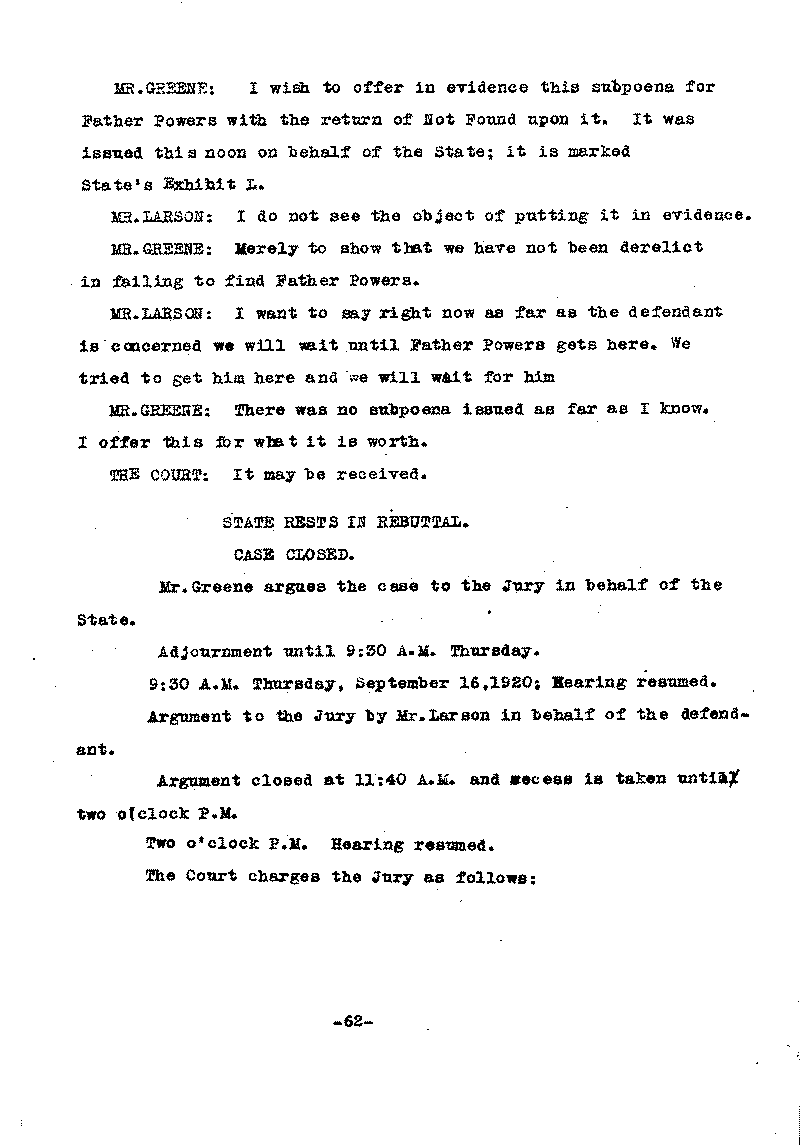
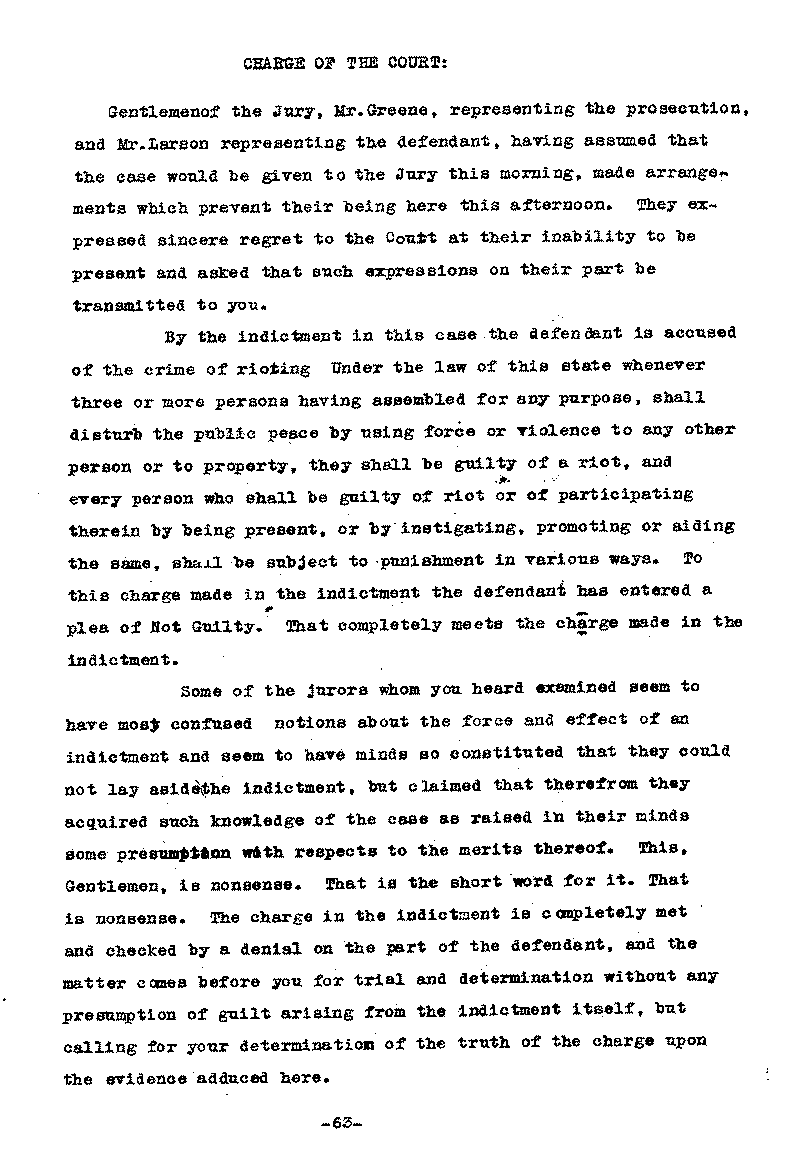
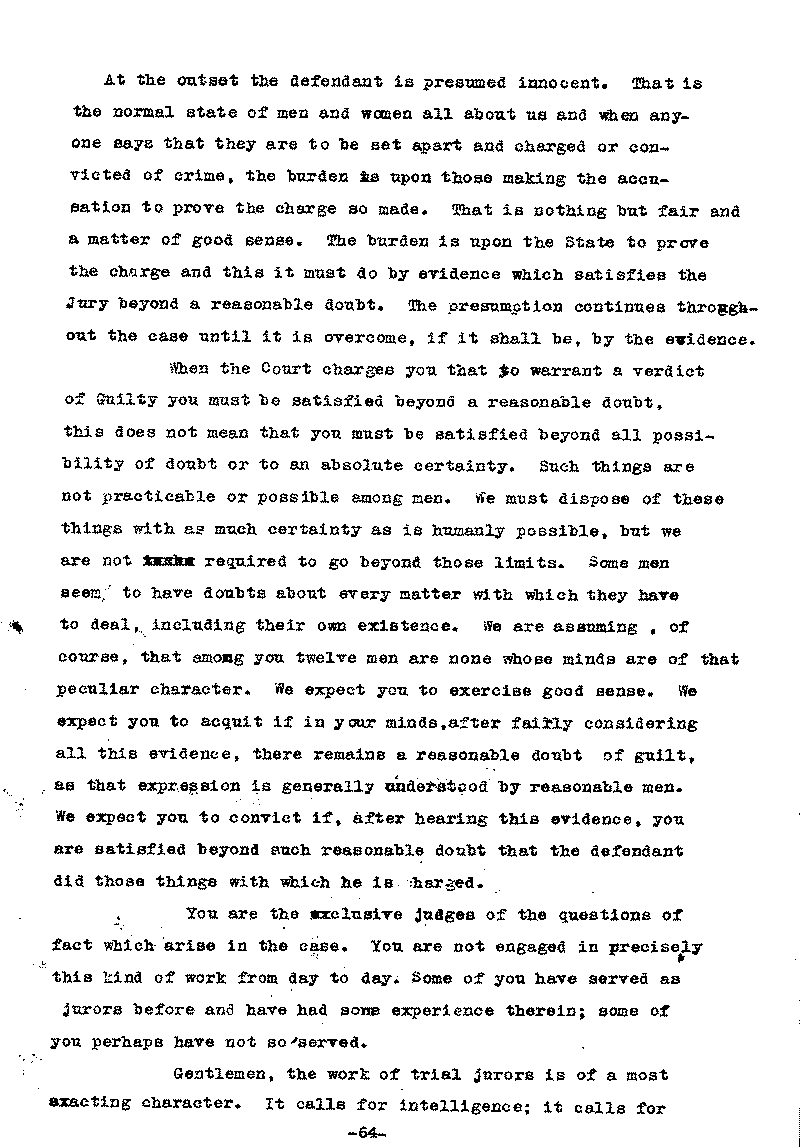
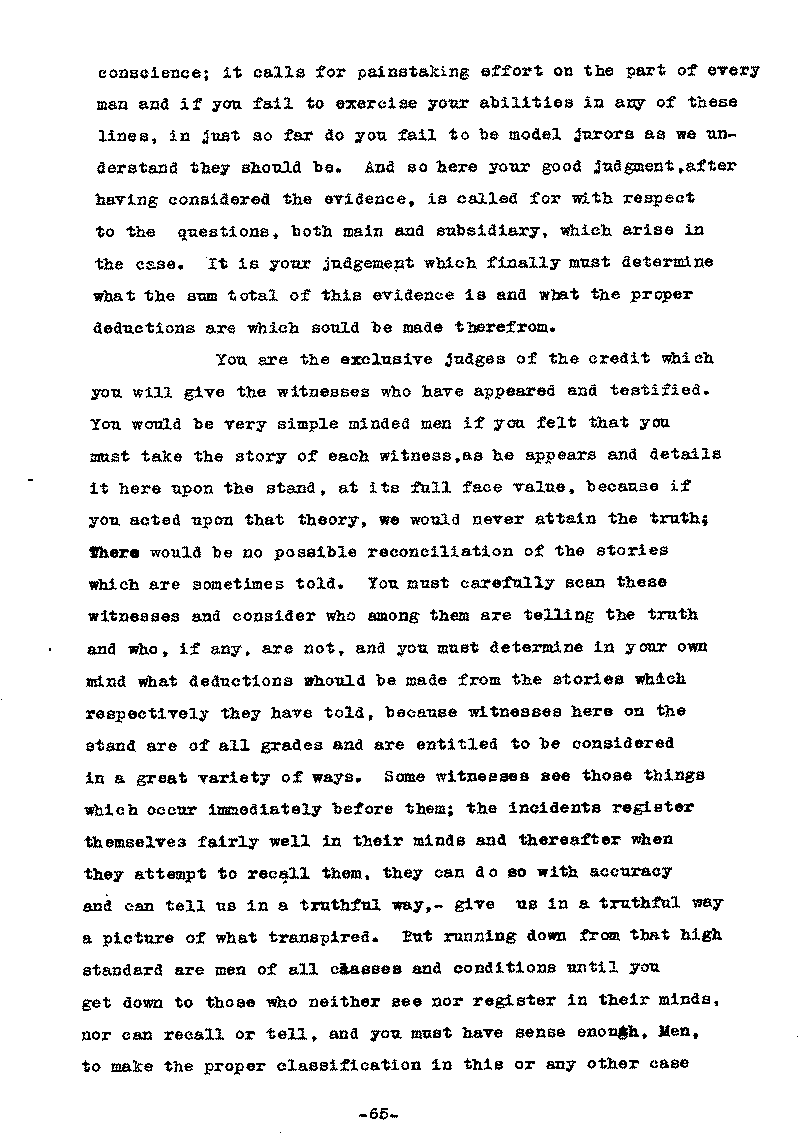
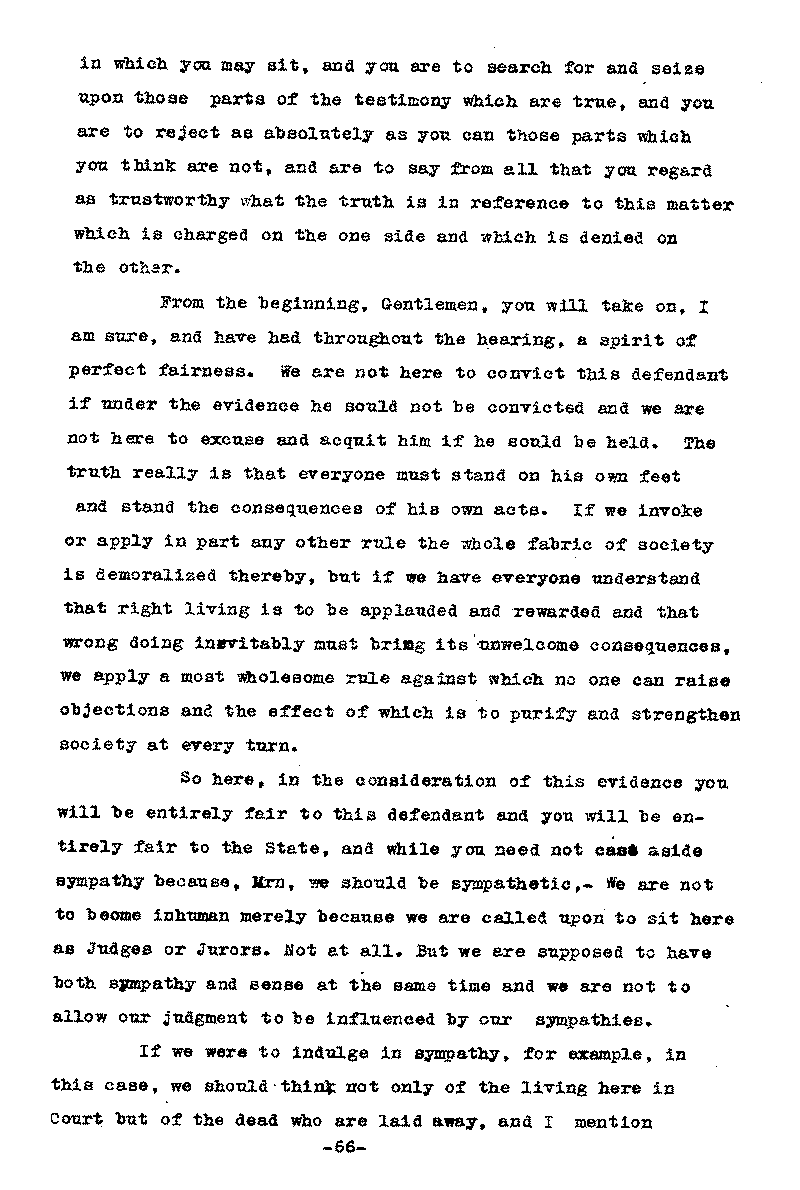
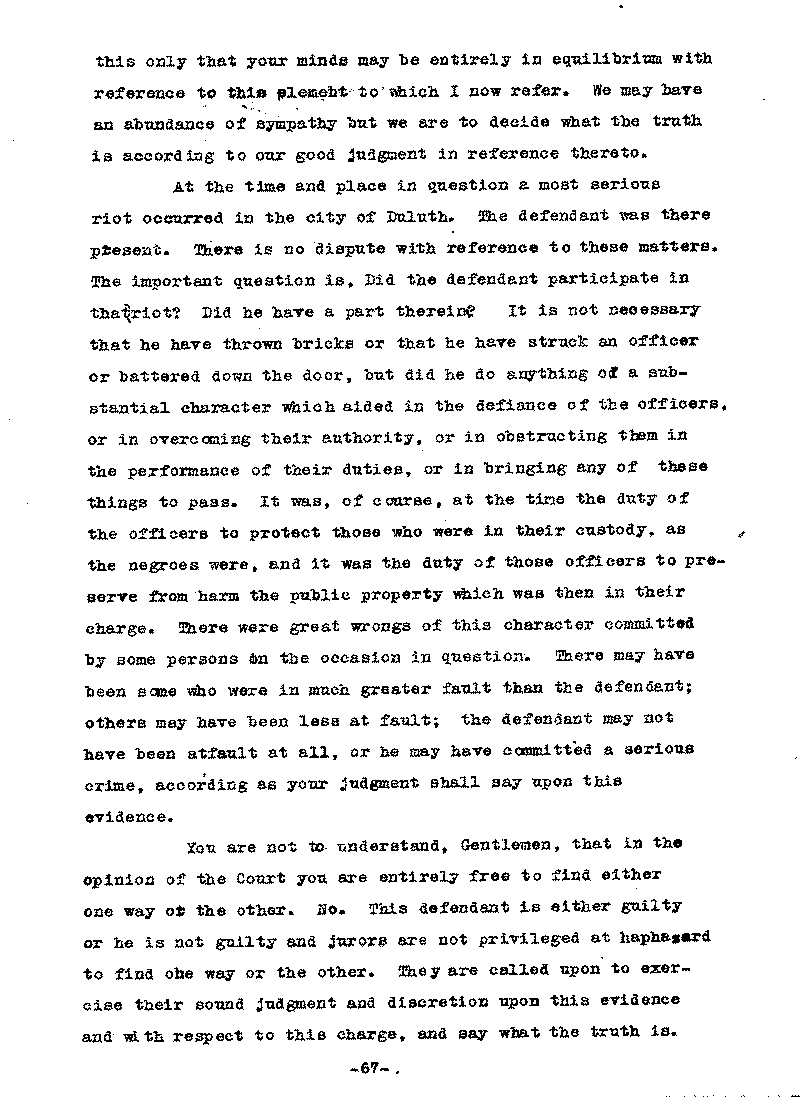
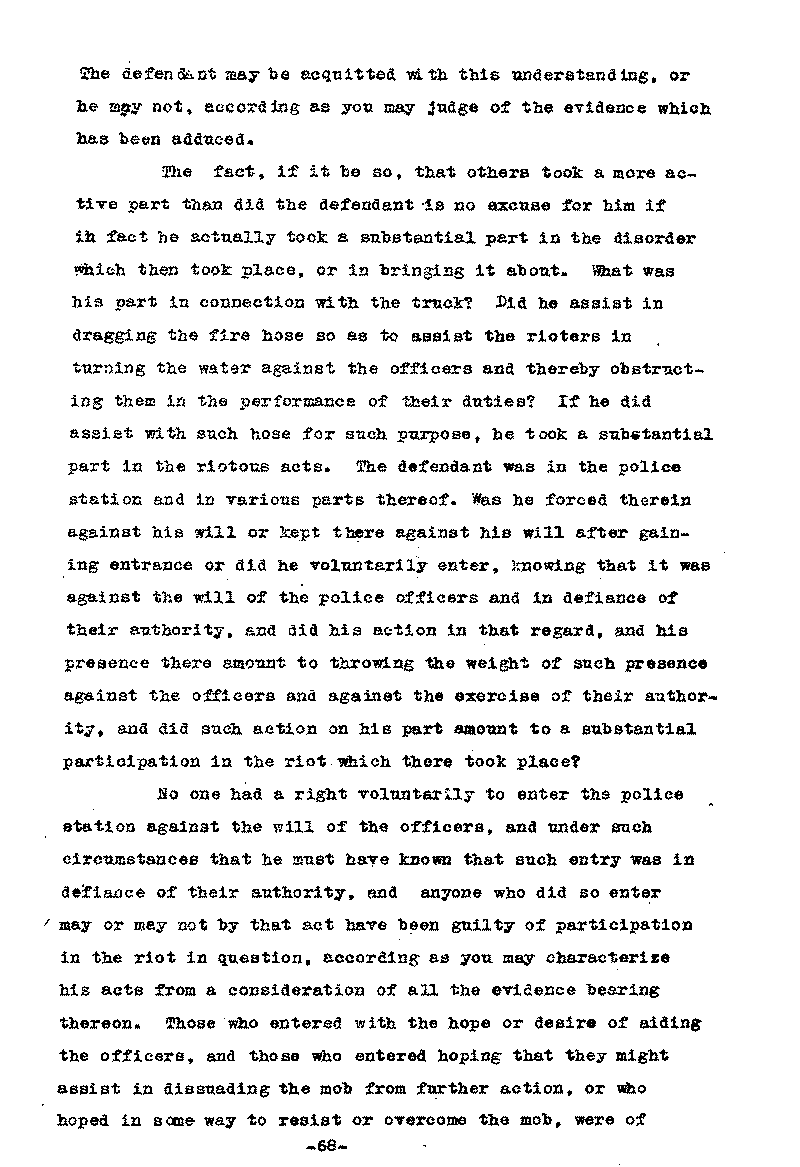
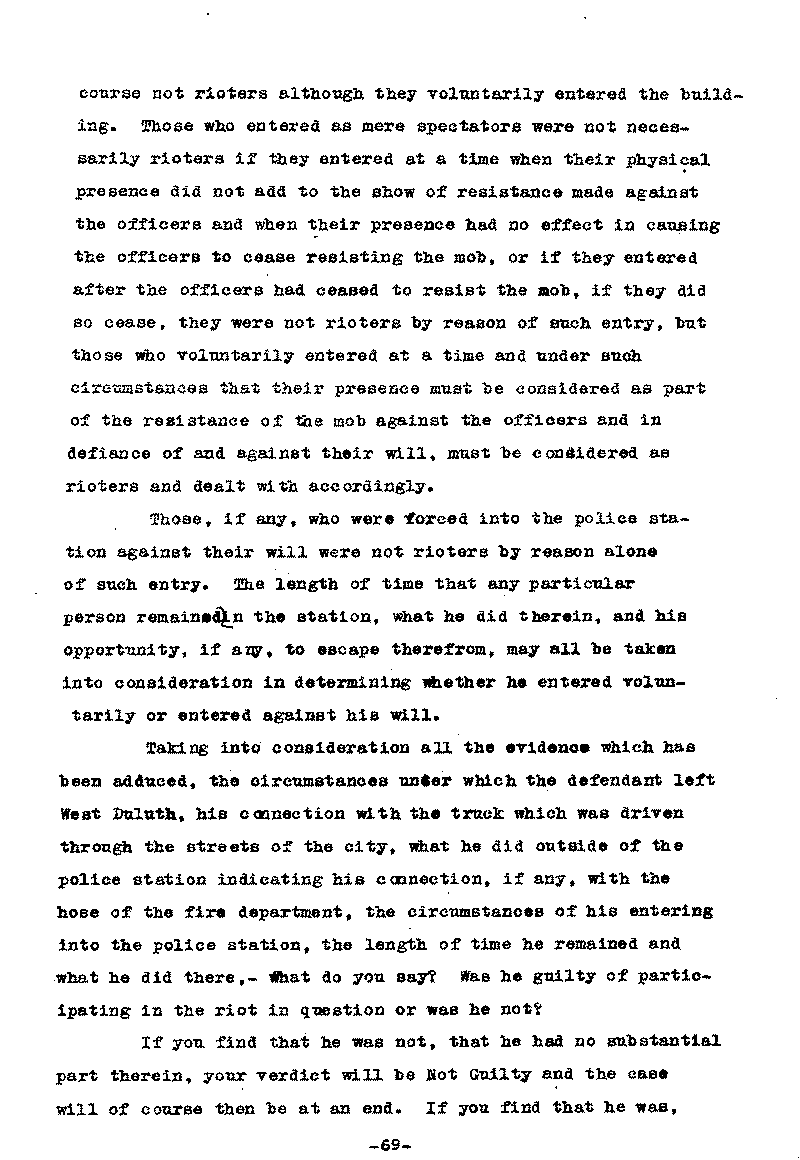
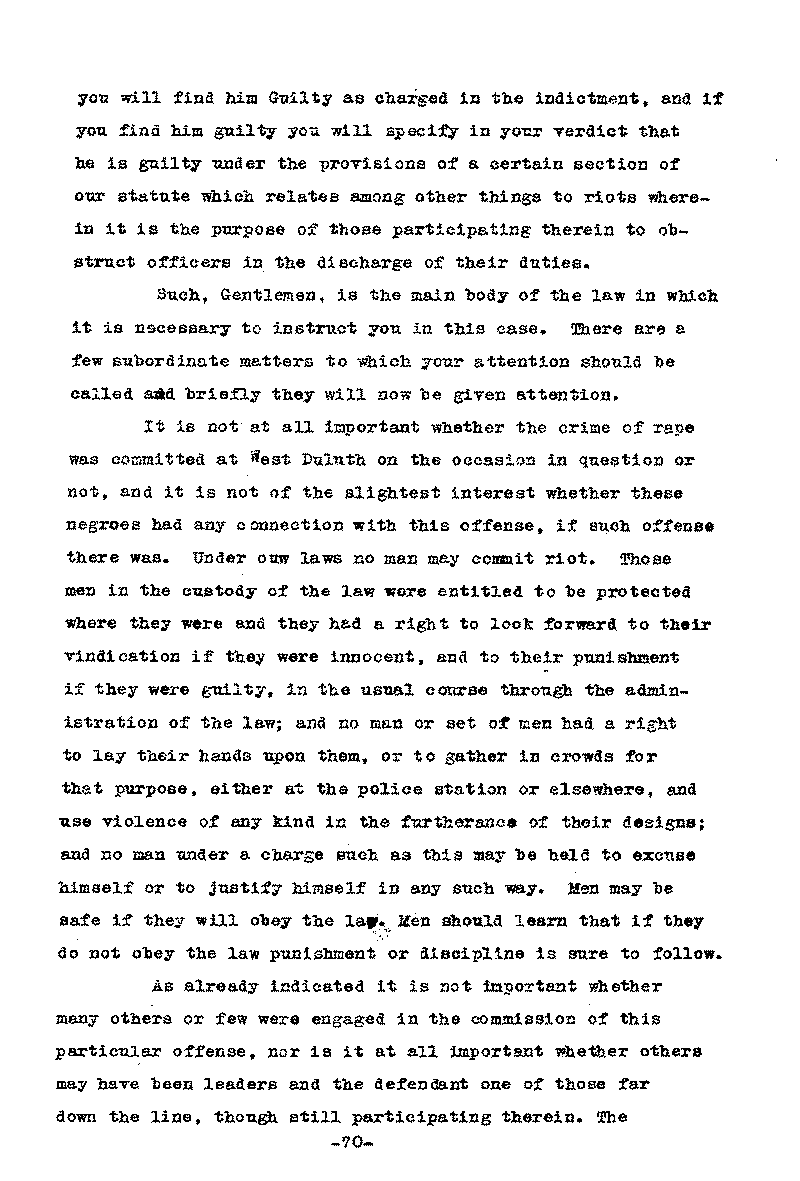
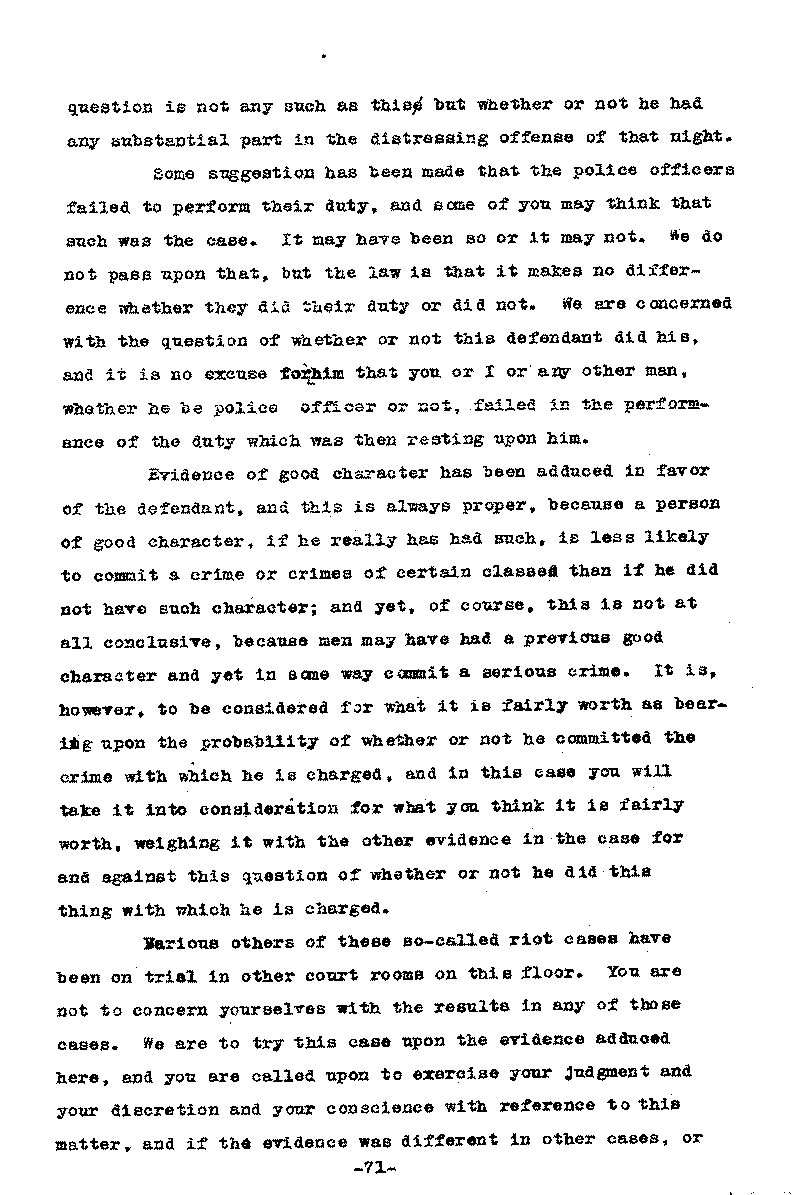
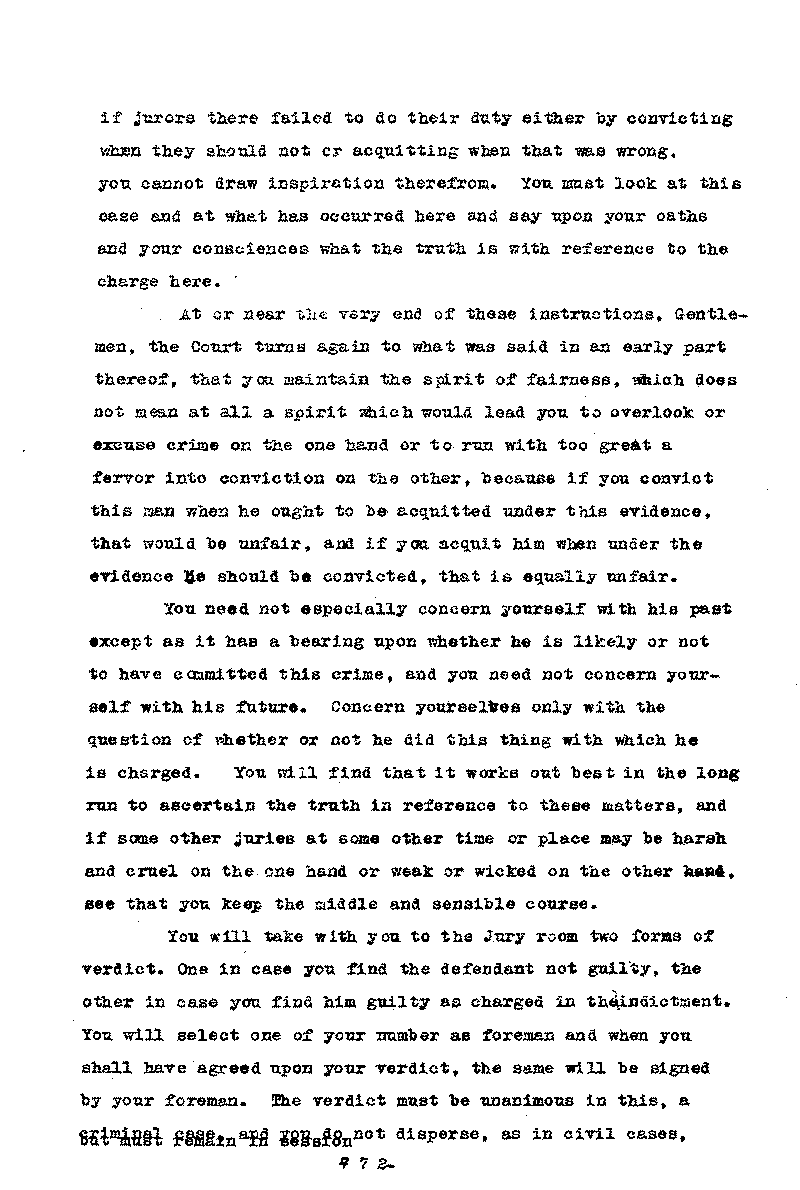
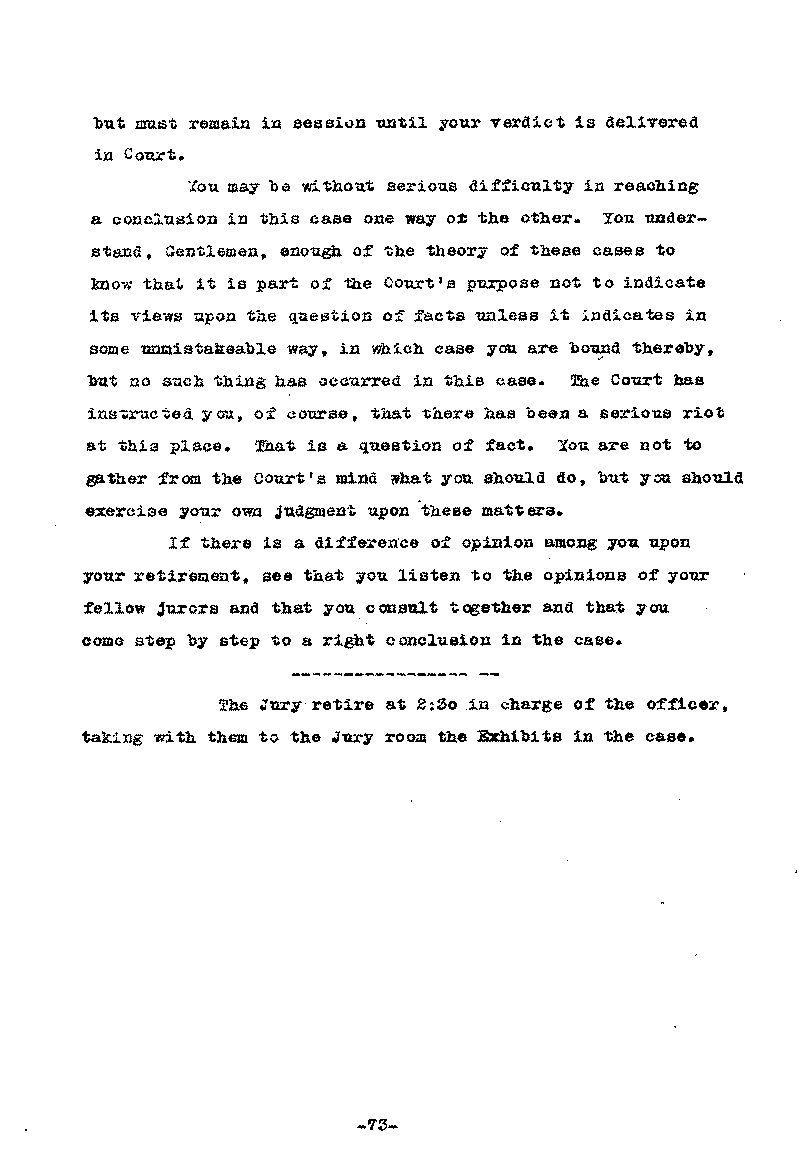
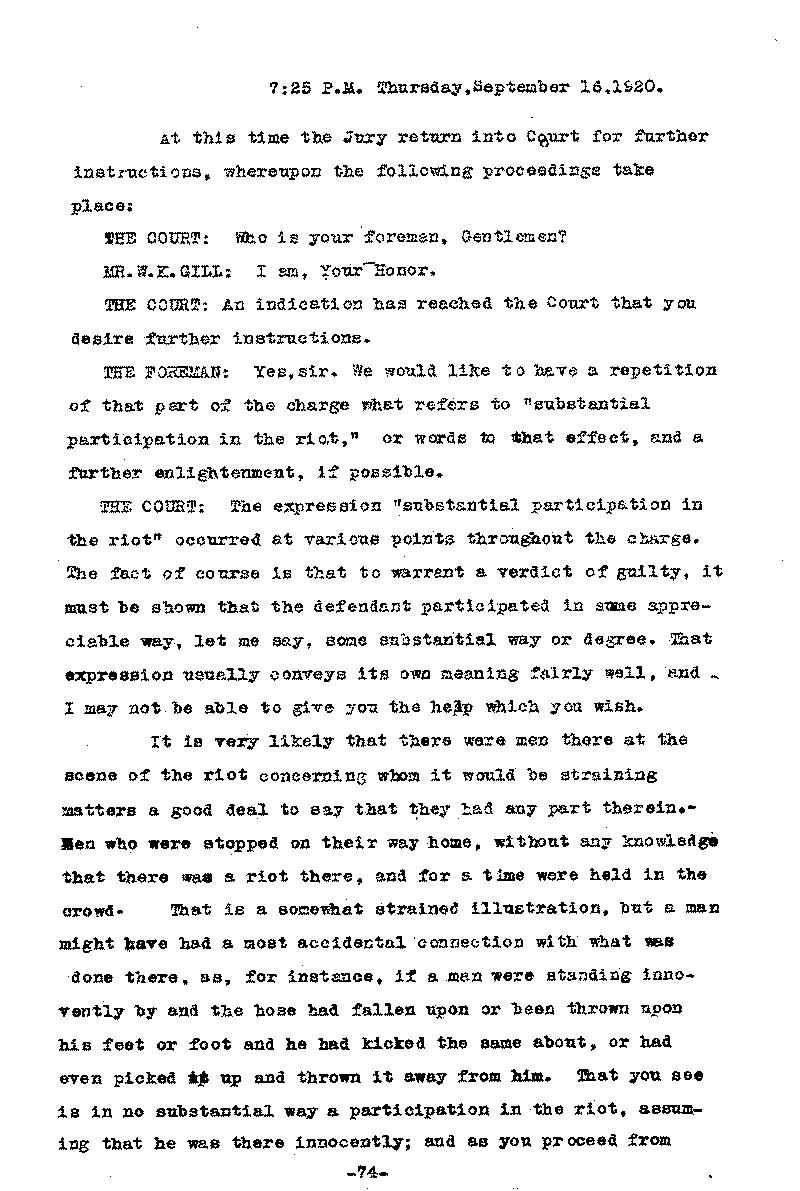
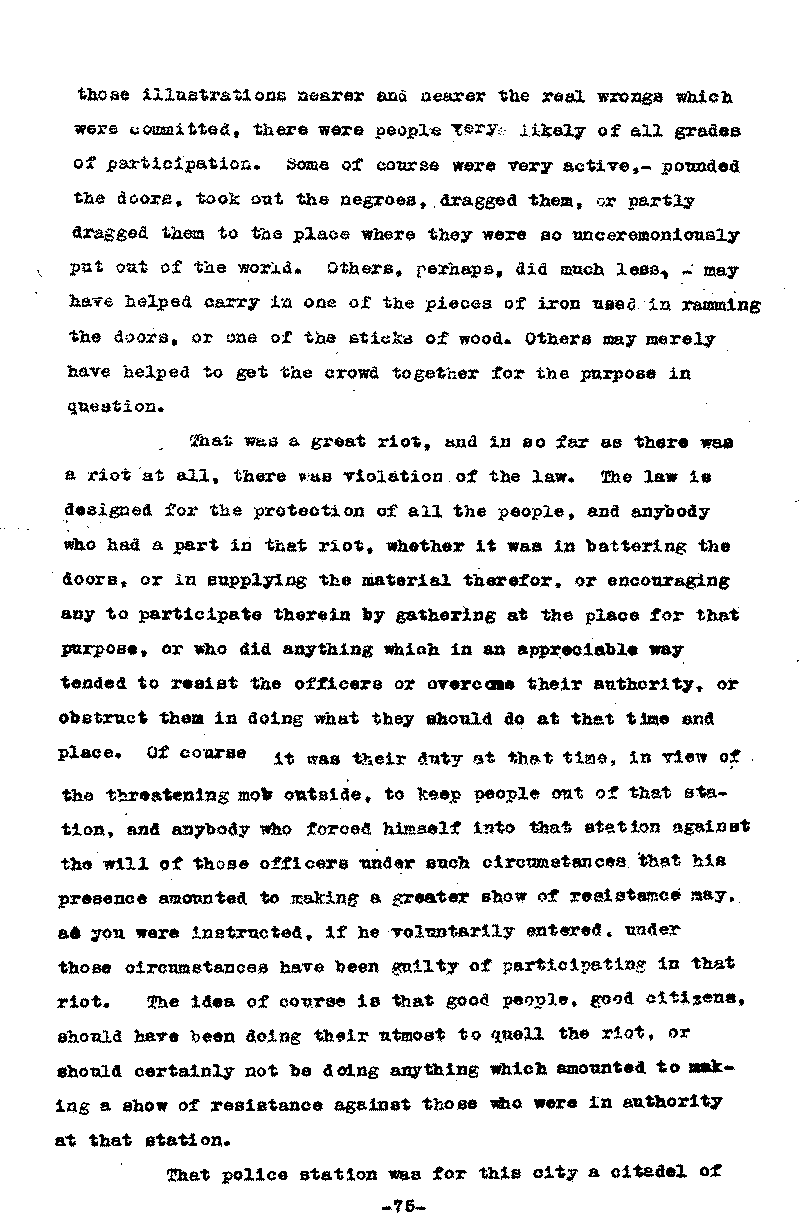
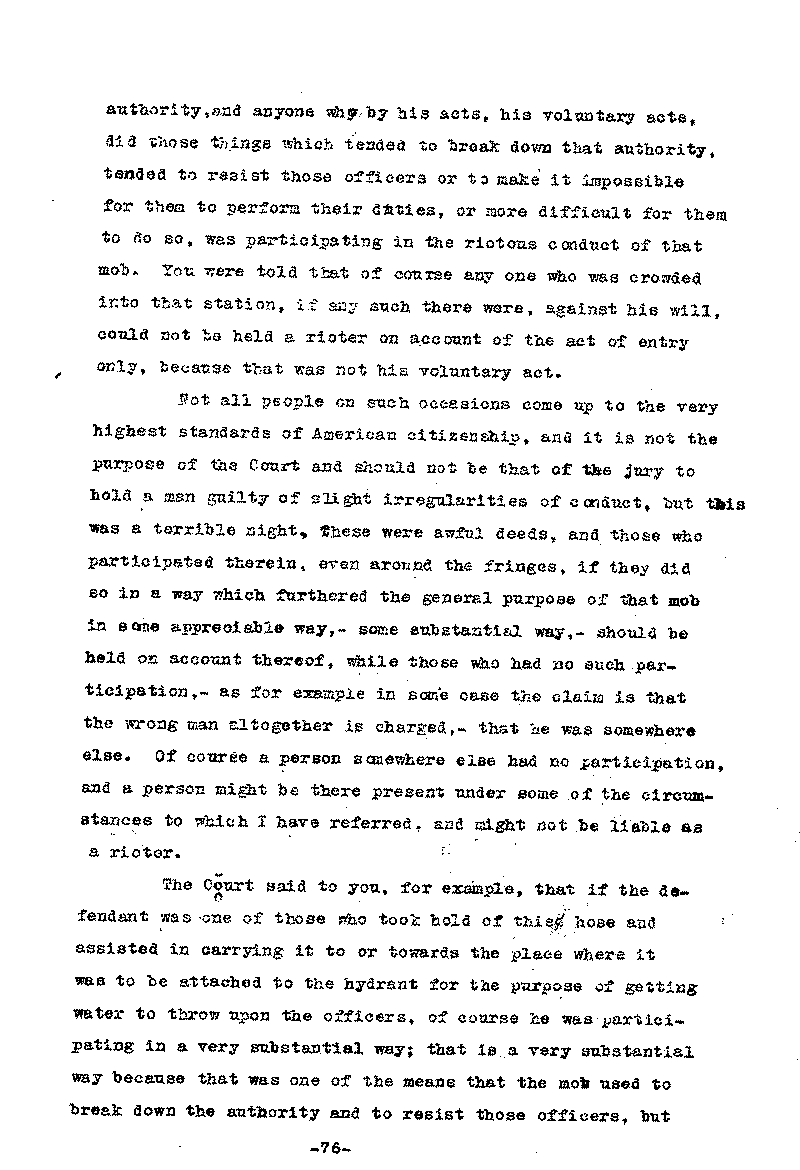
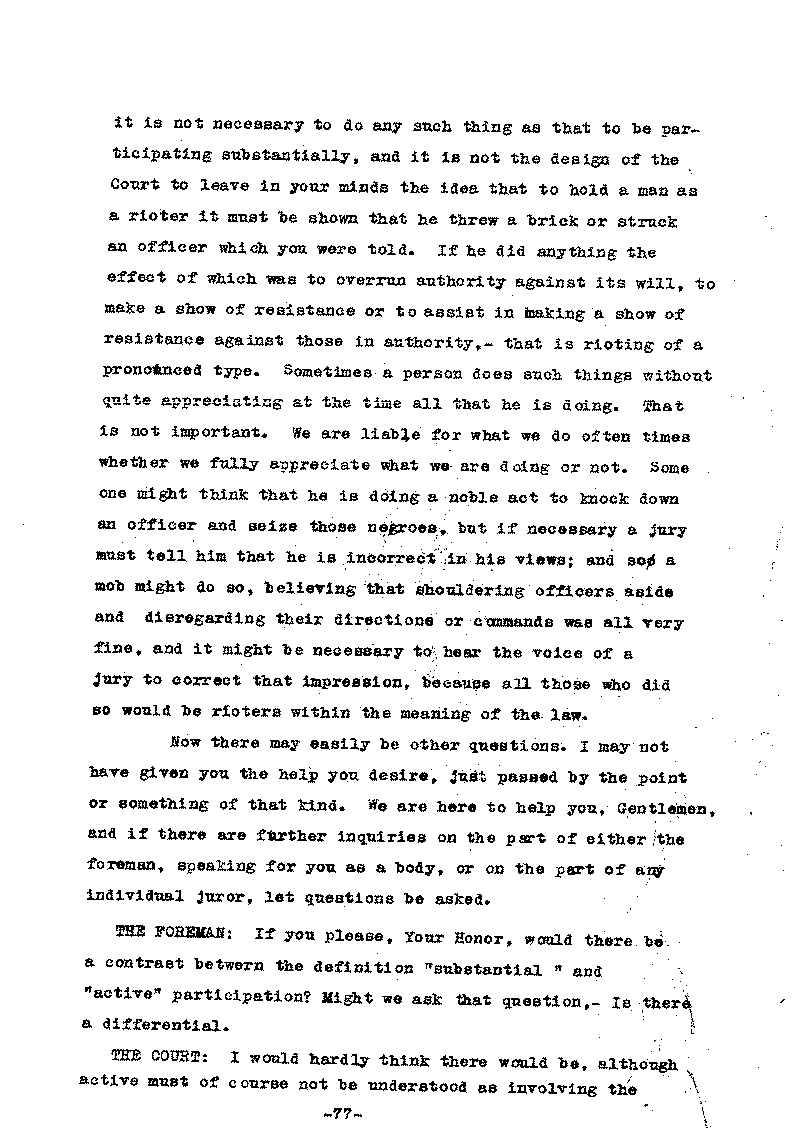
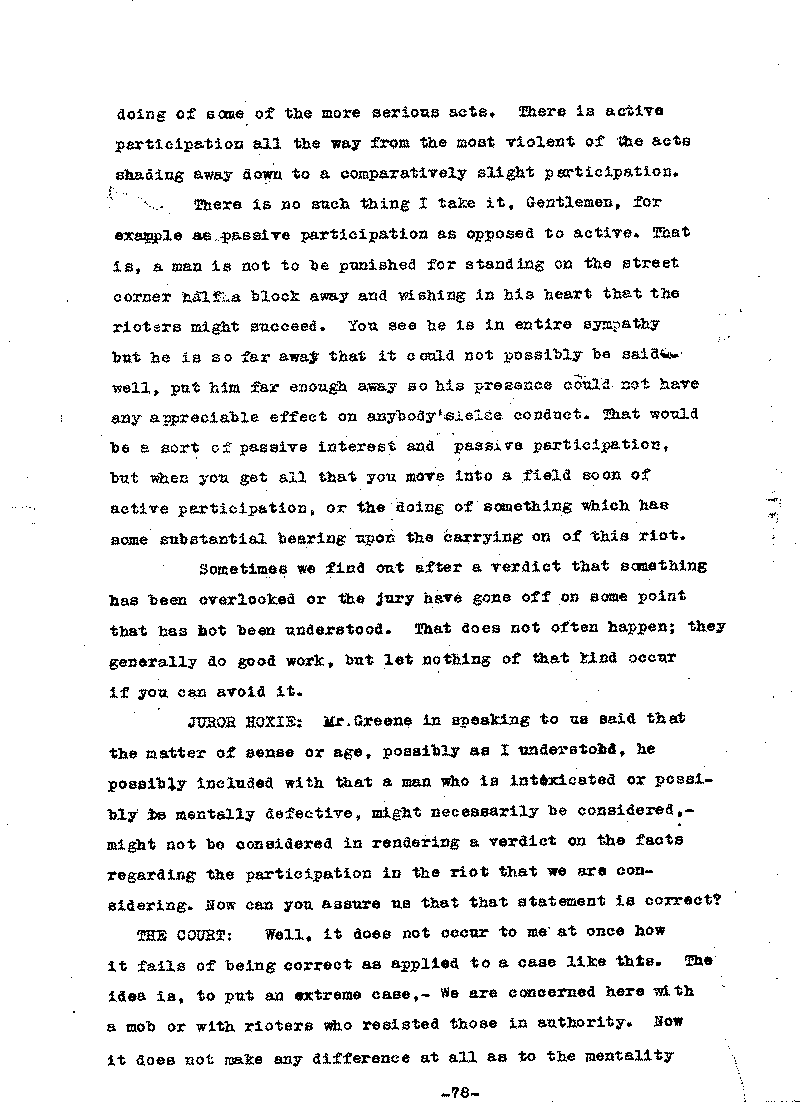
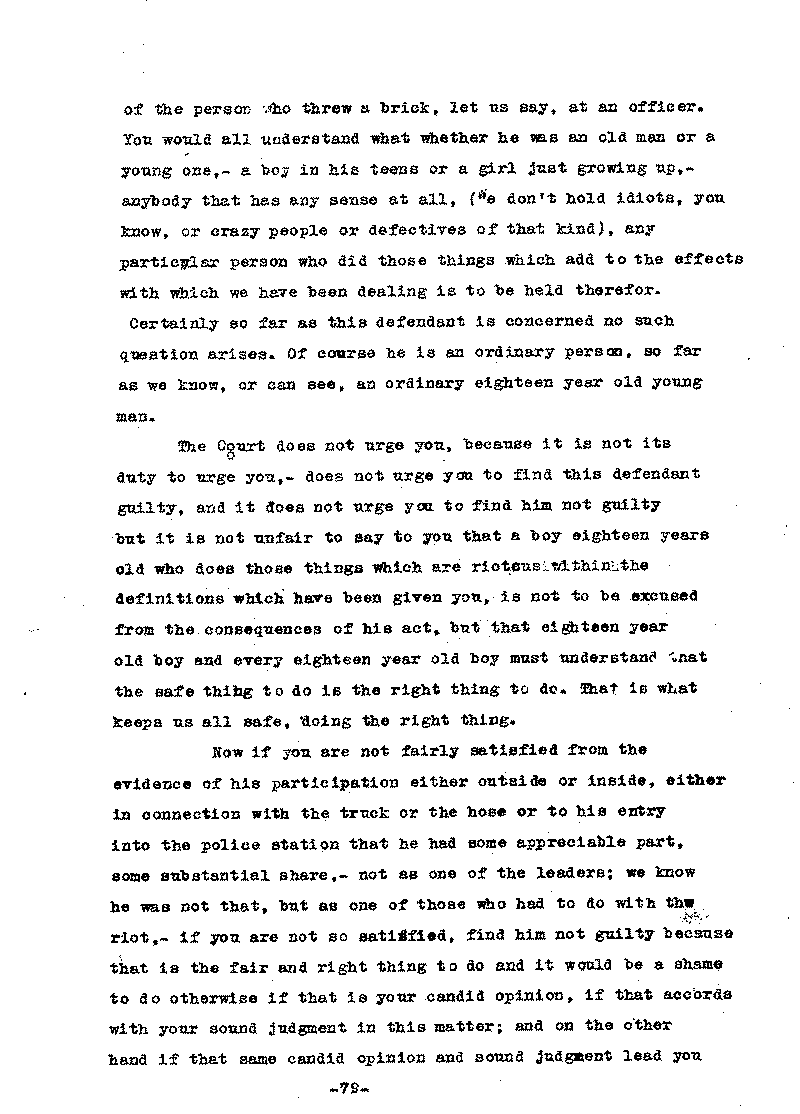
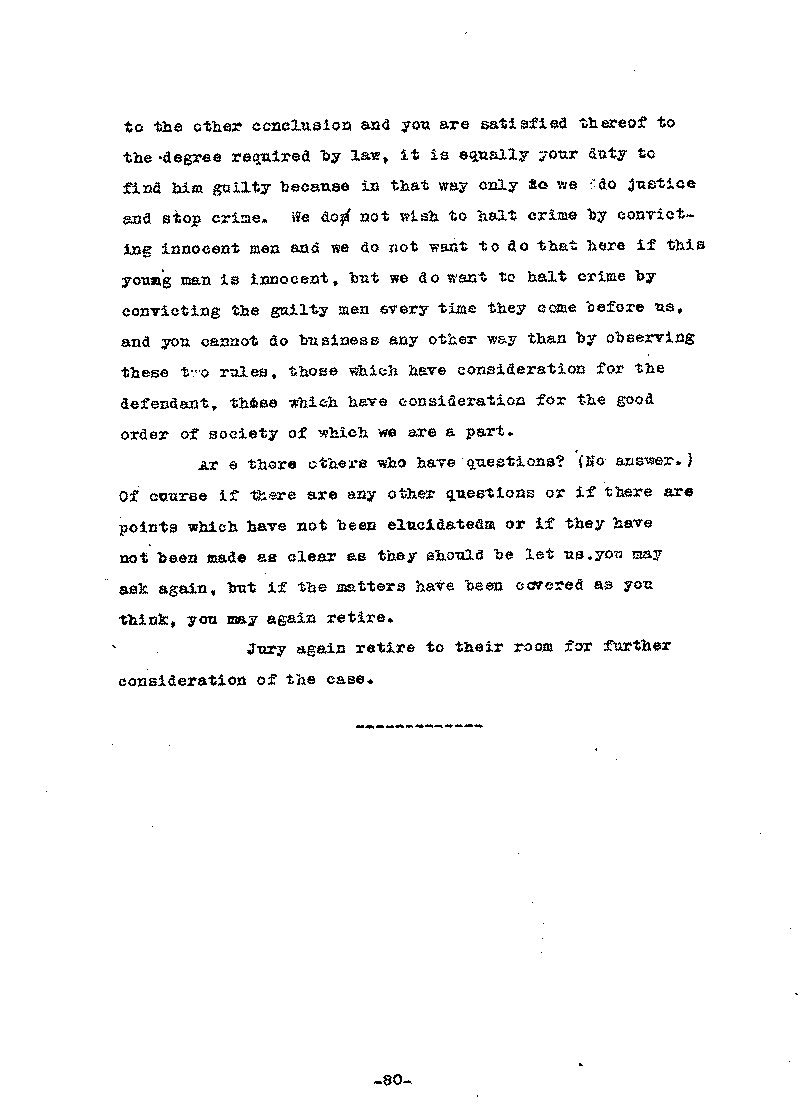
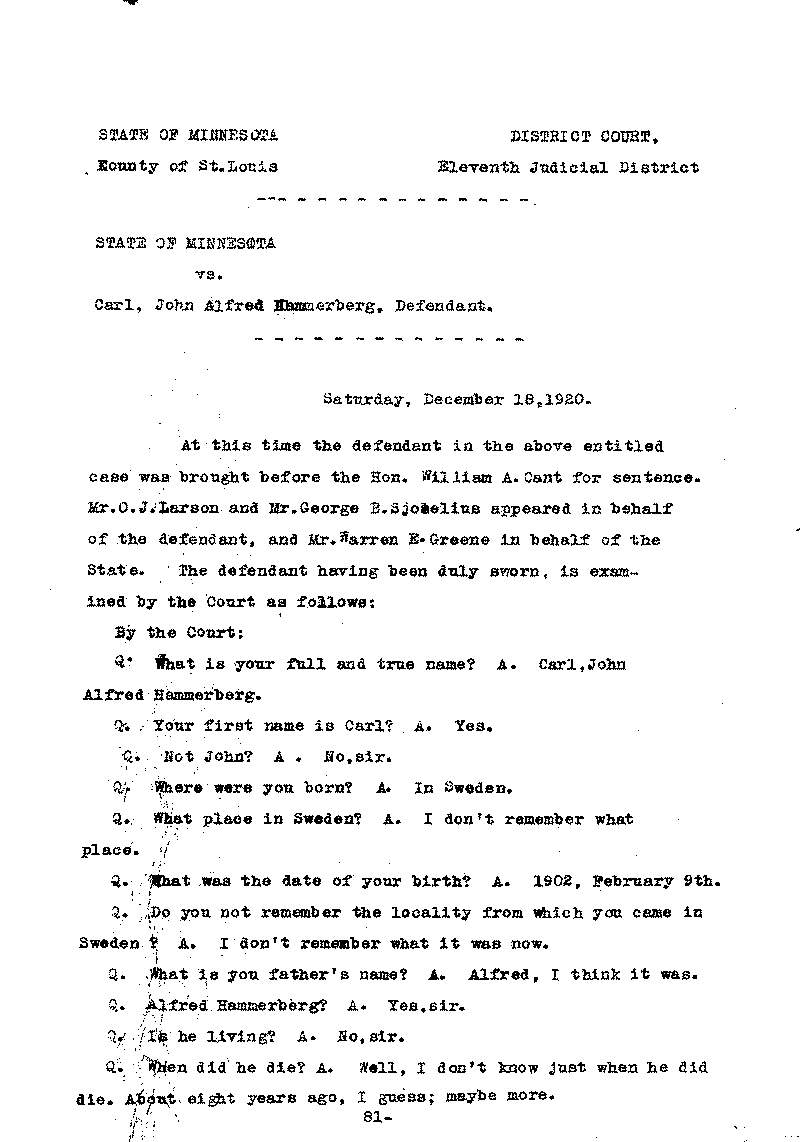
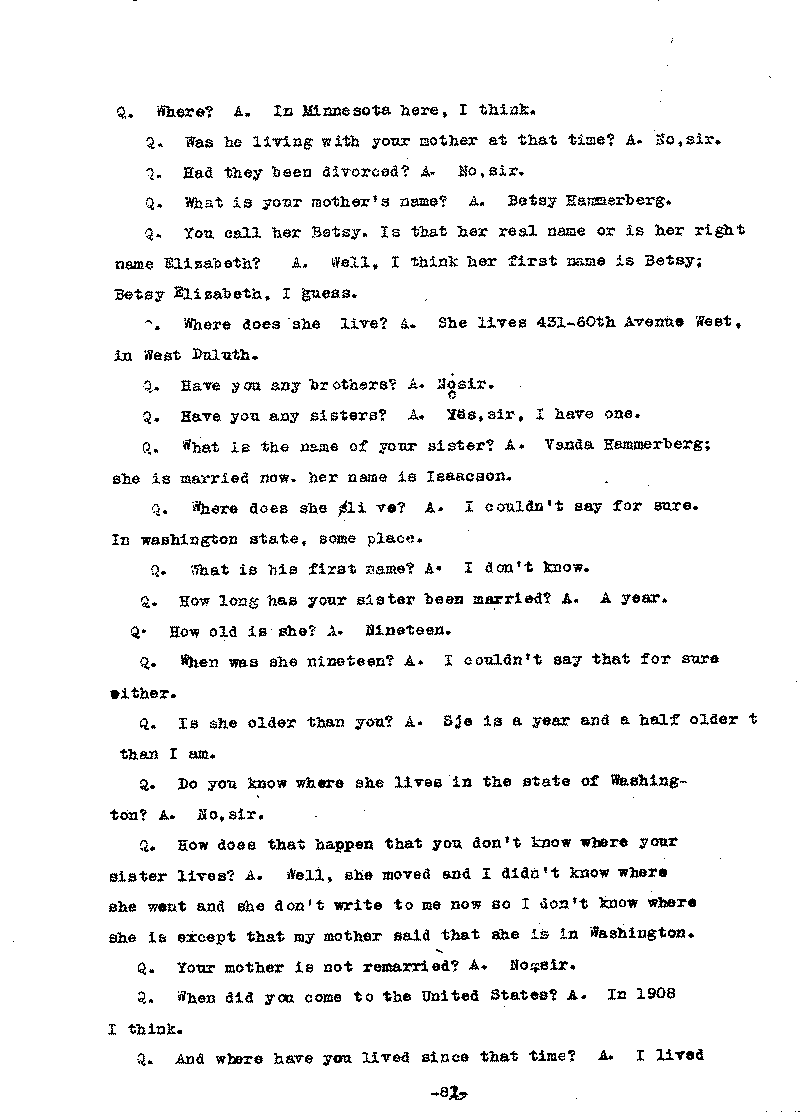
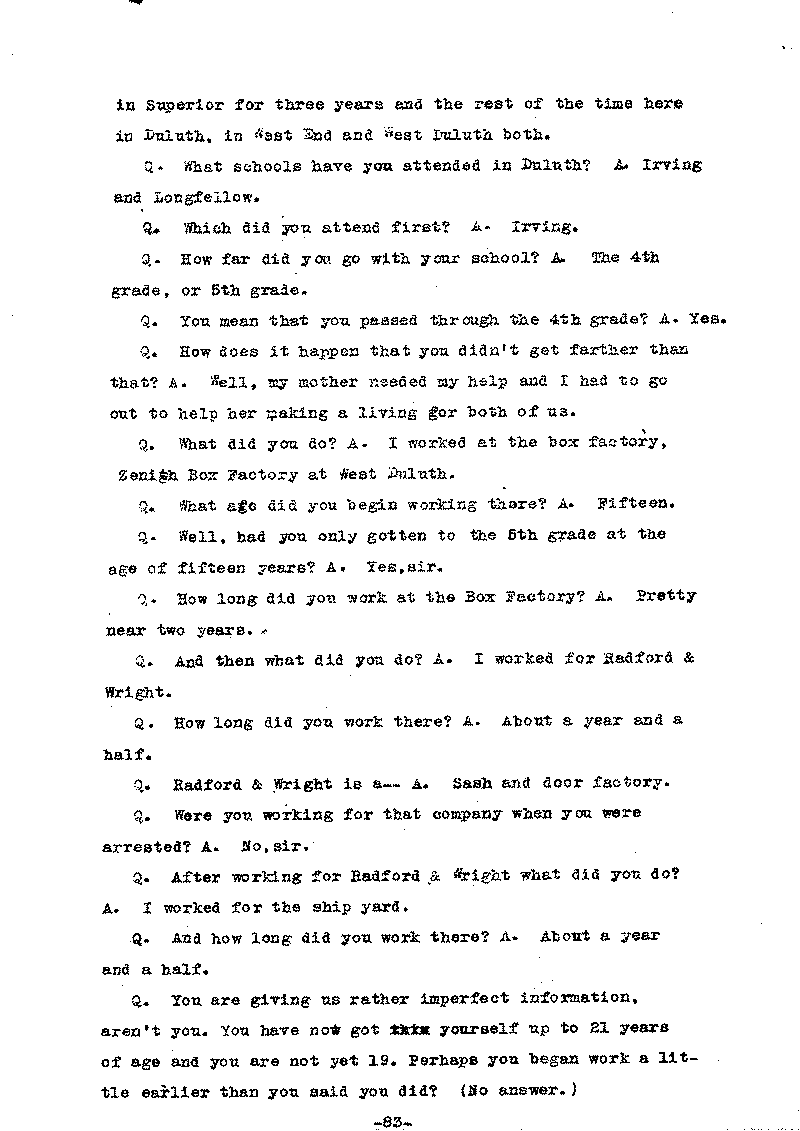
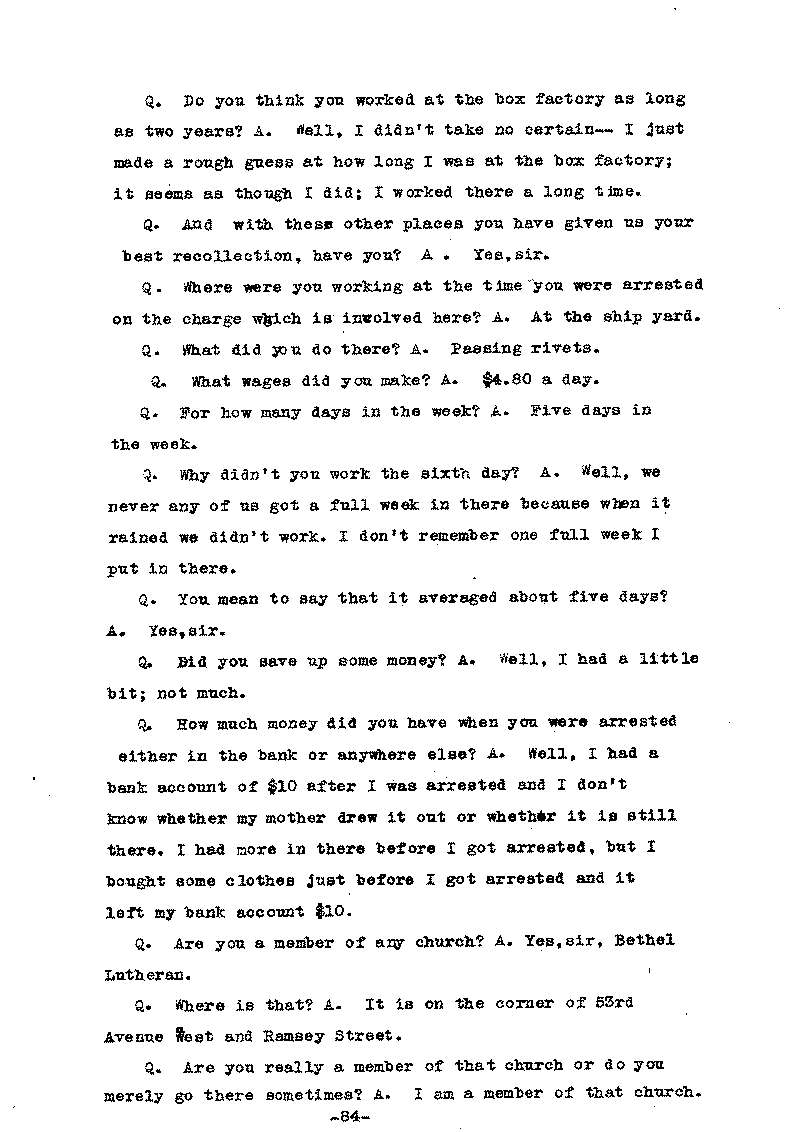
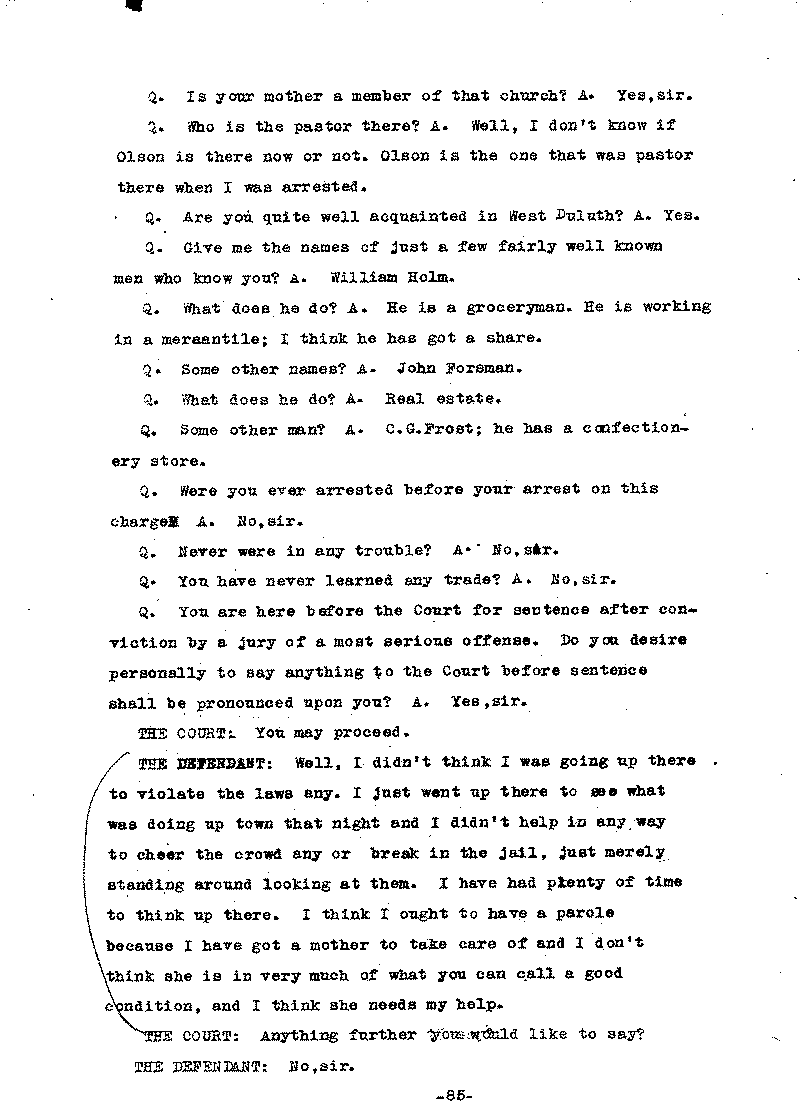
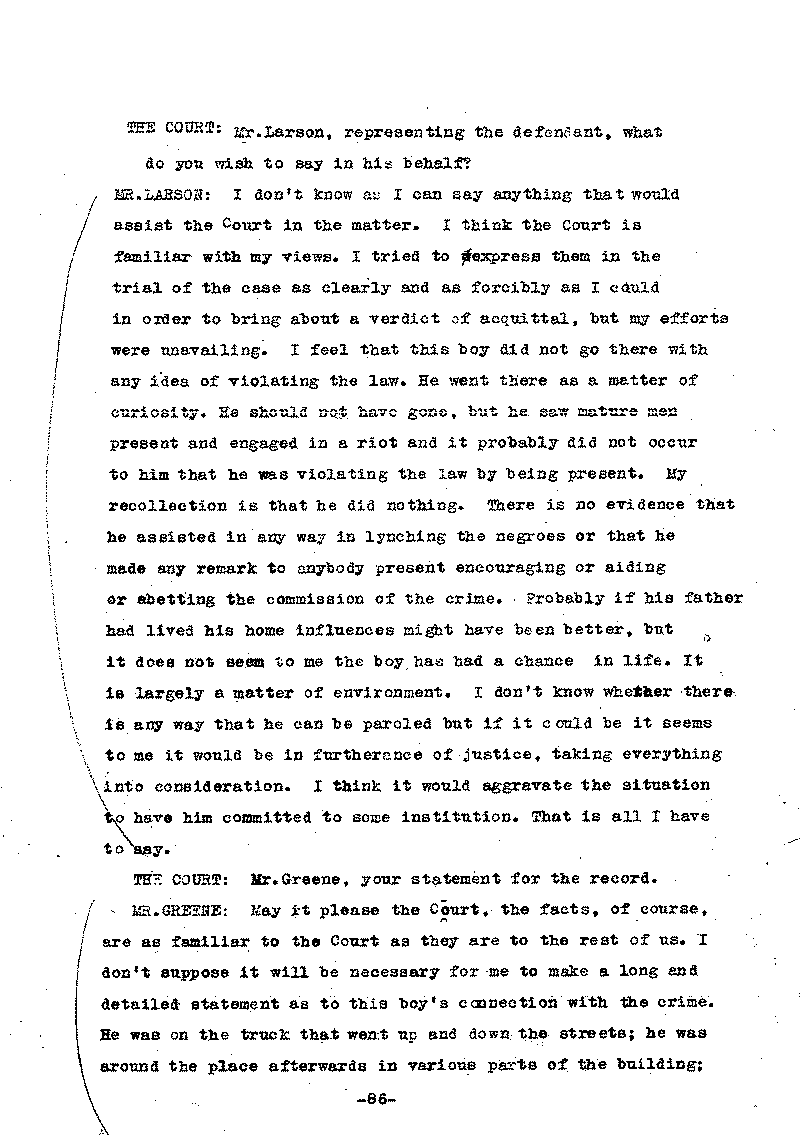
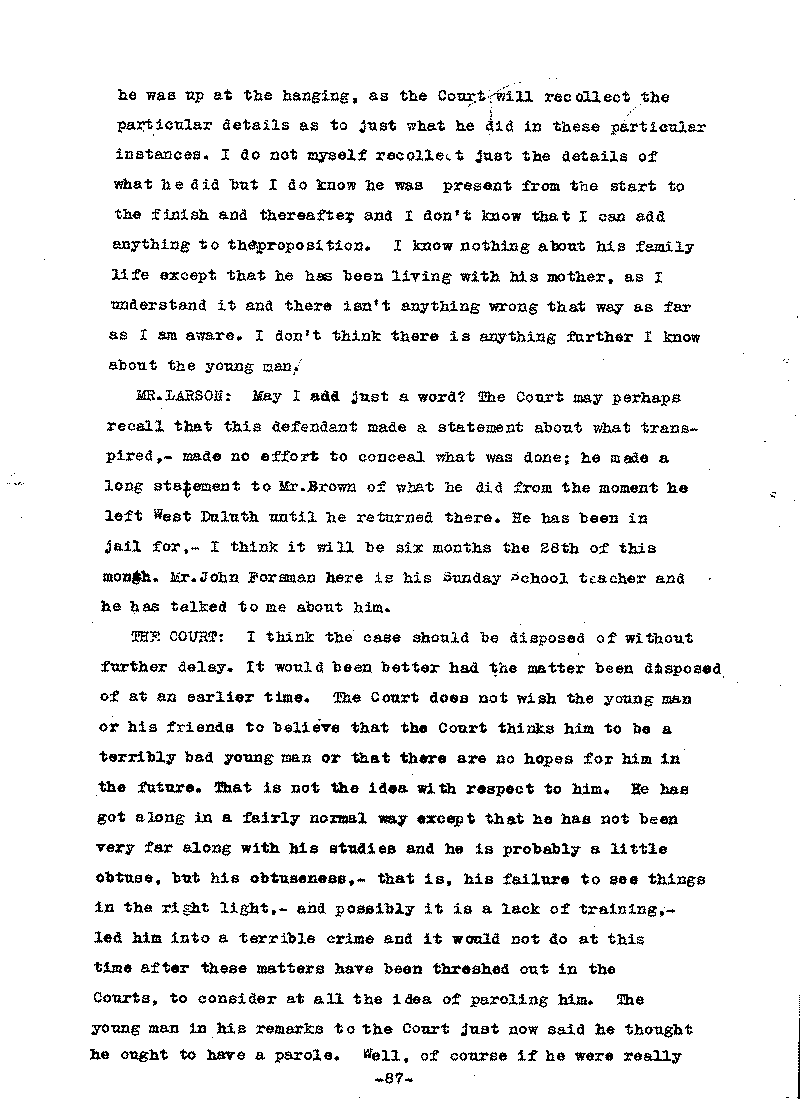
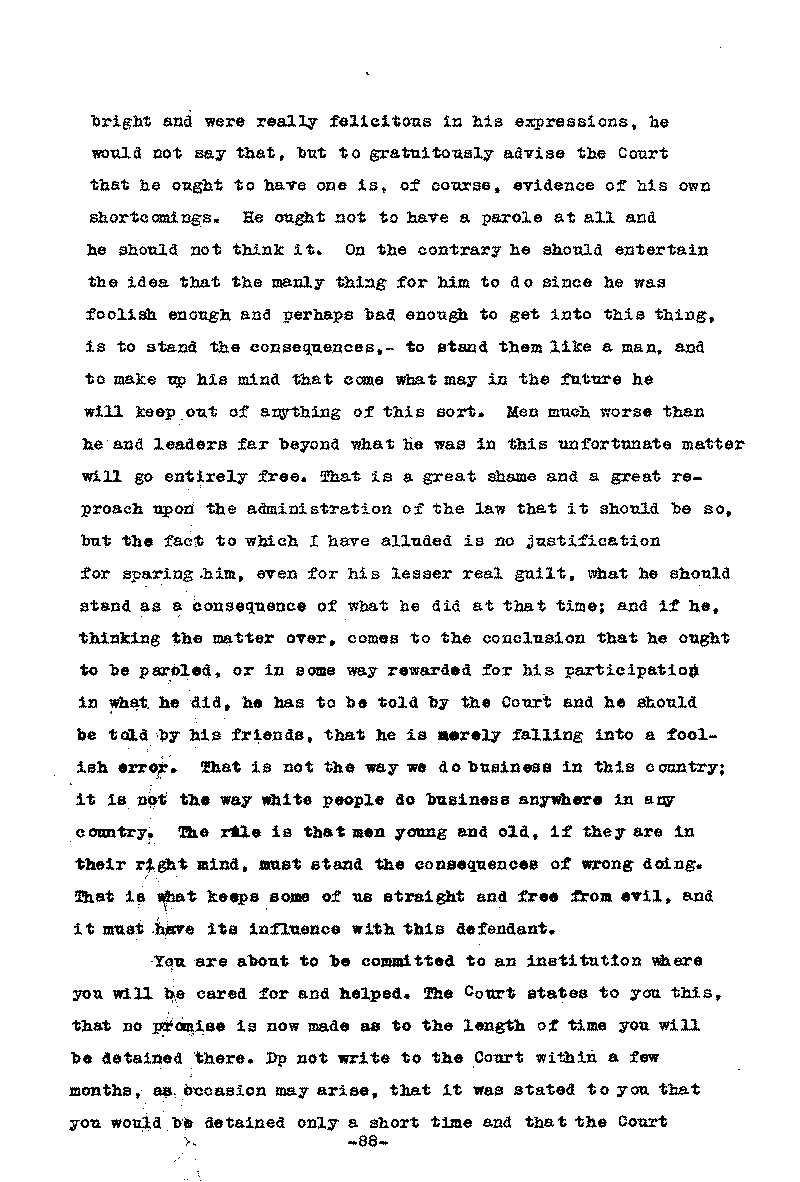
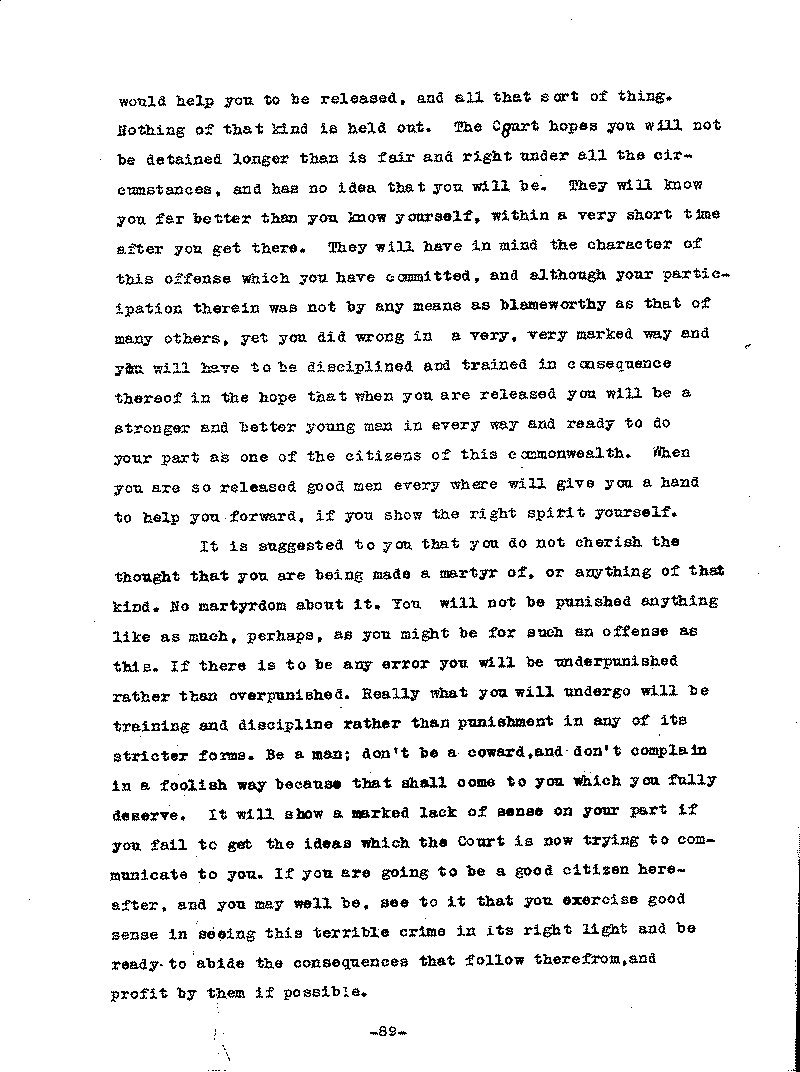

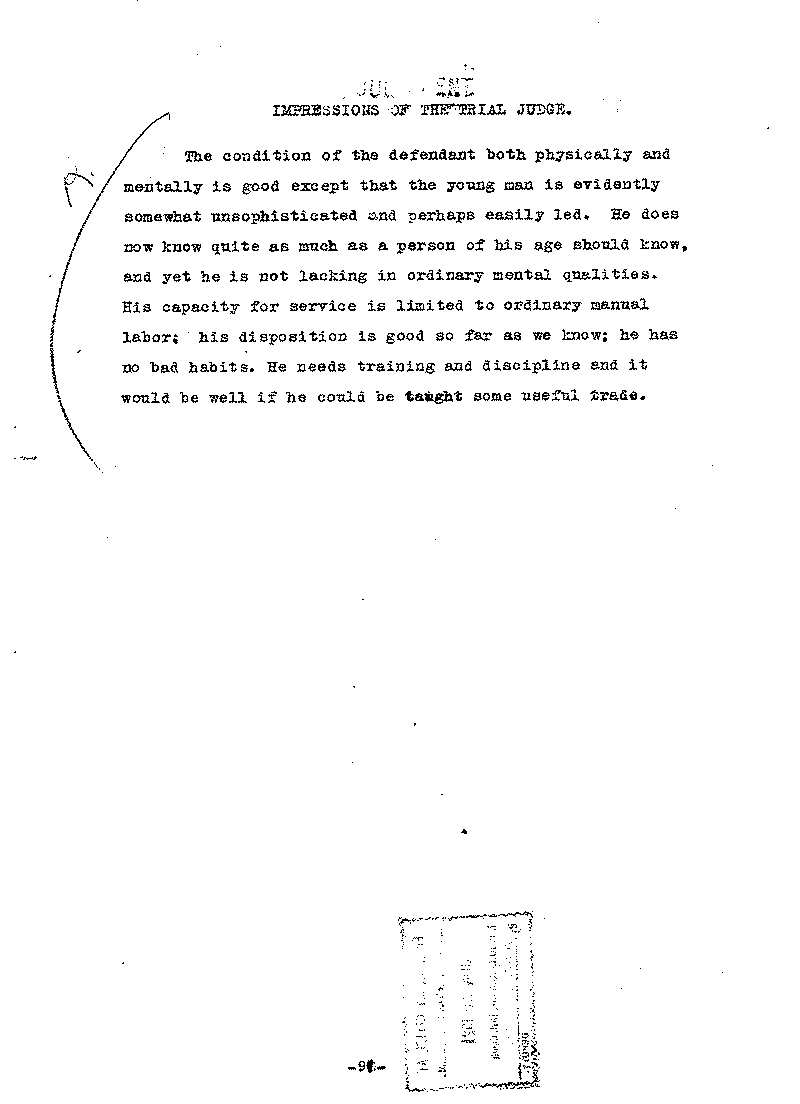
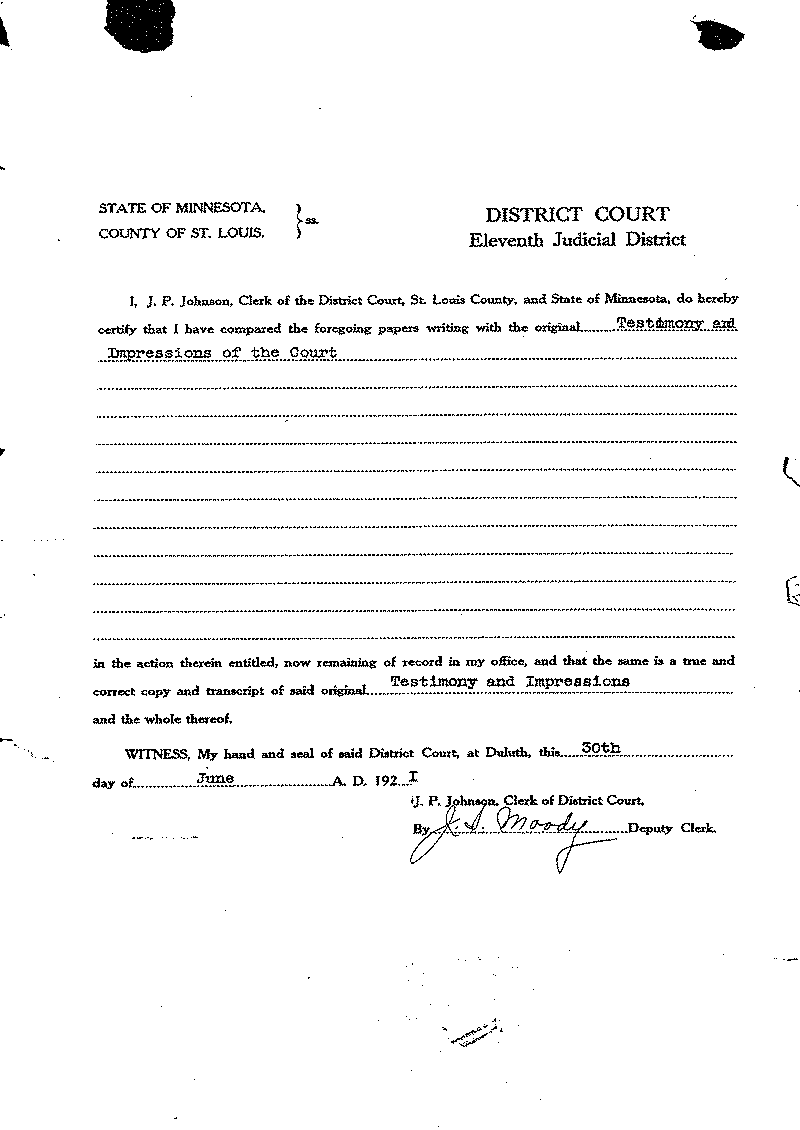
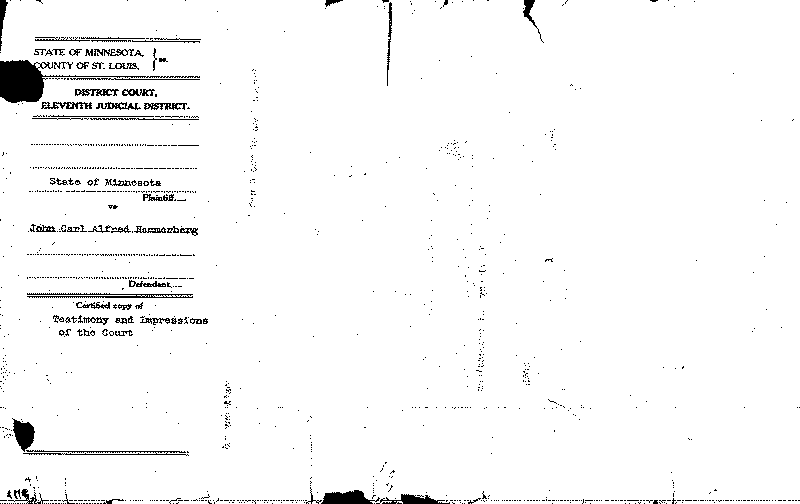
Image text
JUDGES JUDGES
HON. J. D. ENSIGN HON. H. A. DANCER
HON. W. A. CANT HON. BERT
FESLER
HON. MARTIN HUGHES HON. EDWARD
FREEMAN
COUNTY OF ST.
LOUIS
OFFICE OF
CLERK OF DISTRICT
COURT
Duluth, Minn., June 30th 1921
J. P. JOHNSON:
CLERK
Mr. C. W. Vasaly,
Superintendent,
State Reformatory,
St. Cloud, Minnesota.
Dear Sir:
I am
enclosing certified copy of the testimony and impressions of the
court in the case of State VS John Carl Alfred Hammerberg who was committed and delivered to you some time ago.
Yours truly,
J. P. JOHNSON, Clerk.
By I. S. Moody
Deputy
I n d e x :
Witness Direct Cross Redirect Recross
Barber, E. H. 18- - - - - - - - - -21
Brown, John C. 31- - - - - - - -
- -33- - - - - - - - - -38- - - - - - - - - -38
Carson, Austin J. 23- - - -
- - - - - -27
Davis, Fred F. 1
Forsman, Jonh A. 44- - - - - - - - -
-44
Hammerberg, Carl 46- - - - - - - - - -51
Harris, Edward 45- - - - -
- - - - -45
Holm, William 43- - - - - - - - - -43
McHugh, Francis 39- -
- - - - - - - -42
O’Brien, Herbert J. 15- - - - - - - - -
-17
Olson, Oscar 4- - - - - - - - - -11- - - - - - - - - -14
State
Rests- - - - - - - - - - - - - 42
Defendant Rests- - - - - - - - -
-61
Charge- - - - - - - - - - - - - - - - -63
Examination- - - - - - - - -
- - - - 81
Sentence- - - - - - - - - - - - - - - 90
Impressions- - - - - -
- - - - - - - 91
STATE OF MINNESOTA DISTRICT COURT
County of St. Louis.
Eleventh Judicial District.
______________________________
STATE OF MINNESOTA
vs. Crim. 5722.
John Carl Alfred Hammerberg,
indicted under the
name of
Carle Hammerberg, Defendant.
______________________________
This case came duly on before the Hon. William A. Cant and a jury on
Friday, September 10, 1920, at the Court House in the City of Duluth, in said
County and State, Mr. Warren E. Greene appearing in behalf of the State, and
Messrs O. J. Larson and George B. Sjoselius appearing on behalf of the
defendant; the jury having been duly impaneled, Mr. Greene opens the case to the
jury on behalf of the State, and the following proceedings were taken:
FRED
F. DAVIS, sworn as a witness in behalf of the State, testifying as follow, in
answer to questions:
ON DIRECT EXAMINATION:
My name is Fred. F. Davis. I live in Duluth. I
am not now connected with thepolice department but I was on the 15th
of June last as special policeman, for about 30 days. At seven o’clock
in the evening of that day, June 15th, or at 7:30 rather, I was at
Fifth Avenue west. I had been at West Duluth earlier. There was a truck on
Superior street that attracted my attention somewhere in the neighborhood of
7:30 I should judge, when I was at Fifth Avenue west. I had not seen the truck
before that time. It was proceeding east. I was standing at Fifth Avenue west
when this truck came along going east; there was someboys riding on the truck
at that time and hollering. After the truck had passed I walked
down to Lake Avenue and the truck then came back west. There was, I should judge, six or eight boys riding on the truck hollering, “Come on down to the police station to the neck tie party.” I first heard them holler that when they passed me at Fifth Avenue. They were doing quite a lot of hollering but I don’t remember anything else they said than that. They were riding on this truck and hollering to the people on the street, I should judge, to them along the street. I heard them holler this remark several times; they were hollering quite loud. They were doing the same when I saw them the second time at Lake Avenue going west as the first time at Fifth Avenue west going east. They had a rope attached to the hind end of the truck when they came back the second time, going west, when I saw them at Lake Avenue. I went up to the police station. I did not see the truck afterwards. If I remember right there were three men, young fellows, had hold of the rope at this time. When I got to the station there was a few people standing around the station; there was not a big crowd around there then. I was at Fifth Avenue about 10 or 15 minutes, probably: I only saw the truck there once; I believe that was the first trip when they came from West Duluth and at that time I judge there was six or eight fellows on the truck; I didn’t pay muck attention to how many was on there. I didn’t count them then; when I met them again at Lake Avenue I should judge there was about the same number on the truck and two or three behind, if I remember right. When I got up to the police station I stood around outside there; there was only a few people there then but they kept on coming; I was down on Michigan Street for awhile. I was a plain clothes man. Nothing took place on Superior Street in front of the station before I went down on Michigan Street; the crowd kept gathering; they kept coming right along. There was a lot of loud talk out in front. There was nothing in particular said, just loud hollering for people to come on up to the police station. Then there was a few boys went down behind there and I went down to see what was going to take place on
-2-
Michigan Street. They smashed in the back doors of the police station,
the garage doors. I should judge there were 25 or 30 people there at that time;
there may have been more. I was standing on the corner of 2nd Ave
and Michigan Street. I think there somewhere about 25 or 30 there then but it
kept growing larger right along. I couldn’t say how long it took them to
get in from the time they started exactly; I should think it was an hour’s
time. I was still there when the doors were finally broken in. Bricks was
throwed through the windows above the door and I believe a bolt or bar of iron
was used to smash in the door with. I did not see them crowd inside the garage
after they broke in the door. I did not stay there until that attack was
discontinued by the crowd. I was walking around, first one place and another
amongst the crowd. When the water fight took place I was on the Avenue next to
the Knudsen garage. There was an attack made by the use of hose. The police
had a stream of hose playing on the crowd there and the crowd was playing a
stream of hose into the police station. I couldn’t see exactly where the
crowd got its hose. It was straight across from in front of the station where
they were standing with the hose. I saw the hose when it was brought down by
the fire department. I believe one stream was connected on Michigan Street and
one on Superior Street, if I remember right, for the police. I can’t say
how the crowd got their hose. I think they grabbed it away from the police. I
don’t know exactly how they got it, but I saw streams being used by the
police and by the crowd. I think I was telephoning in Knudsen’s garage
at the time the crowd went into the station. I was not in the station till late
in the evening. I was down beyond the corner of Michigan Street on the Ave-
when the first Negro was brought out and I didn’t see him brought out.
After I got up on the Avenue they said they had hung one of the niggers ten:
somebody was saying it in the crowd. I did not see anything that took place in
the police station, and did not see any of the niggers. (NO CROSS
EXAMINATION)
-3-
OSCAR OLSON, sworn as a witness in behalf of the State, testifies as
follows, in answer to questions:
ON DIRECT EXAMINATION
By Mr. Greene:
THE WITNESS: My name is Oscar Olson, and I am a sergeant
of polic> On the 15th of last June I went on duty at four
o’clock in the afternoon and from that time on during the riot I was in
charge of the police station. At that time I had in custody six Negroes and
among them were Elmer Jackson, Isaac McGhie and Eli Clayton; five of them were
in the large jail in cells, on the Superior Street floor, and one was in the
boys’ department jail on the second floor. I recognize State’s
Exhibit A as a blueprint of the location of the police headquarters, and I
think it is a correct representation of the lay out there, including the police
headquarters, the shrine building and he electric light pole and the streets and
avenues as marked. State’s Exhibit B is a plan of police headquarters
interior, and the basement, and is a correct representation of it.
Exhibits
A and B are offered in evidence and received without objection.
THE COURT:
It may be noted that C, D and E are correct representations of the matters
delineated thereon.
THE WITNESS continuing: The front entrance to the jail,
the main hall and the men’s jail are correctly represented on the plats.
The entrance from the main hall into the men’s jail is at the point marked
“jail door.” The cells I referred to in the men’s sjail are
these marked here “lock broken”. The door between the main hall and
the cells room was a sheet iron door, solid; you could not see through it, and
inside this solid door was an iron barred door.
THE COURT: All witnesses in
the case, either for the State of for the defendant will leave the room and
remain outside until they are called.
-4-
O. Olson
THE WITNESS continuing: The stairs form the main floor to the garage are
here, marked “down” on Exhibit C, and the stairs from the main floor
to the second floor are here marked “up”. On Exhibit D. which is a
plan of the second floor, the place indicated here as the boys’ jail is
correct; here is the door as marked “door’. The door marked A on
the plan is the door leading to the hallway that takes you to the waiting room
of the ladies’ jail and also to the boys’ department; in going up to
the jail on the second floor you enter into a sort of a balcony ; then you go
through the door that brings you into a small hall way, the door marked A.
When you go into that hallway at your left hand is a door marked B leading into
what is known as the waiting room. From that waiting room, to go into the
women’s jail you go through a sheet iron door inside of which is a barred
iron door, at the place marked “C” on the map. From this hallway,
you go through this door marked “door” to get into the boys
department. On the right of the hallway is a door leading into what is known as
the store room; at the time of the riot there were two or three lockers in there
and nothing else to my knowledge; the lockers took up more than half of one side
of the room next to the boys’ jail, a trifle better than half towards the
west wall and extending out about close to two feet. There was nothing on the
other side of the room to my knowledge. There was a peep hole in the wall
between the store room and the boys’ jail, near the west wall of the store
room, at the place marked peep hole on the plan. It was a funnel shaped affair.
The peep hole is shown on State’s Exhibit I, down at the bottom. This is
the peep hole that was in the wall of the store room and the wider part is on
the inside of the boys’ jail. The picture, Exhibit I is taken from the
wall of
the boys” jail. The hole in the wall shown in the picture was
not there before the riot but was here after the riot; that was the place where
the funnel was set in the wall, which was of tile, Exhibit I is a correct
representation of how the place looked the morning after
-5-
O. Olson
Direct
the riot.
State’s Exhibit I offered in evidence.
Received
without objection.
THE WITNESS continuing: Those are cells in the boys jail,
shown in Exhibit D. The door marked “A” was a sheet iron door; there
was no barred door inside it: the doors marked “doors”, the outside
is sheet iron and the inside is an iron barred door. The one marked
“B” is a frame door and the door between the hall and the store room
is also a frame door. The single Negro that I have referred to as being on the
second floor was in the boys’ jail here, but I don’t know which
cell. There were no Negroes in the women’s jail. The doors down in the
garage opening on Michigan Street were large solid wood core doors; in one of
the large doors is a small door used in going in and out, but the main doors are
big swing doors like in a barn of garage.
Recess is here taken until two
o’clock.
Two o’clock; hearing resumed:
THE WITNESS
Continuing: As I stated before, I was on duty from four o’clock on the
day of the riot, and I was in the station when the truck went by; as near as I
can remember that was 7:30 or shortly after. I see it going west on Superior
Street. I did not hear what the people on it were hollering, but I did hear a
noise from it, a number of voices; they were shouting and hollering; I
couldn’t distinguish what they were saying. I had 11 policemen at the
station at that time. I stationed six of them at the front entrance and five of
them to the rear entrance in the garage on Michigan Street. When the truck went
by there was an unusual number of people out in front, and the crowd kept
increasing. It was shortly after the truck went by that I made the disposition
of the policemen that I mentioned, and when I did so there was quite a number of
people out in front, more than there had been when the truck went by and when I
put the policemen out there I could
-6-
O. Olson
Direct
hear a number of voices shouting and hollering. I could hear different
remarks, such as, ‘Bring them out here” and “Let us get
them” and “Let us go” and the likes of that. They attempted
to get in the front way and they later went around to Michigan Street entrance
abd started to throw stones, brick and other things, breaking down the large
doors and breaking windows. The building was damaged considerable by brick and
stones and water. The cars were also damaged some, the windshield being broken
on one and the
top broken on one of the; I don’t know which one, but
they weren’t badly wrecked but they were damaged as I stated. The garage
doors were broken; quite a bit of damage done to the doors. The mob on Michigan
Street were throwing stones and bricks and other things and got into the garage
and attempted to come up a small stairway when the hose was turned on them and
they were kept from coming up the stairs. We got the hose from the city fire
department and it was attached to a hydrant on Second Avenue East and Superior
Street on the lower corner but I don’t know whether it was the east or
west corner; it led into the front entrance of the station and brought to the
stairway leading down to the garage, to the basement and we were using water on
the mob and fought them off from there with the water and later they went
around to Superior Street and broke; they broke windows and broke down the door
and don considerable damage to the building inside by brick coming in. The
attack on Michigan Street was before the water fight on Superior Street, but
before the water fight they used sticks and stones and bricks in front of the
building; they broke all the large windows in police headquarters and one or two
of the smaller windows up above these large windows. When the attack started
on the front of the building I brought the hose to the front and turned it on
the mob. Shortly after that they got some water; they had a hose of their oven
that was taken away from the fire department.
-7-
O. Olson
Direct
They had the nozzle on the opposite side of the street some distance;
they were quite near Second Avenue East at the start and they wowed closer
towards the station. Myself and one or two other policemen heal our hose out in
front of the station and we was to the edge of the sidewalk and keeping the mob
back sometime, and the crowd plying their water onto us again, with stones and
bricks and other things that could be thrown and we were finally backed up into
a corner and it was there I was left alone with the hose and finally I had no
more water. At that time I was right in the front door. The water failed because
the hose was cut. Before that I had stationed the policemen that I could find
and instructed them to guard the hose so that it wouldn't be cut by the mob;
they were stationed along the hose as it came from the hydrant to the front
door. I was backed-up to the front door when the water quit on me, but the crowd
still had water. After I had no more water I staid for a short time with an arm
up in the air thinking the mob would understand that I had something to say but
I was forced away from there and I ran into the basement, to the garage. I went
down in the basement for help. The water that came from the hose of the mob, and
the stones and bricks forced me away from the outside door and I went down
stairs for a fear minutes and then came up and then the mob was right close to
the door and I again attempted to get outside and finally the mob came into the
hallway of the station, with a rush, in the front door of the station. At that
time there was a lot of brick on the floor and the paper was loosened in places
on the walls and hanging down, and the station had been damaged bar water and
there was maybe four or five inches of water on the floor; the pictures were
knocked off the walls and scattered about the rooms. When the crowd came in they
ran to the stairway leading up to the different floors; some of the mob stopped
at the large jail door and some of them stopped at the jail doors up stairs.
-8-
O. Olson
Direct
They came in and went up stairs, and the hall down stairs vies packed
with men, and about that time there was some speech making there. I could hear
pounding on the doors; I think it began about five minutes after -the crowd
first started in there, and I think it began up stairs if I remember correctly,
and it kept up until about midnight. I think the crowd came into the hall around
between 10 and 10:30 and when they took the first negro out, as near as I can
judge, it was after 11, and close on to half past, I should think, and I should
think it was close to 12 when they toot the last two. From the sound of the
pounding, I should say the mob was pounding on the iron doors; as a result of
what was done by the mob, one door on the second floor was torn from its hinges,
the iron door leading into the hall way that takes you to the boys' jail and the
waiting room of the ladies’ jail. That is the door marked "A" on State's
Exhibit D. Of the two doors leading from the hallway into the boys' jail, the
outside one was kind of sunk but I don't remember if it was torn off. It was
opened. The inside door was not damaged. There was no entrance from the hall
into the boys' jail through those two doors marked on the plat; at the doors
marked "C,” the outside iron door was broker off the hinges and the inside
barred door was broken, the lock was broken so they gained entrance. The door
marked "B" the top was broken off completely, and the door marked "D" was also
broken. There was a hole made in the wall leading from the store room into the
bays' jail, the hole shown in the photograph, Exhibit I. There was no damage
done inside of the cell room. The cell rooms have doors on them with looks; the
doors can be opened without breaking the locks by using the lever; if you lift
up on the lever the door opens; when you close the door the lever hooks over the
locks and they can be opened from the outside by lifting up the lever.
-9-
O. Olson
Direct
Down stairs the outside iron door leading from the main hall into the
men's jail was broken from its hinges and the barred door was damaged some; the
locks were broken off, and they gained admission into the jail that way. In the
men's jail down stairs the locks ware broken off or knocked off the door. That
was necessary to gain admission to the cells, if they were locked with a key;
they couldn't be opened otherwise without knocking them off. I don't know
whether they were locked with a key that night or not; anyway the locks were
broken from the doors The stairways were crowded, and while they were battering
down, these doors some of the crowd were hollering and jumping around. They ware
using a large timber, part of a railroad rail and crow bars, sledge hammers and
several other instruments to batter down the doors. As near as I can tell they
were at work breaking in the doors from sometime around 10 or 10:30 up to half
past 11 when the first negro went out, roughly speaking. I was not looking at a
time piece; they took the first negro from the large jail down stairs, I think,
but I didn't see where he came from. I could hear the mob hollering, "They have
got the first one." At that time I was in the secretary's room; after they got
outside of the station I see the crowd moving east; they were hollering and
pushing and walking and running up Second Avenue; they were just turning the
corner when I see the whole mob going in that direction; it was sometime around
35 or 40 minutes afterwards before they got the other two. I didn't see that. I
think I was in the secretary's room. I didn't know until after they were taken
out that they were gone. I could hear the mob or some of the men about the
building saying that "they have got them" or things of that sort. I didn't see
where they took them. I didn't go up to see any of the hanging. The Chief came
there about a quarter of 12, as near as I remember; he was there before the last
two were taken out.
-10-
0. Olson
0N CROSS EXAMINATION, by Mr. Larson:
At 4:20 on that day I learned
that there was likely to be some trouble at the police station, after I arrived
there. I got in the station about 3:35 and I went on duty about seven minutes of
four. I didn't learn the names of the negroes until after they were hanged; I
first learned the names when I see the names in the News Tribune in the morning.
Isaac McGhie was hanged first; I heard it talked of after the lynching, just
general talk. I have no way of finding out positively that he was the first
negro. I thought he was taken from the large jail down stairs. I don't know why
I thought so. I didn't know who they were down stairs; I knew one of then was up
in the boys' jail, and which one of the six I didn't know. There were six
negroes in jail at that time; those six that were there in the evening were
placed in there between 7:30 and 8 o'clock the morning of the 15th, with six or
seven others, but they ware not all there at the time the crowd came; they had
been released but I don't know when. I took part in the arrest; it was between
four o'clock and 7:30 in the morning. They were arrested in the yards of the
Canadian Northern down at West Duluth, I left the negroes in the jailer's room.
I assisted in taking them from the railroad yards to the police station. I left
them in the jailer's room, and it was his duty to put them in cells. Jailer
Harling was there that night. 'When I heard there was likely to be trouble that
night, the first steps I took I called in a motor cycle policeman and a
detective and instructed the motor cycle officer to run about the different
streets to see whether he could see a group of people or a number of people any
place, and to run out in the west end and West Duluth and see what he could see
there and come back and report to me What he had learned, and I instructed the
detective to go down street and drop into different places where he thought
there might be a bunch of
-11-
O. Olson
Cross
youngsters talking, such as in places like pool halls and they come back
and reported that it was no more than what had been going on all afternoon. They
didn't see any unusual number of people any place or any bunches of people of
they didn't hear any other talk than what they had heard during the day, which
was a remark such as some talk about lynching the niggers. Their report to me
was that they didn't learn any more than what they had heard or seen during the
day. I sent Motor-cycle Bailey and Detective McKenna. When I got the report I
instructed the operator to notify all men off duty to report at Headquarters at
once and I also notified the Sheriff and Commissioner of Public Safety and the
Chief of the fire department. I notified the Commissioner of Public Safety by
telephone at his residence around seven o'clock or shortly after, and I notified
the Sheriff about the same time. By that time three or four of the officers had
reported to the station, and Mr. Murnian came down; he came after 7:30; I did
not see him after the crowd got into the police station; I see him at different
times before the crowd came in, about the building, in the hall way and the
office. I had some talk with him about what was the proper thing to do under the
circumstances. There was something said about using fire arms. I outlined my
plans and instructions to the men to Murnian, the Commissioner, and he thought
they were all right. I instructed the men to attend s strictly to business and
not to talk to anybody and to keep the crowd from coming into the station and
not to shoot until you have to; be careful and do not get into trouble, and
those lines. There was nothing said about making any arrests that I remember. As
I said, I assigned six officers in front of the station and five in the rear.
Three of the officers in front were Isaacson and Lading and Nystrom; I don't
remember the names of the other three. Officers Sorenson, Mahlon
-12-
O. Olson
Cross
and Shannon were assigned to the basement; that is all I remember. I
didn't see the crowd on Michigan Street that made the attack on the garage; in
front, they were standing all over the street and sidewalks and on Second Avenue
East, but I don't think it extended to First Avenue; both sidewalks were full
and a considerable number of people on the street proper between the sidewalks;
probably between four and five thousand people. I don't know if the remarks
mentioned carne from that crowd but it came in the direction where the crowd
was. The remarks were, "Let us have them" and "Let us go, and things of that
sort, "What if it were your sister." There were a great many people, young and
old, laboring men and businessmen, and women, and they seemed to be considerably
excited; there was loud talking and hollering, moving back and forward in all
directions. When we put the hose on them, it had some effect and they started
back for a time until the water was gone. With me at the hose was officer
Sorenson and a special policeman by the name of Webster and I also called a
fireman over to my help, by the name of Dunn. I don't know what became of them
when I went into the police station; they disappeared; then I went down stairs;
when I left no one was guarding the front entrance of the police station. When I
got down stairs I saw some policemen down there and tried to get them to come up
and assist me, with no success, and then I came back up stairs. The hallway was
packed and there were people in the general office and the jailer's room, but
the room between the jailer's room and the jail proper was not packed, but there
was a number of people there; the stairway was packed. I recognized different
people in the crowd. One was Leonard Hedman and Dondino, and I saw Attorney
McClearn and some newspaper men, one by the name of Carson and another by the
name of Gallup. There were several faces I know but I don't know their names. I
saw police-
-13-
O. Olson
Cross
man Harry Sorenson in the hallway, on in the entrance to the jailer's
room from the hallway, at the place marked H on State's Exhibit C. I don't know
whether there was any effort on the part of any policeman to prevent the first
negro from being taken out of the building, I did not see any. There was an
effort made to prevent the second and third men from being taken out of the
building; this was done by Officer Nesgoda and Sandberg and Walker and
Lieutenant Barber. I don’t know what they did. I didn't t see them do any
thing. There were no arrests made that night concerning the lynching; no one in
the crowd either out doors or in the building gas arrested.
ON REDIRECT EXAMINATION by Mr. Greene:
I don't know why no arrests was made; there was other things to attend to
besides arresting them; I thought that would be taken care of later; that was my
opinion of the affair. After the crowd got packed in there it wasn't possible to
make any arrests with the number of officers we had there; there was a crowd
there of four or five thousand people on Superior street beside the people on
Michigan Street, and it increased during the evening and from what I could see
during the time I was out in the water fight there was people as far as I could
see east and west, blockading all traffic. I did not go up to the pole when the
negroes were taken down. I was not In that bunch.
-------oOo------------
-14-
HERBERT J. O'BRIEN, sworn as a witness on behalf of the State, testifies as follows in
answer to questions:
DIRECT EXAMINATION, by Mr. Greene:
THE WITNESS: My name is Herbert J. O'Brien; I live at Nopeming
Sanitarium; my family live In West Duluth; I was living there on the 15th of
June last, at the Cody Hotel. I came down town on Dondino’s truck that
evening; I got on the truck at Bristol Street and Central Avenue out in West
Duluth; at that time there wasn't anybody else in the track, but we picked up
same boys as we came in; there was four or five jumped on as we were pulling
out; the driver was on the truck when I got on and then others got on. It was
just a common dray truck, just a common truck behind. The driver sat in the
front seat, and back of him was an open truck. We drove straight down Central
Avenue; I think we struck Grand Avenue and then we come down Grand Avenue until
we got to the ore docks and then we turned down to Superior Street until it was
30th Avenue end we drove up Superior Street I think it was to 3rd Avenue East,
up through the central part of the city. The fellows on the truck were hollering
around the west end; they were just hollering they were going to have a neck tie
party. Then they drove to 3rd Avenue East and then turned around and went back
west on Superior Street to 7th Avenue West and then turned around again and went
east to Lake Avenue and then turned around and went west to 2nd Avenue West and
then they turned around and went right up to police headquarters, in front of
the police station and got out. When they were driving up and down Superior
Street there was a lot of talk, this and that, among the bunch on the truck;
they weren’t hollering at the people very much the first round, not until
the crowd all got on the truck; all that could possibly get on got on the truck.
I didn't see the rope at all; you couldn't flee back at all
-15-
O’Brien
Direct
there were so many on the truck so I didn't see to rope; there was
probably 16 or 20 on the truck when we were going up and down the street, and
than we went down in front of the police station; then we went easy the first
time to 3rd Avenue East there was quite a bunch on the upper side; I judge there
would be probably five or six fellows inside looking outside of the police
station but there was nobody outside at all. When we got back finally and got
off the truck there was quite a crowd at the police station then; it had grown
from the first time till we finally got off. When I got off I came right down in
front of the police station and there was six policemen standing in front of the
door but I didn't know none of them only Isaacson; then I crossed across the
street to the cigar store, and I didn't see anyone around there that I knew of
the bunch and I bummed around there awhile and then I went across the street
again. The crowd was hollering once in awhile, "Hand out the niggers" and one
thing and another like that, that that was what brought them there. I was not
down on Michigan Street at the time of the attack; I was down as far as the
corner but I couldn't get no further; that was just before they started the
water hose on Superior Street. I couldn't see what they were doing on Michigan
Street. I saw the water fight on Superior Street. I was in the station during
the evening; I got in a couple of feet past that big safe that is in there;
there was such a crowd that you couldn't get no more in. All those that was down
in the hall ways down stairs they was all right; they wasn't moving at all
because they couldn't move very much either way. They were very quiet, some of
them, but there was lots of noise. The stairways and gallery was full up stairs
and there was some fellow saying: "Just go easy; just keep quiet until we get
him. We have got the first door down and as soon as we get the other doors down
we will hand the
-16-
O’Brien
Direct
niggers down to you and then they all cheered and hollered and clapped. I
was right opposite the safe in the main hall when the first negro was brought
down, I can't say where he came from; I thought he came out of the first floor.
They passed right out just like a shot out of a gun and I was standing in that
hall way for about an hour and forty minutes or an hour and a half when I was
just caught right in the jam and I was swept right out with them. I saw the
lynching; one negro was hung at first it was about ten minutes later before the
other two were hung; the last two came together; they were hung on the pole at
2nd Avenue East and 1st street right by the Shrine Auditorium; I was about 25
feet or so away from the pole when the first negro was hung, out in the crowd; I
was 40 or 50 feet away when the second two were hung, up on 2nd Avenue.
ON
CROSS EXAMINATION, by Mr. Larson,
I had a good opportunity to see the crowd
on Superior Street in front of the police station before they went into the
station; I would think there was probably 10,000 people altogether; their were
men and women both; lots of women with babies in their arms, lots of baby
carriages; there were laboring men and business men and young boys, and young
and old, men and women, rich and poor, and working men and girls and lots of
excitement; lots of women hollering and clapping their hands and saying, "Good
for you, boys. You have got the backbone in you. Stick up for the women's
rights", and all of them was hollering that.
-------oOo---------
-17-
E. H. BARBER, sworn as a witness in behalf of the state, testifies as follows, in answer
to questions:
ON DIRECT EXAMINATION, By Mr. Greene:
THE WITNESS: My name is E. H. Barber; I am lieutenant in the police
department in this city. I was at the station the night of the 15th of June
last; I arrived there about ten minutes after nine and at that time there was a
great crowd of people in the street and several policemen in front of the
station and they had a line of hose running into the station from some hydrant
on the corner from the city hall there, and I went into the station and came out
and there was some more policemen over here trying to keep the crowd back; that
was after nine o'clock; the water fight started after I came, and I was in it;
it started possibly 15 or 20 minutes after I came. I was right in front of the
police station when it started; there was a fire wagon came down, an automobile,
and the crowd took the hose away from the firemen and connected it up; the fire
wagon was right in front of the police station when the crowd took the hose
away, just a little bit west of the entrance; about even if the fire rig was
headed east. They ran up 2nd Avenue with it towards 1st Street. I don't know
where they connected it, but up there someplace and they used it on the front of
the police station. I tried to take the hose away from the men that was using it
and they turned it on me and I got the worst of it. They had full pressure head
on it. They turned the water from the police station on the crowd out of the
police station door and it was vice versa, both was going, streams of water from
each. The water fight ended in victory for the invaders; they got the best of
it; the water from the police end of the hose gave out for some reason and when
they saw that they turned their hose right into the front hall way and then the
crowd went right in. I was at the corner of the city hall, right near the city
hall entrance, when they got in, and after that I went
-18-
Barber
Direct
back into the police station myself; I crowded my way in the front door
and then I seen Sergeant Olson at the desk and I asked him what we could do and
he said "Nothing" so I went around through the hall way to the back end of the
jail or the back end of the hall way by the jail and they were already at the
,jail doors then, down stairs and up stairs too, and I went up stairs to the
boys department and they were at the outer door then, and I talked to the crowd
there for awhile and while I was standing there somebody threw a chain around my
neck; I don't know who it was. I told the crowd not to do that when I talked to
them; I can not remember the exact words but as near as I can recollect I told
them the niggers was in that jail there and some of them were innocent and
this
fellow especially in this upper jail we wanted him because he was the
principal witness against the ones down stairs; and the crowd said, "We are
going to get the niggers; going to get them all" and they hooted and hollered
"Get them out of there", and I couldn't do nothing, I was alone, so I went down
stairs again and I talked to the men down stairs. ''When I was up there somebody
from behind threw a chain around my neck and pulled it up; I don't know who it
was. I got the chain off; it was a chain four or five feet long, part of an
automobile chain; it looked as if it might have been used on a truck; it was a
single chain. When I was talking to them all evening I told them to go home and
leave the niggers for a trial the way they should be, or words to that effect;
I spoke about the same up stairs as I did down below. They were pounding the
doors with bars, or sledge hammers and they also had a timber there, a small
round log that they were ramming the door with, the steel door after I talked to
them upstairs I went down stairs and talked to the men there at the big jail
door; they had a railroad iron probably about 8 or 10 or 12 feet long and they
also had a
-19-
Barber
Direct
piece of square timber about 8 by 8, and I talked to them there; they
were then at the big steel door and they wouldn't listen to me. Do you want me
to name the individuals I talked to? I did not recognize this defendant, but I
talked to some of them; I talked to everybody that was there that could hear me;
they stopped beating the door while I talked to them, then when they got tired
of listening to me they resumed and I left and when I came back again they had
the door down, that outside steel door on the main floor and they had the barred
door next to it busted too; they broke the lock off that and they were inside
the jail on the main floor. When I got down from the boys' department and talked
to those at the door there, I went into the jailer's room to get some help; I
couldn't do nothing else, and I got several policemen and I started with them
back to the jail and thought I could clean it out, and when I got into the big
jail there was a lot of people in there and some of them was taking care of the
grated door, so I went to the left
hand side as you go in, the east side, and
they were pounding on the locks of the cells at that time when I got in there
and the policeman that was in there with me and we staid there at that cell for
awhile, but they didn't like it and somebody in the crowd hollered, "Get them
out of here. Get them out of here", and they did put the other policeman out and
I stuck there and afterwards let in officer Walker and he come in with me, but
we couldn't get up to the cells, and we recognized several that was in there,
and they got the negroes out while I was in there; they got the negro out from
up stairs. I heard them taking him out. The first negro was taken out of the
boys' department through the little room right next to the boys" department that
opens off this hall way. I heard them taking out the one from upstairs before
they got the two from down stairs; there was three left and there was six
negroes, one
-20-
Barber
Direct
up stairs and five down. I saw the hanging. After they had taken these
other two negroes out I ran up there but I didn't get up as quick as I should
have. They had the last negro hung up then; he was hanging on the pole and from
where I was behind the crowd I saw the fellow on the pole and the negro was
being hauled up then and I saw the fellow roll the negro around the pole a
little and kick him in the face with the heel of his shoe. That was the last
negro up; I suppose that was one from the down stairs; there were three hung on
the pole, three that had been in the jail. I don’t know their names. One
of the names was McGhie and I don't know what the other names was. I think I
would recognize the names if I heard them. Elmer Jackson and Eli Clayton was two
of them and Isaac McGhie was the other. I think McGhie was the fellow that was
up stairs; he was the fellow that was supposed to be innocent anyway, the one
that was up stairs.
ONCROSS EXAM INATION, By Mr. Larson:
The fellow up stairs was the first one taken out. As I recollect and from
what I heard, but not from my personal knowledge, the first fellow was taken up
2nd Avenue East and the last two was taken down to 1st Avenue East and taken up
there the 1st Street and brought over there to 2nd Avenue East. I don't know
that from my own knowledge. Down in the main hall in the police station I
recognized Stevenson, the man who was tried in the other Court Room here; he was
helping to batter down the door on the first floor. I also recognized a man
named McElligott and a fellow named Rozen and a man named Davis; he is a
detective and special police, I believe he was at that time, and Mr. McDevitt,
the assistant County Attorney, and Mr. McClearn; I mean Mr Elmer McDevitt and
Mr. Hugh J. McClearn; I also recognized several policemen; I don't recall
any
others at present; there was quite a few people I saw there
-21-
Barber
Cross
that I knew; I suppose they are old residents. I remember now there was a
fellow by the name of Ellis I saw there and Natelson and Bergson and Carson and
Wilkie and maybe some more; I mean Frank Wilkie, connected with the wood yard,
and Nick Perry, and Mr. Murnian the Commissioner of Public Safety. Mr. Carson is
a newspaper reporter. It was after the men were taken out that I saw Mr.
Murnian; he came from up stairs when I saw him. I don't know where he had been
while the attack was going on. The boys department is a half story and then
there is the first and second floor beside; there is a third floor over the boys
department but there is not a third floor over the police department proper. The
assembly room would be the third floor over the boys’ department but it
would be the second floor in the front part over the police department. When I
was out in the water fight I saw some people I knew. I wouldn't say they were
all classes. I recognized Chief McKercher; he was standing in the entrance to
the City Hall, and this Frank Wilkie, I saw him out in front, but I don't know
just at the present time who else I saw outside of police headquarters. I
probably knew a whole lot of people that was there but I don't recall them. It
seemed to be everybody there in general like there is in a crowd of people that
was on the streets that evening. Certain ones of these I saw doing things and
certain others I didn't.
---------oOo-----------
-22-
AUSTIN J. CARSON, sworn as a witness in behalf of the State, testifies as follows, in
answer to questions:
ON DIRECT EXAMINATION, by Mr. Greene:
THE WITNESS: My name is Austin J. Carson I live in Duluth, have for about a year; I am a news reporter on the News Tribune and have been about a year. I was in the city can the 15th of June. The first I saw relative to the trouble was a truck going east on Superior Street between 7:20 and 7:30. I had been at the News Tribune and was going up street and saw the truck between 1st and 2nd Avenues West; it was going east then. I didn't see the truck until it was almost opposite me; we were going west and all I saw was a truck with the men on it and a rope dragging behind and several, men hanging to the rope and inviting the men on the sidewalk to come with them; they asked us if we had cold feet, and where our manhood was; that is all I remember. I didn't hear anything about joining the neck tie party. They said, "Come along; we are going to get the niggers.” I went on up to the Spalding to eat and didn't see the truck any more. After I got through dinner I went down to the police station directly. When I got there there was quite a crowd outside and several policemen were stationed in front of the main entrance to keep people from going in and there was a crowd circulating around. As I remember the street was pretty well filled in front of the police station and extended around down on 2nd Avenue East to Michigan Street. I don't know exactly how far west it extended from the police station, but east to 2nd Avenue East; west of the police station, was an automobile establishment and they were sort of circling around across the street there. I went in the police station first and talked with the officers a little and went outside and down around to the Michigan Street entrance. There was quite a mob down there and they were trying to get into the police station there. They probably had been
-23-
Carson
Direct
in once, I took it for granted, because the door was smashed down and the
glass transom over the door had been broken, but when I got there the policemen
were lined up pretty close to the doors and there was no one inside. They began
using stones and bricks and anything they could throw, I guess, and they got in.
I went around to the front of the station later on, a few minutes afterwards; I
just circulated around through the mob there, and I was over in front of the
station when the police department came down with two hose reels and they were
taken off the reels and disappeared on the avenue, and the mob was so thick at
that time all the way up to the avenue that all you could see was the hose
disappearing; you couldn't see who had hold of it or where it was going except
it was going up the avenue. Sometime later there was two streams of water turned
on in those hose; the police were using one stream in front of the station and
they had a sort of water fight; part of the time that was going on I was in
front of or right beside the station door and part of the time on the other side
of the street and part of the time over in front of the City Hall and I also
made one trip up into the City Hall. I was circulating all around there. I just
went down to see what the excitement was but after I got there one of our men
was there and he said I was to report to him and left; he didn't issue any
orders, and I just staid there and picked up what I could for a story, and I
moved around among the crowd a good deal. In describing the actions of the crowd
I would say in a more or less jovial way they seemed to sympathize with the men
who wanted to get into the station; that is, the people who were not taking any
active part, who were scattered on the other side of the street without the
circle of the police department seemed to be trying to keep clear; they seemed
to be in sympathy with the men who were trying to get into the station.
-24-
Carson
Direct
The great mass of the people were merely spectators and stood their
ground pretty well. It would be hard for me to say what proportion of the crowd
was active. The only way I would have of judging would be by the number of
people probably who followed into the police station and who were inside of the
police station and inside of the cell room later on. There were several hundred.
That is as near as I can get it, I suppose. Over a hundred anyway. When the
water fight was over the crowd went into the main hall of the police station. It
was pretty well jammed in there so I went in through a window in the front
office and was around the front office and to the rear office where they took
the prisoners, what they call the cell room. I was around there during the
speeches of two or three men who apparently tried to dissuade the mob from their
purpose. They were Mr. McDevitt and Mr. McClearn, I believe. I don't remember
Oscar Olson making any particular speech but there is no question about him
several times speaking to the men. I don't know as he made any speech but
throughout the evening he made efforts to try to stop it. Before these speeches
I heard were finished they began to pound on the doors, of the cell room and
when I decided they were in earnest about trying to get into that cell room on
the first floor I went over there and staid there until they got in. They were
using a piece of steel railroad iron for a battering ram and I was between the
ram and the wall. (Indicates point marked A1 with a circle around it on first
floor plan of jail.)
The end of the rail almost touched me each time it came
back. The door was warped in so that on the side where the lock was it bent out
so they could get a piece of 2 by 4 and pieces of pipe and things like that in
between the edges of the door and the jamb, but they couldn't spring it out that
way so they got sledge hammers and broke the hinges and got the door off.
-25-
Carson
Direct
As I remember they jammed in the barred door on the inside; I think they
broke the hinges off it and they went through it too, and I went through with
them and I went around to the cells to get the names of the negroes who were in
the cells. I went clear around and saw the negroes. They were under their
bunks when I first went around there; that is, they were out of sight, and I
heard the crowd shouting around that the police had fooled them, that the
niggers weren't there, and finally they found one under a bunk and different
ones would shout, "Here is another one "as they crawled out. As I remember
they started breaking in the first cell on that east side, the one farther north
first, but I continued around and stopped at the second cell at that side; there
was a white man in there and I talked to him for awhile, asked him how he felt
and got his name and so forth and I continued on around the cells to the other
side and asked each of the negroes in turn what their names were and they gave
me what they said were their names, and Isaac McGhie was among them. I didn't do
anything in particular except roam around there until some minutes later I went
to the second cell; I think it was the second cell from the rear on the west
side and they had two or three of the negroes in there that they had taken from
the other cells and I went in there and they were questioning them and while I
was there they brought in two more and after they brought in those last two I
went out and I just was out a few minutes when they brought two of the negroes
out to hang them but I didn't see them; after I got out of the cell room I
didn't see them. I went across the street and when I came back there again
afterwards to telephone to the office for instructions I then went back to the
cell room again and they had left three men in that cell where they had been
examining them, and I asked them their names to try to check up and every time I
asked them I got
-26-
Carson
Direct
different names. I was trying to check up what their actual names were,
and the police came in about that time; I think there was a policeman stationed
in the corridor of the cell room when I got in there, and he told me to get away
from that door and a minute or so later Captain Fiskett came in and ordered all
the policemen over to the City Hall. When I saw them this Isaac McGhie a was
crying and trying to pray and wringing his hands and hanging on to the bars and
he was trying to make the mob believe that he was innocent; he was protesting
his innocence. As near as I could check up afterwards he was one of those taken
out and hung. When the first one was taken out from up stairs I was in the cell
room below and someone hollered that they got the first one, and it was a very
short time after that that I got out.
0N CROSS EXAMINATION, by Mr. Larson:
I did not see any of the negroes hanged. I don't know which was the first one taken out except from what I just said I heard some one in the mob down stairs holler that they had got the first one. I know he wasn't taken from the floor I was on, the first floor, so he must have been taken from the second floor. The man who gave his name to me as Isaac McGhie was on the first floor. I wasn't up on the second floor at all. I would just have to guess roughly how many men were in the jail during the time I was there. Both sides of the cell room outside of the cells was packed, (illustrating by plat) to the rear, at the south side of the cells there was only an occasional one, but on the east and especially on this north side it was pretty well filled. I was there when they held the so-called mob court. I am not positive in any mind whether it was held in the
-27-
Carson
Cross
last cell on the west side or the next to the last but I think it was the
next to the last cell. I don't know who was holding it. I asked the negroes in
there their names. The first time when we first got into the jail room and I
asked them their names, they gave me one list of names and the next time they
gave me-- Well, it corresponded to a certain extent but it didn't-- The first
time I think I got two by the name of Green and the next time two by the name of
McGhie and I came back later on and tried to check them up and I couldn't, that
is I couldn't definitely. There were probably three or four white men engaged in
that kangaroo court proceeding, but I didn't know any of them. I don't know how
long the proceedings lasted. When I came there they had three men already in
there and I don't know how long they had been there; I don't think it lasted
more than 15 minutes after I came. I took no part only to ask their names. I
don't know if there were any policemen there when they were holding this
kangaroo court. There had been some while they were breaking open the first
cell, some of the officers tried to grab this sledge hammer, and some one
gelled, "Get them out of here. Rush them", and they seemed to crowd around the
officers and crowded them to the door. I think Lieutenant Barber staid there but
I am not positive. The others went out. After I got through asking the names of
the negroes I staid there until the mob began to get pretty thick, that is
insistent, and the cell door which was closed when I went in, closed after me,
was opened and then they brought two more negroes in while I was there and the
mob began to jam into that cell and it got pretty tight and pretty hot and I had
an overcoat on, a ad I thought I had better get out of there, and I did get out.
I don't know that the crowd got larger but they began to pack pretty well
around
-28-
Carson
Cross
that door and became more insistent as time went on; they wanted to get
into the cell and were wanting to get the negroes out. I think it was five or
ten minutes after the mob got into the police station that they began pounding
on the doors. I made no note of the time but I think it was while McClearn and
McDevitt were talking that they began pounding, before they finished speaking.
When I got over there they were using a railroad tie. I had been in the jailer's
office before the pounding began and then I went to where they were pounding and
I got pretty close to them; they were working right in front of me. There was
probably four or five men on each side of this railroad steel rail when they got
to that and they would swing it probably for a minute or longer pretty fast and
as hard as they could and they would drop out and another bunch grab hold of it.
The room was jammed full of people looking on. While one bunch would be active
the rest would stand there and the minute those who were using the battering ram
and sledges would get tired there could be others jump in and take their place I
staid there till they broke in the door. I think it took them about half an
hour. I saw Lieutenant Barber come in there several times and he grabbed hold of
this battering ram and different things that they tried to break down the door
with, he grabbed hold of them and grabbed fellows by the arm, but they did not
stop. He is the only one I remember specifically that tried to stop the affair.
No civilians tried to stop it outside of those who spoke there, McClearn and
McDevitt. I didn't recognize any others. As for the crowd outdoors that were
active, I said there was over a hundred; that is just a guess, of course. There
was a crowd immediately in front of the police station and then an open space
and then a sort of an open ring, you might say,
-29-
Carson
Cross
and the biggest proportion of the mob was outside of that ring; I would
say they were spectators; that is, all I could see, of course, There was noise
coming from everybody. I don't remember any special remark that was made,
nothing in particular. I suppose I heard them say "Get the niggers." I don't
think any such remark as "What if it was your sister" came from the mob itself,
that is, any that I heard. They would cheer when the mob seemed to be getting a
little the best of the police officers perhaps in the water fight, why they
would cheer, and vice versa; they seemed to be in sympathy with those who were
engaged in the water fight against the police, and they manifested their
sympathy by cheering.
I went into the police station several times through
the window; there were three windows in a sort of bay window, as you call it,
and I went through the one on the east.
-----oOo--------
-30-
JOHN C. BROWN, being duly sworn as a witness in behalf of the state,
testifies
as follows, in answer to questions:
ON DIRECT EXAMINATION, by Mr. Greene:
THE WITNESS: My name is John C. Brown; I live at 1711 London Road, Duluth; I am deputy sheriff of the county, attached to the county attorney's office, and have been since the first of January of this year, and I have my office in the county attorney's suite. I remember the time when we had the Grand Jury investigation of the lynching. Mr. Greene was the county attorney present in the Grand Jury room during that investigation. My work during that investigation was interviewing witnesses, and names of people that were brought out in the course of the Grand Jury investigation and the names of people that were obtained from outside sources. Those men would be brought into the office and I would question them. I took statements from a large number of people at that time. During that work I took two statements from this defendant Hammerberg on two different occasions. I cannot recall just how his name was suggested. He was brought into the office, I don't remember now where we got the information or the lead that we followed up and had him come in. I can't recall. We had numberless leads at that time. State's Exhibit J is the first statement I took. We were seated in the further room now occupied by Mr. Searls. I had a typewriter on the table and I was on the further side of the table and the witness on the side nearer the door and I would start in and ask him questions to get a starting point. Yon had requested me to cover one subject with this man as I now recall it, and I think there were two or three other boys in the room at the same time and they were all relating what they knew in reference to this one particular subject. Now in the course of taking that statement I found out that Mr. Hammerberg had some personal knowledge and was down there that night, and I made
-31-
Brown
Direct
a lead pencil note on the bottom of this type written statement and took
it down the hall to Mr. LaVaque and asked him to deliver it to you immediately
in the Grand Jury room, which was done. You were in the Grand Jury room at the
time; I was doing the work on the outside and that is how I come to send a note
instead of delivering it personally.
MR. GREENE: I want to say this
concerning this particular statement: It has nothing to do with this defendant
as far as having any connection with this case is concerned. It was in reference
to what he might know about another case and he told what he knew about that
other case, and it was merely by way of introductory to that other statement
which was later on taken. I don't know that this has anything to do with this
case at all; there is no particular objection to it going in but I do not think
it has anything to do with it. I will show it to counsel and unless he desires
it I do not think we shall offer it. It has to do with one of these other
cases.
MR. LARSON: (After examining statement:) It does not seem to have
anything to do with this case.
MR. GREENE: In view of the fact that it has
nothing to do with this particular case I will not put it in the record, if that
will be satisfactory to every one.
THE WITNESS: That night after the Grand
Jury adjourned I told you what that note referred to at the bottom and you
directed me then to interview Mr. Hammerberg further and get another statement
from him in reference to what he knew and what he was doing that night, and I
did so the next forenoon. The second statement was taken in the same room and
under the same circumstances except that there were not so many present. The way
I took the statements, I would ask them where they were that night and lead up
to the time they first got knowledge
-32-
Brown
Direct
of what was going on down town or what information had got out around
their names, and when I would get a starting point then I would write that down
on the typewriter, which I operate and as I covered each phase of the situation
I would read it over as it was being made before I would start on something
else. Each section of it was covered and read over to see whether there were any
corrections to be made or any additions to be made. I read it over aloud to the
person who was furnishing the information, to see whether or not he had any
corrections or additions to make, and I went along through the statement that
way, and then when I had it all typewritten, I would hand it to him and let him
read it. Usually I had them sign it. I didn't have this signed but I usually
did. When I handed the statement to this defendant he handed it back and said it
was all right. State's Exhibit K is the typewritten statement that I prepared
setting forth the statements made to me by John Hammerberg. That is the
statement I referred to as made in the manner I told you about, the one I handed
to him and he said it was all right. The pencil notation in the corner is my
handwriting. It is 6-28 J. C. B., meaning June 28th; that is the date the
statement was taken and those are my initials; they were put on right after it
was taken.
State's Exhibit K, consisting of five typewritten pages, is
offered in evidence.
MR. LARSON: I wish to ask some questions with reference
to the competency of the proposed testimony.
THE COURT: Very well.
ON CROSS EXAMINATION, By Mr. Larson:
THE WITNESS: I am the deputy sheriff connected with the county attorney's office and have been since the first of last January. During the investigation by the Grand Jury of these so-called rioting and lynching cases I was assisting
-33-
Brown
Cross
the county attorney in securing witnesses for the Grand Jury and work of
that nature, getting information in general about the riot and lynching. I had
the talk with the defendant on which the statement Exhibit K is based on the
forenoon of June 28th. I fix the time from the date I put on the paper, the lead
pencil mark 6-28. That is the only way. I have no independent recollection of
it. The way I came to talk to Hammerberg, I had been assigned by the county
attorney to interview him and four other boys in reference to the identity of
the man on the pole that had kicked the negro in the face. I interviewed him in
the county attorney's office. I am not certain just how we got his name or how
we happened to bring him in; he was in the custody of the sheriff is my
recollection and I think he was in jail. It is my recollection now that he was
in jail at the time I took this statement, under arrest. I think so because I
know there was a number of those boys, and if I am not mistaken it was the four
or five boys that were present when that first statement was made; I think they
were all in jail at that time and they were all brought down each morning and
left adjacent to the Grand Jury room and as I could get to them I took their
statements. I don't know why he was in jail. He was in jail, I think, the first
I knew anything about him but I was not advised why. I knew he was wanted as a
witness, for the purpose of getting such information as he had in reference to
the riot. That is the way I presumed it was. I was not advised just why he was
held. I don't know whether he testified before the Grand Jury. When he was
brought there on June 28th I couldn't say who his companion's were. I presume
likely it was Morgan and Brotherton and Smith and I think there was one other
in the crowd but I can't recall his name now. They were in the room at the time
I took the first statement of Hammerberg, but at the time of the second
statement
-34-
Brown
Cross
just he and I were there. I told him I wanted to know what he knew about
the riot and he just started in talking about it. I can't recall anything else I
said; there may have been some commonplace remark made but I can't recall what
it was. I did not advise him at all. I didn't tell him that it was a serious
matter and that he ought to consult somebody before talking about it. I presumed
he was brought from the jail though I didn't know it, but he was left in the
county attorney's office and when I got to it I asked him to go into that
private office and I went in there with him and took that statement. I had some
preliminary talk, getting to a starting point, that was not put into the
statement, I don't know that I can recall what that was; it would be impossible.
I took a number of these statements. I can't recall it but I presume there was
some preliminary talk; there usually was. "Now we will get started" or “We
will do something." I don't remember what the remark was. Maybe there was one or
two or maybe not any. I asked him to tell me what he knew about it. I presumed
of course he would tell me the facts. I don't know any reason why he wouldn't
tell the truth. There was no reluctance about giving the statement; he gave it
freely. I believe he was telling the truth as he understood it. He made that
impression on me. I usually had the statements signed and I can't recall just
how it happened that I didn't get this signed. Anyway Mr. Greene was in the room
one day just as I was finishing a statement, I don't remember whether there
wasn't any pen or any ink there, but there was something in the way, and he
said, “'Well, never mind that. As long as you have them read those over
and acknowledge that it is all true and correct, it Is not necessary to sign.
You can testify to it anyway. Go ahead and never mind having it signed." I
wouldn't say that happened with Mr. Hammerberg, but that is the way it came
about, and I continued in that way without having them signed and then when the
Grand Jury
-35-
Brown
adjourned and I went back to my own office I resumed having them signed
again.
Adjournment is taken until 9:30 September 15, 1920.
9:30 A.M. Wednesday, September 15, 1920.
MR. LARSON: May it please the
Court, the question now is whether State's Exhibit K, which is a private
memorandum made by the witness of an alleged verbal statement made to him, is
admissible. I object to it as incompetent.
Argument by counsel on the
objection.
THE COURT: I think we better treat this as an ordinary memorandum.
That may not mean, however, that it will be excluded from the evidence, but I
mean to say,- find out from the witness if he knows it to be correct,- I think
perhaps you have covered that,- and whether he can recall the various items
thereof; whether his memory is refreshed by referring to the memorandum. Of
course it is almost impossible,- like one of these cases referred to here,- that
he can do so, but perhaps he can do so. If he cannot recall the statements in
the memorandum, it is admissible in evidence upon your showing that it was made
by him at the time and that it was and is correct.
BY MR. GREENE:
Q. Well,
Mr. Brown, I will ask you whether or not at the time you made this statement,
State's Exhibit K, which has been referred to, it was correct? A. Could I
answer that question rather fully?
THE COURT. Yes, go on.
THE WITNESS: I
will state over again what I stated last night that the method of preparing such
statements was to ask a number of questions until I had come to a certain point,
as I regarded it, and then read that and ask him if he had
-36-
Brown
Direct
any corrections to make or any additions to make. If not we went on to
another small phase, and reduced that to writing, not only in this statement but
in every statement. That was the procedure. He was given every opportunity to
make corrections if he wanted to. It is a correct report of what he stated to
me. There are only one or two points I have in mind without looking at the
statement. I would not be able to give you the contents of the paper from my
independent recollection of it, even after looking the paper over, from an
independent recollection of what was said at the time. (witness reads over
State’s Exhibit K.) There are certain things in there that I remember
definitely but the major portion of it is a repetition of what had been told me
by a number of witnesses; that is, as a general story of what happened there
that night. But I am sure that it is exactly as he told it and as it was read to
him, and he read it all over, the five pages; they were not fastened together
then, not till after he read it and after he read it he handed it back to me and
said, "That is all right"; Just as he handed it back he said, "That is all
right.” I had read, certain portions to him as it was written out on the
sheet in the typewriter but he couldn't see it at that time. Possibly I didn't
read it sentence by sentence, but as we covered one section of his progress,
some point. He went home for supper and then he went over to the street car. We
covered that and then I would read it after I had reduced it to writing, and
then after writing it all he read it over again. In reading it over sometimes
something occurred to him he wanted to make clear or
something to add; in
fact there was often additions made. I don't know that there was in this
statement. No, there are not. I did not make a copy of it for him. I would have
given him one if he had asked it, or anyone else. This is not the language
-37-
Brown
Cross
exactly that the defendant used, it is my own language. There are words
there that the defendant did not use.
MR. LARSON: I stand on the objection I
made as to the incompetency of the proposed exhibit.
THE COURT: I think the
objection better be overruled, because if that were not so, we would be in a
position where no evidence, in many cases, would be immediately at hand of a
character which was, let us say, well authenticated, and which we simply could
not use at all because the man had lost his memory of the matters. I think the
objection should be overruled.
Exception by defendant.
State's Exhibit K
read to the jury by Mr. Greene.
(Recess is here taken.)
ON FURTHER DIRECT EXAMINATION, by Mr. Greene:
THE WITNESS: Since I was asked questions yesterday as to whether or not at
the time of taking this statement on the morning of June 28th the defendant was
in custody, I have checked that matter up since we adjourned yesterday, and the
jail records show he was first taken in custody at five o'clock on June 28th;
that is the same day I took his statement in the forenoon of the same day, and
he was arrested at five o'clock in the afternoon of that day.
ON CROSS EXAMINATION, by Mr. Larson ;
That is the information I got from the jailer. I don't know what day of the week the 28th was. I see by the calendar it was on Monday. I don't know that he was in custody for two or three days prior to that. My impression is now that he was brought in on a subpoena before the Grand Jury, a Grand Jury subpoena. I don't know whether he testified before the Grand Jury before that or whether he has since at all. I didn't have anything to do with bringing him into my office, but my impres-
-38-
Brown
Cross
sion is he was brought in on a subpoena to appear before the Grand Jury.
I presume he was in charge of an officer. There was Hammerberg and three or four
others. Well, there was quite a number; they were all using my office, that is,
room 301. I was using another office. It is just an impression I have that he
came there in response to a subpoena from the Grand Jury. I cannot say that I am
remembering, because I didn't nave anything to do with it. I haven't the least
idea of how they first started to bring him in.
----------oOo---------
FRANCIS MCHUGH, sworn as a witness in behalf of the State, testifies as
follows in answer to questions:
ON DIRECT EXAMINATION, by Mr. Greene:
THE WITNESS: My name is Francis McHugh; I live at 722 18th Avenue East. I do not work any place; I go to school; during the summer I worked at the Orpheum Theater as stage hand; I am 19 years old. On the 15th of last June I was working at the Orpheum; they had a show there that night and I was working as stage hand at that time I saw something of the riot that night. The first thing I knew of it somebody came in and said there was a truck going up and down the street, and then about the lynching, that is all I know.
Defendant moves to strike out as hearsay. Granted.
THE WITNESS: I went
out in the street after that; I went out a couple of times I think in the first
act and I saw the crowd out there. I did not see anything of the water fight.
During the first act I went out twice and during the second act when they said
the water fight was going on I had to work, but when I could get away from my
work I would run outside to see what was going on and then go back in. I don't
know what time
-39-
McHugh
Direct
the show closed that night, but it was usually about a quarter of 11 when
they got through, from there on. I was out on the street when they brought the
first negro out. I was right in front of the Orpheum Drug Store when they began
yelling that they got a negro and I went out on the street and I met them
somewhere about on the car tracks from 2nd Avenue down to the jail and I went on
up with the crowd up 2nd Avenue East to 1st Street and I got up on a street sign
right opposite the pole, I mean one of the iron posts that has the sign,
2nd Avenue East and 1st Street, a pole with a cross arm on
it; I think it was only the sidewalk width from the pole; it is the one marked
"street sign" on Exhibit A, and I staid there and just watched the negroes go
up. I was just the width of the sidewalk from the pole on which they were hung;
I was sitting right up on top of the street sign. I could see what was going on
down around the foot of the pole. When I got up there first the negro had not
yet reached 1st Street; he was just below it; I ran up ahead and climbed up this
sign and they brought the negro up and in maybe 10 or 5 minutes they got a rope
up. Well, they had a wire, somebody had a wire and they said that would cut him
and so they got a rope up. There was three or four fellows on the pole and they
got the rope up and had a rope around his neck and they tried to hang him and I
guess he was going to say his prayers or confess or something and then I saw a
priest come through the crowd,- there was two or three of them,-and a couple of
men tried to assist them up on the pole, and the priest,- I forget his name- he
got up on the pole and he tried to quiet the mob down and they began to yell and
there was a man standing there,- and I guess there was only one man on the pole,
and he was kind of directing them, kind of trying to make the people keep quiet,
and when he saw the
-40-
McHugh
Direct
people wouldn't pay any attention to the priest he said "Go on.”
When the priest had been talking they got the rope off the negroes neck and then
the priest got down he got maybe 10 feet away from the pole, the negro did and
they had the rope off his neck and then somebody had the rope and put the rope
over the negro and they began kind of fighting there and two or three men pulled
the negro back to the pole and they said "Go ahead" and they pulled the rope,
the crowd on the upper side, and they pulled him up and then the rope broke when
they got him three or four feet up and he fell and they
began kicking him
when he fell to the ground. He fell near the pole; there was a little space
there when he fell down and he lay there with his face towards the street right
near the foot of the pole and when he either got on his feet or somebody put him
on his feet and his left eye was hanging out on his cheek and his face was all
bloody; then a me man hit him to the face and then the man that hit him in the
face, same fellow hit him; then they took a short thick rope and they put it
around his neck and lifted him up and tied it on an arm of the pole; that was
the first negro. Just about the t time they tied the first negro up I saw two
more negroes; I was up right in the street, right at the corner. I
couldn’t tell which way they came from; I just saw them in the middle of
the intersection at 1st Street. They just brought them up and they turned the
second one around and just put the rope around his neck and pulled him up a
little ways and the third negro watched him go up and then they took the third
negro and strung him up, and so they hanged all three of them.
-41-
McHugh
ON CROSS EXAMINATION, by Mr. Larson:
THE WITNESS: I believe since you
suggest it, that it was Father Powers that made the speech. He was above the
crowd when he made the speech. Somebody held him or he was on a stake, I don't
know which, but he was above the crowd. I Just happen to think that somebody
held him up now. He said something about law and order; wait until tomorrow or
something, let the law settle it. The crowd paid attention for awhile and then
they began yelling. There was a priest ahead of Father Powers. I think there was
three in all but there was one ahead and he was a yelling "Boys, Boys" and then
he gave way and then Father Powers went up on the pole. He went up the pole and
made way and then Father Powers came after. I think there was a third priest but
Father Powers is the only one that spoke that I recall. Some of the people in
the crowd were trying to protect the negro and when Father Powers was speaking
they got him away and were trying to get him away from the crowd that wanted to
hang him and when Father Powers got through there was a little fight. The only
one I saw struck in the face was the man that hit the negro. He had his back to
me; the negro was facing me and he hit him, but I couldn't see who he was. The
only one I recognized on the pole was this Edward Jackson, the street railway
employee; he was towards the bottom of the pole; there was three or four people
on the pole and he wasn't the top one when I saw him and I wouldn't say he was
the bottom one but he was about the middle; he was about even with me when I saw
him; When I saw him there was no negroes on the pole, it was before they were on
the pole, and I didn't see what the other fellows that were on the pole did.
-------oOo---------
THE STATE RESTS.
-42-
WILLIAM HOLM, sworn as a witness in behalf of the defendant, testifies as follows in
answer to questions:
ON DIRECT EXAMINATION, by Mr. Larson:
THE WITNESS: My name is William Holm; I live at 112-14th Avenue West; I have lived in the city 13 years; my business is grocer, The West Duluth Mercantile Company; I am manager of that concern and have been 13 years. I know Mrs. Hammerberg and her son Carl; I have known him for it must be 7 or 8 years. His reputation in the community in which he resides is good.
ON CROSS EXAMINATION by Mr. Greene:
I am in business in West Duluth and do business with his family and have been for 7 or 8 years, ever since they came to Duluth. I am not a bondsman in this case; he has no bond. I have not contributed to the fund that was raised out in West Duluth for the defense of these men. I don't know anything of the defendant but of my own personal knowledge and the general feeling around West Duluth. I never heard anybody talk anything but good abort him before this thing happened. I have heard about him; they always make remarks about the boys around there.
---------oOo---------
-43-
JOHN A. FORSMAN, being sworn as a witness in behalf of the defendant,
testifies as
follows in answer to questions:
ON DIRECT EXAMINATION by Mr. Larson:
THE WITNESS: My name is John A.
Forsman; I live at 5210 Wadena Street; I have lived here 8 years the 2nd of last
July. I am in the real estate business in West Duluth. I know the defendant Carl
Hammerberg and have for between 7 and 8 years.
I know his reputation in the
community in which he resides is s good.
ON CROSS EXAMINATION, by Mr. Greene:
My place of business is 5410 Ramsey Street in West Duluth. I know Hammerberg's mother and sister and have for about the same time. I have perhaps known his mother for a little longer, between 7 and 8 years, possibly 8. I have seen the boy now and then, I have seen him on and off, and I know him from my personal contact with him. I never heard anything bad, I was not solicited to contribute to the fund that was raised in West Duluth to defend these boys, and I am not interested in the matter at all.
-----oOo---------
-44-
EDWARD HARRIS, Sworn as a witness in behalf of the defendant, testifies as follows in
answer to questions:
ON DIRECT EXAMINATION, by Mr. Larson:
THE
WITNESS: My name is Edward Harris. I am 18 years old and go to Denfeld High
School. My father is David Harris; he is a clothier at West Duluth; we live up
stairs over the store at 208 Central Avenue and have for about 14 years. I have
not known Mr. Greene before the trial; but I have met him in connection with the
trials, in the Hedman trial. I was a witness in that trial. I know Hedman and
Hammerberg. On the 15th of June I rode on that truck up as far as 4th Avenue
West. I got on at Central Avenue, and I didn't see Hammerberg on the truck; if
he had been there I might have seen him; there were 6 or 7 on the truck when I
got on. I recognized Leonard Hedman.
ON CROSS EXAMINATION, by Mr. Greene:
I got on the truck at West Duluth and
rode in and got off at 4th Avenue West on its first trip going east; that was
all I rode on it and I was not on or connected with the truck
afterwards/
ON REDIRECT EXAMINATION, by Mr. Larson:
I am not under arrest. I don't
remember what time it was I notified the authorities I rode on the truck, About
a week or so before the Hedman trial.
------OoO-------------
-45-
CARL HAMMERBERG, sworn in his own behalf as defendant, testifies as
follows in
answer to questions:
ON DIRECT EXAMINATION, by Mr. Larson:
THE DEFENDANT: My full name is Carl
John Alfred Hammerberg. I am 18 years old; I was born in Sweden and have lived
in the United States 10 years; I live at West Duluth. I went to school to the
4th grade and quit school when I was 15 and from that
time I have been
working; I started to work for Radford & Wright in this city; that is a sash
and door factory; I worked there about a year and a half; at the tame of my
arrest I was working at the ship yards at the Riverside plant; I live at 5219
Wadena Street with my mother, the lady who sits over there. Her name is Betsy
Hammerberg. I have one sister, but no brothers; my sister lives in the state of
Washington. I was working on the 15th of last June; I came up town on the
evening of that day; I started from Central Avenue. I went down to call on some
of my chums and they had heard about a big crowd coming up to lynch them niggers
that was taken in custody and they asked if the rest of us was going up and we
all agreed to come up and we went up Central and we heard some more about it and
we started walking back and I didn't have money with me and I had to go home and
get street car fare and then after I got my street car fare I went back ,and met
the fellows in front of the church on 53rd Avenue and we walked up Central and
took the car; they were George Morgan and Lawrence Brotherton and Lester Smith,
and we boarded the car. I don't remember just how far I did ride, but about 3rd
or 4th Avenue West and got off there and we saw a truck near there and they
hollered for us to get on and have a ride and we went and jumped on and the
truck started going east and went down to Lake Avenue and turned around and they
had a rope on the back of the truck and they told the fellows to come on,- the
fellows that was on the track told them to come along and get
-46-
Hammerberg
Direct
hold of the rope and I got off with the fellows that did get off and hung
on for awhile until I got a side-ache and I couldn't hardly walk any farther and
then I had to jump on the
truck and I rode the rest of the way. I don't just
exactly remember whether we got off before we got to the police station or not
but there was a crowd there at the time, in front
of the police station. I
staid right where I got off the truck for awhile and then when the crowd started
going around back of the jail I went around back to see what they were going to
do back there and I seen them break a door down there and throw a few bricks. I
did not throw any and I did not take any part at all in breaking down the doors.
I don't know how long the crowd was there before I got there or after I left
there but I staid there about 20 minutes, I guess, 20 minutes or maybe more. I
would have to make a rough guess at the size of the crowd when I got there;
there was 200 anyway I would guess. The crowd got into the police station down
stairs, the windows was broken in, the glass, and I seen a policeman hit a
couple of fellows on the head with a billy club. When the policemen showed signs
of resistance most of the crowd turned around and walked out and I walked out
and went around in front and the water fight was already started when I came
around in front, at least the policemen were using the hose, anyway. I did not
engage in that water fight in any way. The only time I had connection with the
hose was after the water fight; finally I started to pick up the hose and they
asked for help to pull it out from the truck and me and George Morgan and
Lawrence Brotherton,- I don't remember whether Lester Smith was there or not,-
we took and pulled the hose out from under the truck. It was the first truck
that was parked on the street on the other side, right across from the Orpheum,
on Second Avenue. After that I went up in front of the jail. I heard there
was
-47-
Hammerberg
Direct
thousands there. I don't know just exactly myself what amount of people
there was there, but it was a large number. I went with the crowd in the jail, I
walked in with the crowd, the crowd pushed me in and we got inside the jail
there and the crowd some of them started going up stairs and I went up stairs
and went up on the 4th floor, or the 3rd floor; I don't know how many floors
there are; anyway it was the top floor and I walked around to see what it looked
like and when I had seen what was on the top floor I started down again and when
I got about half way down the stairs the crowd was there and I couldn't go no
further. I was on a sort of balcony there and the fellows was battering at the
doors, using sledge hammers and I heard some of the statements that was made
about letting bigger fellows get hold of the tools to break the door with and
after they had broken that door then they crowded in there and of course I went
in with them; I wanted to see what it looked like; I never been in one before,
and I seen them break them doors down. I didn't know any of the fellows that was
breaking the door; they were older men and not boys.
After I got in there
they went into what they call the ladies department there and started breaking
the doors in there and they got to hollering a few times before they did break
through the doors, and they shoved a little fellow through and he come back and
said there was nobody in there and then they started for the boys' room there;
they couldn't break that door so they went in the room right on the other side
of it. At that time I was in the hall right in front of the ladies' doors where
the cells are and I staid there until after the crowd started going in there and
I see the crowd going in and I went in to see what there was in there and they
was all going through the hall and I went in there and went into where the
niggers were and staid there and looked at them for awhile
-48-
Hammerberg
Direct
and then I walked back; I don't know exactly how many men were in there,
but at least 40. There were no white men in the cells. There was some fellows
asking the niggers whether he had any hand in it at all. I didn't hear what he
answered; the fellows started hollering just as soon as he got through
answering; they hollered "Take him out." I went right out in the hall. I
couldn't get down any further on the stairs; that was as far as I could go the
crowd was so thick, jammed in and they come out with the nigger that was
in
there and started taking him down and I went right in behind until I got outside
and then I waited to see if any of the fellows that I knew would come out, and
they took the nigger up 2nd Avenue East to 1st Street; I went up too and I saw
the nigger hung. There was a priest there making a speech. I just heard the last
of what he was saying. I was right below him. I wasn't trying very hard to
listen. He was, standing on our arms, my arms and another fellow. I don't know
if that was Father Powers; I don't know him. We had our arms crossed something
like this and was holding each other's arms and we was standing up close and he
was standing one foot on each of us. That was the priest that was talking to the
crowd to try to get them to stop hanging the niggers, but the crowd wouldn't
stop. I didn't t take any part whatever in hanging the nigger, or have hold of
the rope, or help in any manner whatever. I can't remember who I did see there
only Lawrence Brotherton that I was with; he wasn't, far behind me at the time.
There was a fellow there in a sailor suit but I don't know who he was. When I
see him he was holding the nigger by the shoulder; after the first nigger was
hung I walked back a ways and then they came with the other niggers; I don't
know if they had them both together. Maybe I had walked about half a block from
there and maybe not quite that far
-49-
Hammerberg
Direct
I didn't know there was going to be any more to do, I thought that was
the end of it and I see them coming with the other niggers and I see a fellow
carrying a sledge there. It was Ed Goneau; I walked back a little ways towards
the pole and then I see that they were going to hang him, and they hung him and
they come with the other one and hung him too. I did not take any part at all in
the hanging of those two niggers. After that I walked down to 1st Avenue and
Superior Street and met some of the fellows down there that I had come up with
and some of them had some other fellows with them from West Duluth. I was there
when the picture was taken; it might have been 20 minutes or half an hour after
they were hung, after the niggers had been hung; then we walked down to Superior
Street and met some of the fellows there and started talking together and some
of them was going home. There was still a large crowd on Superior Street and on
the avenues. I don't know who took the picture; I walked to 3rd Avenue West and
took the car and went home. I am now under arrest and in jail; I have been
indicted for rioting. I don't remember what date I was arrested; it was on
Saturday night; it was the Saturday night before I went to Mr. Brown's office;
they held us in the police station down in West Duluth for maybe an hour and
then they took us to the police station up town here and I was taken from the
police station to the Court House here and had a talk with Mr. Brown who
t

